
Recent Images (and News) (This page covers several years, some items nowhere else, so even older!)
(As you might expect, the most recent images are at the top of this page. But the Gallery pages read downwards.)
If you're just popping in for a brief visit, have a look at my 'Pick of the Bunch'
Laptop Upgrade, 2004 Messier Marathon, Transit of Venus, Dalby 2004 Star Party, Kelling Heath 2007, Light Board, Camera Lens experiments and other oddments on the Bits 'n Pieces Page.
NEW!
Sharpstar
140 Refractor
Artificial
Star
2013 Visit to
Tasmania
Motorising
the Observatory
All photographs Copyright © Peter Vasey, and may not be reproduced without permission. You can email me at the following:

Zambia Total Eclipse 2001
Visits to La Palma. 2007 and 2008
Visit to Les Granges 2008 and 2009
Comet 17P/Holmes There is a separate page devoted to this remarkable comet. Here.
Round the World Trip 2010 (With the Total Solar Eclipse of July 11th - South Pacific page)
How to find the South Celestial Pole
Please note: As browsers and HTML code move on, some links to external web sites may not work because I use 'frames'. I can amend my code to open the link in a new page, but have not tested every link! So please email me if you find any problems of that nature - usually you will just get a blank screen when you click on the link.
A brief sojourn with a one-shot colour Altair 294C camera was interesting but in the end didn't work for me - I hasten to add nothing wrong with the camera !
IMPORTANT! There are several images on this site where it is suggested you 'mouse over' the image to show more information. Obviously those using smart phones or tablets etc. don't have a mouse. But I have found (on my smart phone anyway) that if you simply tap within the image it has the same effect. 'Mouse out' which goes back to the original image is simply accomplished by tapping outside the edge of the image.
|
It seems that at the moment all my imaging is Solar. Partly because of the bright Moon this lunation (the last Supermoon of the year), partly becaue of inclement weather, one only needs a short spell of clear sky to capture the Sun! Be that as it may, it has been interesting to follow the progress of the very large active area containing sunspots 14294, 14296 and 14298. Labelled on the medium size white light image, along with the other areas (numbers courtesy of Kanzelhöhe Observatory). So here is the result for 8th December 2025. Decently clear around noon, but still a bit hazy at the low Solar altitude (12 degrees) and too jittery for white light close up (I did try!) Nice prominences, and the huge active area is moving along 'stately as a galleon' - it will be round the corner in a few more days. Pity it wasn't more active as we might have hoped, to produce aurorae. Acuter 40 for Ha. White light with solar filters removed, Altair Herschel wedge with - 0.9 ND filter and Altair G-band filter on the camera. Camera Altair GPCAM3 178 M. Processed in Autostakkert, Registax and Photoshop. |
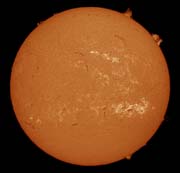
|
|
After a spell of cloudy days when anyway there was little happening on the Sun (checking on the Gong site), there were some clear spells on 25th November 2025. I had a lunch date, but just managed to squeeze these in around noon, in between passing clouds. No time for a white light close up. H-a with Acuter 40, white light Acuter with solar filter set removed, Herschel wedge without the -3.0 ND filter. Needed a Moon (-0.9 ND) filter to reduce the brightness a bit, but still ended up with 0.5 millisecond exposures! That prominence in the top left was even prettier the day before (Gong) but cloudy here. Camera Altair GPCAM3 178 M, G-band filter for white light. Processed in Autostakkert, Registax and Photoshop. |
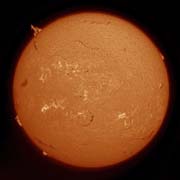
|
|
NGC 7039 is a scattered open cluster in Cygnus. Not particularly striking, but I chose it as a test target for my new Celestron Edge HD 8" telescope because of the rich star field to test the corners for round stars. And eventually (see the telescope page) all was well. Luminance 12 x 5 minutes, RGB each 5 x 5 minutes, all unbinned. 8th November 2025. |
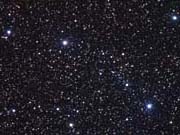 |
|
After several days (and nights!) of cloud, finally a clear morning on 7th November 2025. I had been keeping an eye on the 'Gong' site, and after a fairly quiet period noticed that a large sunspot group was rotating into view. And this is the result. A number of Aurora alerts ongoing, but so far it's been cloudy at night and anyway I was asleep! Hydrogen-alpha image using my Acuter 40 telescope, two sequences, one with longer exposures to bring up the faint prominences, then the earlier disc overlaid on that. White light with the solar filters removed from the Acuter, but this time I left the outer ring (from the etalon) in place to keep the telescope at f10, albeit with a 40mm instead of 80mm aperture. Sometimes that seems to give a slightly crisper image, maybe because the longer f-ratio has a more forgiving focal point. All using the Altair GPCAM3 128M monochrome camera. White light using an Altair 1 25" Herschel wedge and Altair G-band solar contrast filter. Processed with Autostakkert, Registax and Photoshop. |
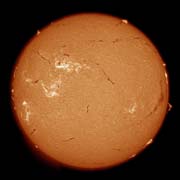
|
|
After several days of cloudy weather there was an opportunity to image the Sun on 11th October 2025. And with the large prominence it was quite a sight albeit with a small amount of haze reating a glow. Altair GPCAM3 178M as usual on the superb Acuter Elite Phoenix 40 Hydrogen Alpha Solar Scope. Full size.
The next day was clearer, and the prominence had modified. It now reminded me of the sadly missed 'Sycamore Gap' tree. Full size. |
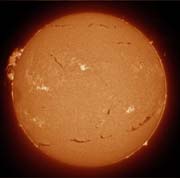
|
|
After the rash of Solar images (which no doubt will continue while the Sun is so active!) finally the first deep sky image of the 2025-26 season. LBN (Lynd's Bright Nebula) 468 is actually a dark nebula in the constellation of Draco. After a number of attempts which yielded poor data, I was able to capture this area on the night of 28th September 2025 - a fine clear steady sky following the Solar image below. I find it interesting to see how the light from the stars behind the dust clouds is dimmed and reddened, particularly in the thicker cloud regions. This image also contains the little variable nebula Gyulbudaghian's Nebula, just visible as a wispy arc at the upper left tip of the dust cloud. QSI683 with Starlight Xpress Lodestar guide camera and Active Optics unit, and Baader filters on TS Quad refractor (420mm fl). Luminance 10 x 10 minutes, RGB each 6 x 10 minutes, all binned 2x2. Full size |
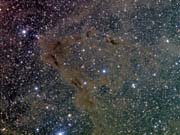 |
|
During my annual visit to the Equinox Star Party at Kelling Heath, Norfolk, there was a particularly nice sunny day on Friday 19th September. And I couldn't resist diving under a towel over my laptop to image the Sun with my Acuter Elite Phoenix 40 Solar Telescope. Numerous prominences and plenty of surface activity. A 1 minute avi with my Altair GPCAM3 178M camera on my USB3 laptop yielded 1513 frames from which I stacked the best 50 as chosen by Autostakkert. Further processing in Registax and Photoshop gave this result. While I was tidying up the image the proposed Moon Shot early next year was announced by NASA. So just to put things in perspective I couldn't resist adding the Earth and Moon to scale at scale orbital separation. The Sun might be a pretty average star, but it puts us in our place and this comparison (as I mentioned before) reminds me of Carl Sagan's wonderful Reflections on a 'Pale blue dot'. Full size This image appeared in the November 2025 Astronomy Now Gallery |
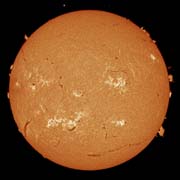 |
|
Although the filament mentioned in the August 3rd image below did create a decent prominence, I only saw it on the Gong system - cloudy at home. But 7th August was also interesting, so here is the result. Acuter40, Altair 178M camera, 31 frames from 297. Full size.
The seeing did not justify a close up, but the spots were worth a look. Acuter 40 hydrogen-alpha filters removed, so 80 mm objective, Altair 1.25" Herschel wedge, camera Altair 178M with Altair Solar contrast booster filter. 21 frames from 207. Full size. |
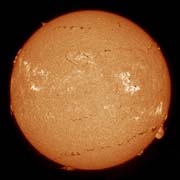
|
|
Cloud prevailed, but a brief clear patch on 6th June gave me an opportunity to image both the entire Sun and also have a go at white light granulation. Sun Acuter 40, Altair 178M camera, 20 from 200 frames, Autostakkert, Registax and Photoshop. |
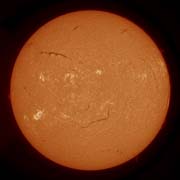 |
|
Then it clouded over, but cleared later, and I set up my Sharpstar 140 refractor with a full aperture Baader film filter. The usual 1 minute avi using my USB2 XP Observatory computer, and Altair Solar contrast booster filter on my Altair 178M camera. A Region of Interest including the main Sunspot area meant that the avi was of 460 frames, and I stacked 35 of them. This image is a crop from that image, twice full size, and I believe clearly shows granulation. I have since found that I can safely use my 1 1/4" Altair Herschel wedge with this telescope, so intend to try again, also with my 2.5x Televue . But then I will capture using my USB3 W7 laptop, and take a number of short Region of Interest avis, probably less than 10 seconds to freeze surface changes, and hope to see them when comparing final images. Watch this space! Full size |
 |
|
Another beautifully clear day on May 16th 2025, and spot 14087 is progressing nicely. Maybe we'll see an aurora this week, although with twilight for me, not so easy. 21 frames from 199, Altair GPCAM3 178M on Acuter 40. Autostakkert, Registax and Photoshop.
Sure enough that night there were strong alerts posted on the Aurorawatch site. But it was cloudy and I slept through (needed a good nights sleep for a chorus concert on 17th). |
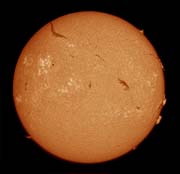
|
|
During the day on May 5th 2025 I saw this amazing prominence on the Gong site, but it was cloudy all day, although frustratingly clear further North! I really didn't want to miss it, but fortunately there were some clear patches around 6 pm which gave me the opportunity. Typically beautifully clear later of course. Anyway Altair 178M on Acuter 40. 30 frames from 179. Autostakkert, Registax and Photoshop. |
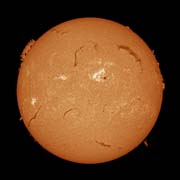 |
|
On May 1st 2025 (the day after I finished the NGC5754 image below), a filter which I had ordered arrived from Altair Astro. Its Solar Contrast Booster Filter, which is claimed to improve the definition of white light Solar images. As mentioned below I had recently purchased their 1.25" Herschel Wedge, and the filter seemed to be a suitable add on to further improve the images. The beautifully clear sky of the previous night continued into the afternoon, so more Solar fun, this time including the wedge and filter. There was a particularly large and active sunspot group, so worth closer attention. It had been suggested on Stargazers Lounge that the Acuter 40 could stand some magnification using a Barlow type magnifier. I already have a quite old 2x Barlow, and also by Televue a 2.5x Powermate and a 3x Barlow. Unfortunately it turned out that both the Televue items produced Newton's rings on Hydrogen-alpha images, but the older Barlow was ok. For white light all was well. So here we have a full Solar disc in both Hydrogen-alpha and white light, and sunspot closeups 2x H-a and 3x white light. All with the excellent Acuter Phoenix 40, the white light with the etalon unit removed and the blocking filter unit replaced by the Herschel Wedge and new filter on the camera, so using the full 80 mm aperture. In each case 20 to 30 frames from an avi of around 200 with the Altair 178M camera. I think there is some improvement in detail on the Hydrogen-alpha images, although given the limited 40 mm aperture this is always going to be problematical. Full size images here: White light spot (Mouseover the image for some interest) |
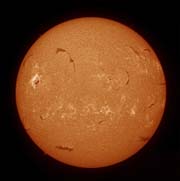
|
|
I still think my Acuter Elite Phoenix 40 is an excellent little scope, fighting well above its weight in H- alpha, and a reasonable 80mm ordinary refractor as well. And with all the bits needed for both applications , fantastic value for money. But I have had some problems with it, primarily occasional loss of tuning towards one side of the field of view, more readily obvious when imaging. Tests with a laser showed that the alignment of the focuser assembly was not fully concentric with the front of the tube. The corollary of which meant that the centre line of the objective and of course the front mounted etalon was not central to the blocking filter. I generally managed with a bit of fiddling to get things right as can be seen from my recent images. But shortly after I got the scope, out of interest I fixed the etalon to the front of my little TS65 Quad apo refractor. 65 mm aperture, 420mm focal length . A temporary albeit good fit using duct tape, but not a long term thing to envisage. It seemed to work well. So I bit the bullet! I had an aluminium disc which had
been languishing in my parts bin for several years, so time
it earned its keep. A few hours work on my ancient little
Myford lathe with the usual terrifying final turning of a
thread to screw in the etalon, and all was well. Phew! With
the dew shield removed the adapter is a snug fit on the Quad
and of course securely held in place with thumbscrews. It
was definitely worth it - the Solar image is fully tuned
everywhere on the 178 sensor, and with the only slightly
longer focal length of the quad still nicely fits in the
field of view. So here are some pics of the mod, and of
course the end result of the first imaging run on 1st April
2025. 44 frames from 220, stacked and waveletted in
Registax, finished in Photoshop. If anyone else has a TS65
Quad and wants to try this, sorry I won't be able to make
you an adapter, but will happily supply a suitable
drawing. |
|
|
After the disappointment of the cloudy partial eclipse below, the next day (30th March 2025) dawned beautifully clear and sunny. So I was able to capture this image. Not much in the way of prominences, but plenty surface activity. The active area with the large sun spot to the left side (AR14046) had emitted a substantial coronal mass ejection two days previously. If it is still as active and flares up again when pointing towards the Earth we might expect some beautiful Aurorae. Acuter 40, 41 frames from 200, stacked and waveletted in Registax, finished in Photoshop. |
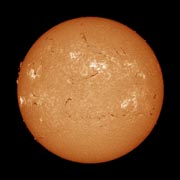 |
|
NGC 2903 is a large mag 8.8 galaxy in Leo, surprisingly not listed by Messier. I imaged it in 2005, but it was well overdue for a revisit to this impressive galaxy with its extended faint spiral arms. Although I've been lucky of late with several sunny days, clear moonless nights have been in very short supply this season. But a few in mid Spring gave me an opportunity. So data was collected on the nights of 28th February and 18th and 19th March 2025. QSI 683 with Starlight Xpress Active Optics unit on RC10 telescope. Luminance 22 x 10 minutes, RGB each 10 x 10 minutes, all binned 2x2 |
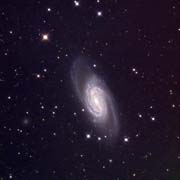 |
|
Another fine day and interesting prominences making it worth imaging. Acuter 40, 28 frames from 183 stack and initial process in Registax, finished in Photoshop. |
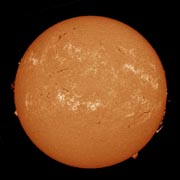 |
|
Cloudy again today, 17th March 2025, so a bit of fun with figures. These are the dimensions I used: Moon average distance 384,800 km And using part of my recent (March15th) Solar image here is the result, all to scale with the Moon at its average distance from us. You can just see it to the right of the Earth. Reminds me of Carl Sagan's Reflections on a 'Pale blue dot'. |
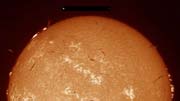 |
|
If the above makes you feel small,consider this. NML Cygni is possibly the largest known star. A red supergiant, about 5300 light years away in Cygnus. If in place of our Sun, its surface could extend past Jupiter! |
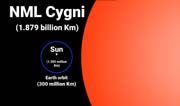 |
|
Viewing theSun in Hydrogen-alpha light requires the use of expensive precision filters. But of course ordinary white light is also of interest and easy to view safely using either specialised Solar film or a Herschel Wedge to dramatically reduce the brightness. I now have an Altair Astro Herschel Wedge - less prone to damage than Solar film and straightforward to use. And this is the result of using it on my Acuter 40 telescope with the H-a filter sets removed. I found that rather than completely removing the front adapter to reveal a full 80 mm aperture, the image was slightly crisper with it still in place giving a 50mm aperture. Probably due to the effective f8 ratio instead of the native f5. 30 frames from 191 with GPCAM3 178M stacked in Registax, final processing in Photoshop. As you can see there are numerous Sunspots which correspond to the active areas in the Hydrogen alpha image below. |
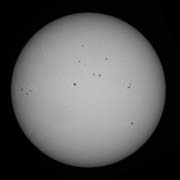 |
|
At the beginning of March 2025 I started having some problems with uneven tuning of my Acuter Solar scope. A couple of fine days gave me the opportunity to do some testing with limited success, but it appeared that the best area was right to one side of the imaging sensor. Then some tests with a laser showed that the focuser was angled by a small amount. I didn't know quite where the problem lay, but I tried a standard 2" to 1 1/4" adapter in place of the rotatable unit supplied with the scope, and then it all looked much better. That was on 8th March. There was an interesting prominence showing, but on the 9th it had developed considerably so here is the result. As you can see the disc is now tuned evenly (and was in the centre of the imaging sensor). Hopefully problem permanently solved! 30 from 114 frames (1 minute avi using the ObservatoryWindows XP computer for convenience - I had been doing a lot of testing!) Stacked in Registax, final processing in Photoshop. Full size |
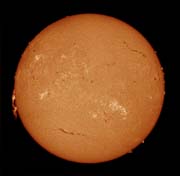 |
|
After many years of using Baader Solar Film for white light images, with the Acuter being an 'all in one' telescope, I finally invested in a 1 1/4 inch Herschel wedge which nicely fits in the carry case. Safer and more convenient than film. And this is an image taken with that system on 6th March 2025 . The wedge will just safely go on my TMB 105 which will give a crisper image and of course is a colour corrected triplet. Unfortunately because my nice TS65 Quad is of Petzval construction, direct sunlight could damage the built in flattener lens, so no wedge use there. As the Acuter is an achromat, I intend to use a colour, perhaps narrowband filter in future to improve definition. But this will do for a start. Full size |
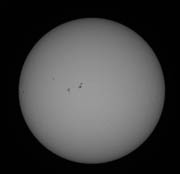 |
|
These three galaxies in Leo are quite faint, but a clear night (27th January 2025) following the Solar imaging below gave me an opportunity to image them. From bottom to top they are respectively mag 11.2 NGC 2964 , mag 11.9 NGC 2968 and mag 13.7 NGC 2970. As I say, faint, but interestingly different, and there is a faint tidal tail joining 2968 and 2970. Unfortunately barely visible in this image - my skies are rarely clear and dark enough, but it has been reported elsewhere and there is a good image on Stargazers Lounge here. QSI 683 on RC10. Luminance 12 x 15 minutes, RGB each 6 x 15 minutes. |
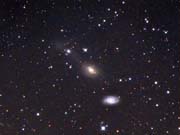 |
|
When I first bought my Acuter Elite Phoenix 40 I tried mounting the etalon on my TS65 Quad - it fitted snugly with the dew shield removed and was safely taped on with duct tape. It seemed at that time to give a slightly more contrasty image than the Acuter telescope, but after changing the camera front window there seemed little to choose between them. Anyway I had another play on 27th February 2025 when I found I could adjust the tuning - with the main body of the etalon taped to the quad it was still possible to alter the tuning with the thin rim. But again there was very little difference apart from a slightly bigger image due to the longer (420 mm vs 400 mm) focal length, so I won't be going to the trouble of making a proper adapter. Anyway, I can't use my Herschel wedge with the Quad because of the location of the flattener lens. I had bought a 1.25 inch wedge from Altair Astro, and it fits nicely in the Acuter case. So all I need in one place (apart from a mount of course!) Here is the image. Not much in the way of prominences, but a fine scattering of filaments and active areas. 34 subs out of 120, stacked in Registax, finished in Photoshop. Full size |
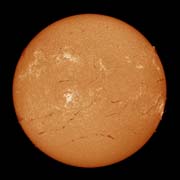 |
|
Sun Westering when the clouds cleared, so altitude only 15 degrees. But I knew there was a good prominence, so worth a go. Acuter 40, 33 subs from 107, processed in Registax and Photoshop. |
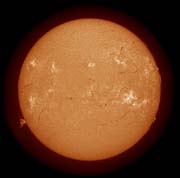 |
|
With the dismal weather late Autumn 2024, this is the first deep sky image since mid October! Here are two Sharpless objects, SH280 and 282.. Quite close to each other in Monoceros just West of M42 and not often imaged. Took a while to capture because of the poor weather recently, initial Hydrogen alpha from 7th January 2025, but I managed to finish it off with data from the beautifully clear night of 29th January. So in total 17 x 15 minutes Hydrogen Alpha to capture these relatively faint objects, 5 x 15 minutes each Oxygen III and Sulphur II. In the end there was very little of those colours, so H-a predominates. LRGB each 6 x 5 minutes, all processed and combined in Photoshop with StarNet used to remove the stars from the narrowband grouping before combining with the LRGB starfield. Sh282 is the lower of the two gas clouds. The small cluster just above SH282 is Collinder 110. All binned 2x2 with QSI683 camera on TS65 Quad telescope. Full size. |
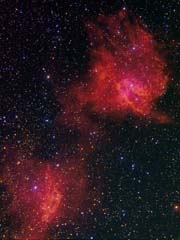 |
|
The camera I use for my Solar images is an Altair GPCAM3 178M which nicely encompasses the Sun on my Solar H-alpha telescope, formerly the Solarview50, now the Acuter Phoenix 40 which is performing superbly. But in the excellent review which helped me decide on the Acuter, Mario had a problem which was cured by the addition of a UV/IR filter. As I stated below I wasn't absolutely certain whether I needed one, but Altair provide a custom filter for my camera so I ordered one anyway. It duly arrived and clear days on 15th and 16th January 2025 gave me an opportunity to perform final tests. Because as I later discovered there was already an IR blocking filter on my telescope diagonal filter I wasn't sure if the new one would make much difference. What I did discover from the review was that Mario's instrument did not initially have an IR blocker on its diagonal, hence his problems. My camera already had a filter on the front, described as 'Removable Clear blocking filter with AR anti-reflection coatings 350-1050nm'. The above of these two images was taken on January 16th 2025 using that filter. Then I removed it and replaced it with the new filter with the result of the lower image. AR coated 380-1100nm . A definite improvement in contrast. Also the image on the monitor was much brighter - I could reduce the exposure time by almost 2/3. I can only assume that the new filter is better suited to the Hydrogen-alpha wavelength, or it may be that the shorter exposure times have contributed to the better quality image by better 'freezing' of the seeing. But whatever the reason, I will always use it for this purpose. These images were the result of align and stack 33 of 107 frames in Registax 6, identical processing, but no post processing, so a fair comparison. |
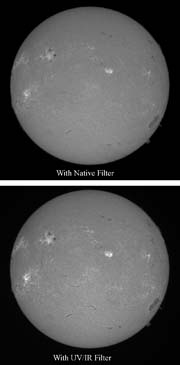 |
|
So here is the final fully processed result. I show both monochrome and coloured images - many people prefer the monochrome which I agree tends better to show the contrast between surface features. Although using the Acuter filters on my TSQuad telescope initially appeared superior, when the new filter was fitted to my camera there was no discernible improvement, so I will happily stick with the Acuter telescope.
|
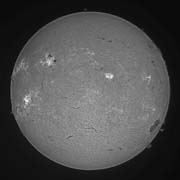
|
|
As you can see (a couple of entries below) when I compared the latest 60mm Ha image against one from the 'Gong' Learmonth site, I realised that a lot of surface detail, particularly plages, was missing. Helmut (Solarscope) wondered if the blocking filter needed adjusting. But I'd had enough - more trial and error with no guarantee of success, and time marches on. He took everything back with no further charges, and after only a small amount of soul searching I ordered an Acuter 40. It arrived on the next day (9th January) from FLO, but too late to do anything but a quick look - the Sun was well down. Looking promising, and the following day cleared nicely after earlier clouds. So I did some visual - very nice, then took some images with my Altair GPCAM3 178M camera. But it seemed that as for Mario Stroblmayr, in his review there was some leakage. The images would not come into really crisp focus. So anyway I ordered a UV/IR filter to try. That image was taken with the Sun near its maximum altitude at 13 degrees. But although time was getting on with the Sun lowering, I had time to fit the etalon to the front of my TSQuad (65mm, 420 mm fl), dew shield removed. It fitted nice and square without the large screw adapter, but when taped on of course I couldn't tune it. So set the tuning ring about half way then fitted it. And took an image when the Sun was at an altitude of around 10 degrees. I wasn't really expecting much, but certainly the image looked crisper on the computer screen. So I'm showing four images. The first is the Australia Learmonth Observatory image for comparison. Then mine from the Acuter telescope, third one mine using the TSQuad. The Quad image needed longer exposures in the avi - possibly because lower in the sky. But seemed to focus better with more contrast, maybe generally less leakage passed through due to the accurate triplet lens (and the built in flattener). Both those images are stacks of 33 frames in Registax and waveletted identically. No further processing, which done in Photoshop improves them further, but for accurate comparison..... The fourth image is the TSquad one with more processing, full size and coloured. So despite the possible need for a UV/IR filter, I'm seriously impressed with the performance of this little scope. Once I've tried the UV/IR filter on the Acuter scope, depending on the result I might make an adapter to use the etalon etc. on my TSQuad. A couple of days later. The UV/IR filter arrived but not tested yet. In the meantime I found that the blocking diagonal already has an IR flter installed. So there may be no improvement. Watch this space! |
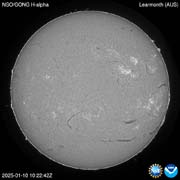
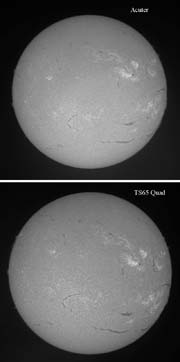
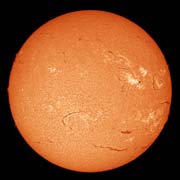 |
|
Another trial of the second 60mm solar filter was on 2nd January 2025. Around noon, so as high as the Sun gets, and I was reasonably pleased with the result. Until I compared it with an internet image from the 'Gong' Learmonth, Australia site, showing the same area. As can be seen my image only captured part of the surface features despite careful tuning,which was difficult anyway because this second filter had an extremely stiff tuning knob. It was also necessary during processing heavily to contrast the image to show the features. All the Hydrogen-alpha equipment is going back to the Isle of Man, but I've just about had it after years of to-ing and fro-ing. I'll possibly give up and look for something newer and more mainstream, although the Solarscope products are generally highly thought of. Certainly my Solarview50 worked very well before it was damaged in 2021. |
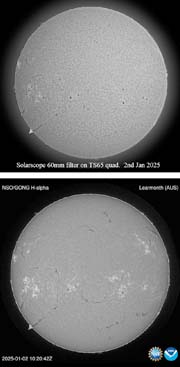 |
|
Long period comet C2023 A3 Tsuchinshan-ATLAS became visible in the Northern hemisphere during mid October 2024 and caused quite a stir. The first opportunity I had to image it was on 14th October when a clear night was forecast. The day indeed was beautifully cloudless, but cloud was building to the West as the Sun set. I moved (over our back fence into a field!) to where I had a clear Western horizon, and started looking. Arcturus was very useful to focus my camera, and from Skymap I had an idea of where to look. At no time was the comet visible to the naked eye - a bright Moon and thin cloud killed that, but eventually I found it with 8x42 binos. It was a different story getting it on my camera chip. Canon 700D tracking on a Star Adventurer with 70-200 L lens set at 100mm. Had I realised the tail was so long I would have focused the lens at the 70mm zoom setting, but having eventually located the comet, no way was I going to go back to Arcturus to refocus - this particular lens focus changes slightly with different zoom settings. By this time (7:50 pm BST) the comet was getting very low in the West - around 6 degrees altitude, so in very murky sky lit up by the bright 90% waxing Moon in the East. Anyway after all the photos taken just to find the comet, this is the heavily processed result of 8 subs, each 20 seconds at ISO400 taken around 7.50 pm (Summer Time). Colour obviously badly affected by moonlight, thin cloud and very low altitude. The tail is about 9 degrees, and I calculate its length at around 7 million miles. Wow! When I tried to match the star field with Skymap I was foxed by the bright fuzzy star inside the tail. Until I realised it was Messier 5. Quite a coincidence! Larger image |
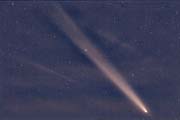 |
|
After I had posted the above on Stargazers Lounge, Paul Clark mentioned that I'd captured the anti-tail. As it happened i had a further 5 subs taken after the above with the comet head higher in relation to the image border. so I processed them, and sure enough a very faint anti-tail is just visible |
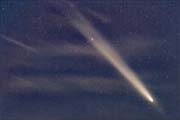 |
|
Well, how lucky can you get! Only 3 days after the previous Aurora there was another strong outburst. This time, there was only a diffuse show in the North. Larger image. |
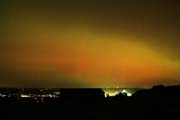 |
|
But when I returned from the North facing road view and went into my back South facing garden it was all happening! This view to the East. Larger image.
This to the West. Larger image.
This to the South. Larger image.
This also to the South but more overhead - the Summer triangle immersed in the aurora. 'Mouseover' the medium size for some identification. Larger image. |
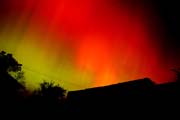
|
|
These photos, the best of the many I took, and of course which have been processed in Photoshop to make the colours really shine, were all taken around 10 pm. But as can be seen from this chart, the aurora became even stronger later. I did have another look before going to bed around midnight, and the intensity had reduced, but I missed the later peak. Nevertheless I was very happy with what I did see - the red colour, particularly in the East facing image was clearly visible to the naked eye. |
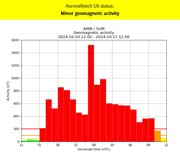 |
|
In early May 2024 NOAA (National Oceanic and Atmospheric Administration) Space Weather Prediction Center (SWPC) issued a Geomagnetic Severe Storm Warning for Friday, May 10th. Additional Solar eruptions were expected to cause geomagnetic storm conditions to persist through the weekend. This was the most powerful storm for many years, and was likely to produce extensive aurorae covering the whole of the British Isles, even visible further South. For once the skies were decently clear on the evening of the 10th so I had hopes for seeing something. And I wasn't disappointed! I live on a reasonably dark road above Hexham Northumberland. Northerly views are somewhat obscured by trees and hedges, but there is a farm gate around 100 yards along with an open view North. So I set up my Canon 700D there and waited. Nothing seemed to be happening around 10:43 pm, just the usual twilight and sunset glow. |
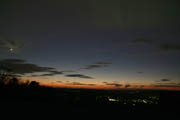 |
|
But then what appeared to be a band of thin cloud overhead started to show a bit of colour, and soon brightened to the point that it was showing colour on my camera live view screen. At that stage it was just a narrow band. Of course I hadn't expected the display to be so high, and as you can see overhead telephone and power lines got in the way. I've left them in on these first two aurora images. Larger images: upper image, lower image. |
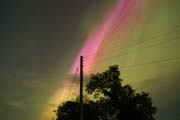
|
|
The third one was also from that location, but I Photoshopped the lines out. Then I moved to my back garden where the last one was taken - again I had to Photoshop power lines out. In these two images they were low down anyway. You can just see Corona Borealis in the top left corner of the last one - more visible on the larger version. Although the aurora alert continued very strong, clouds arrived before midnight, so that was that. But it was a magnificent spectacle. Larger images: upper image, lower image. All the aurora photos were 8 seconds at ISO400 with 17 mm lens at f3.5, and have of course been Photoshopped to bring out the colours. |

|
|
The next day Aurorawatch showed that the emissions got even stronger later. I hoped there would be another opportunity that night, although the forecast was not promising, and indeed there was nothing of any consequence. |
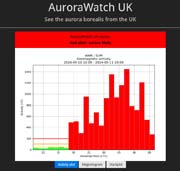 |
|
Magnitude 10.7 NGC 5474 is a small (4.7 arc-minutes) disturbed galaxy in Ursa Major, close to the well known Messier 101. I browsed the 'net for images of it, and came across this beautiful rendering by Cedric Ragenaud. On Astrobin here. You will see that this image is almost 21 hours of data using a one-shot colour camera in France, or possibly a remote Observatory in very good skies. Most other images on the 'net are inferior. But at my latitude this time of year it culminates almost directly overhead, so despite its relative faintness I deemed it a worthwhile target. BUT This 2023-24 season has had very few clear stable nights, and the end not only of April but of fully dark skies was fast approaching. Out of three nights of trying, only one, the night of 30th April was clear enough to capture some moderately decent data. Even then seeing was poor and there were occasional thin clouds which spoiled a number of subs. So in the end I had to settle for 8 Luminance and 4 each RGB subs, all 10 minutes binned 2x2. QSI683 on RC10. So a total time of a little over three hours. No wonder my image is a very poor relation of Cedric's beauty. 'Noisy', lacking detail and the unexpectedly faint outlying areas only just visible. Hopefully I will be able to try again in early Spring 2025 with more time and better conditions. We shall see .... maybe! |
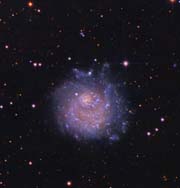
|
|
Despite the generally poor weather this Spring, another clear night was forecast for 9th April, so I tackled the unusual and seldom imaged mag 9.9 lenticular galaxy NGC 4753 in Virgo. This recently was featured as a Gemini South telescope image, described as a 'Train Wreck' galaxy! With my modest equipment and less than pristine skies, I did not expect too much, but managed to bring up the unusual dust lanes, so reasonably pleased with the image. QSI 683 on RC10 with SX AO unit. Luminance 15 x 10 minutes, RGB each 5 x 10 minutes all binned 2x2. |
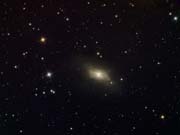 |
|
The Leo Trio is of course well known and a favourite target. But the tail of stars spreading East from NGC3628 is on a different level altogether. I've always wanted to capture it - there are some beautiful images around. But I suspect the vast majority were taken under very dark clean skies. The UK weather this Spring has been dreadful - wet and cloudy almost all the time. But a clear sky was forecast for 30th March even here in North East England. The Moon became obtrusive by 3 am on 31st, but I managed to collect 17 Luminance and 6 each RGB subs, all 10 minutes, binned 2x2 with my QSI683 camera on my TMB 105 refractor (650 mm fl) . Unfortunately although the image showed the tail, it had to be highly stretched and was very 'noisy'. I don't think I've had a single night this season with steady transparent Arctic air. Sometimes I wonder if it's worth continuing imaging the way the weather is going, particularly when I look at an image I took of NGC3628 in 2010. Maybe more data will help to reduce the noise, but the forecast for the next week or so is also rubbish, and before we know it the twilight nights will be here. BUT... there was a decently clear night on 7th April, and although windy the shelter of my Obsy dome and the high speed Starlight Xpress guider took care of that. So I was able to capture another 16 luminance subs, giving a total of 33 x 10 minutes binned 2x2. I also got a bit more colour data, but have stayed with the original which for some reason came out better with minor tweaks. So at last I can just show the tail without too much noise. That's that for the tail in my muzzy UK sky. Not the best of the Trio, but they would be better with my longer focal length SharpStar 140. Or even a mosaic with the 2 metre RC10 to really grab the galaxy details. Maybe next year.... |
|
|
NGC 3675 is an infrequently imaged 'flocullent'galaxy in Ursa Major. It is quite small in the sky, and at 10th magnitude not particularly bright overall but has a bright core and considerable dusty areas. A clear night was forecast for 3rd March 2024, but did not clear for me until around 11 pm, by which time a bright aurora had been and gone unseen - typical! So with the clear window cut short this is the result of around 5 hours of data. Luminance 11 x 10 minutes, RGB each 7 x 10 minutes. QSI683 on RC10 with SX AO unit, all binned 2x2. A somewhat 'twinkly' sky so not the best of seeing and some loss of fine detail. A good guide star was available but using it put the galaxy off centre, so this is cropped from the full image. North is up. What appears to be a processing artifact - a faint shadow visible to the upper left of the galaxy, is in fact a broad band of dust, more clearly visible in images taken with larger telescopes under better skies than mine, for example this image by Adam Block. Full size (cropped) |
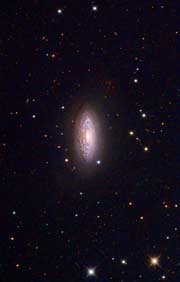 |
|
Magnitude 10.3 galaxy NGC 2336 in Camelopardalis as I stated in a much earlier image in 2007, is one of the nearest reasonably sized galaxies to the North Pole, lying only 10 degrees from it, so accessible all the year round for Northern observers. Quite small in the sky at 7 x 4 arc-minutes, but physically very big - approximately 200,000 light years across, twice the size of our own Milky Way galaxy. As I say, a long time since that earlier image and well overdue for an update. The tiny galaxy just above the main one is mag 17.4 PGC 213387. Although January and February 2024 were predominantly cloudy, the nights of 11th and 12th February relented, although with occasional cloud and slight haze which probably contributed to the halos on the brighter stars. But I was able to collect a worthwhile amount of data with this pleasing result. Luminance 22 x 10 minutes, RGB each 13 x 10 minutes. All binned 2x2, QSI 683 on RC10 with SX AO unit. Full size |
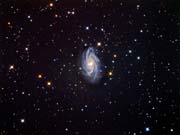 |
|
This emission nebula, Sharpless 284 in Monoceros is fairly large - the central circular area is similar in diameter to the Moon, and is accompanied by other areas of emission. But is faint and requires quite a lot of exposure, not easily acquired in England of late, particularly the very cloudy and stormy weather in December and January! Fortunately a few clear nights in early January 2024 although limited by time constraints due to other engagements and the low elevation of the target here in NE England gave me an opportunity and this is the result. Imaged over nights of the 5th, 14th and 18th of January. Narrowband Ha 22 x 10 minutes, OIII and SII 12 x 10 minutes. Also LRGB for the stars, Luminance 10 x 3 minutes, RGB each 4 x 3 minutes. All binned 2x2 with QSI683 camera and Starlight Xpress AO on TS65 quad. Processed as Hubble palette (SHO) then some quite enjoyable messing about to end up with the final colours. The original stars in the SHO image were removed using StarNet, and later replaced with the LRGB stars. Full Size This image appeared in the March 2024 Astronomy Now Gallery |
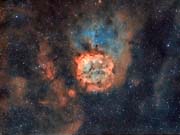 |
|
In early October 2023 a trip to Kelling Heath Star Party was followed immediately by a few days at Calvert Trust Kielder. Unfortunately for both events there was only one reasonably clear night, and although the sky is nicely dark at both locations, it was never clean - always thin high haze. I already had targets in mind and succeeded in getting reasonable images of both, but not as clearly defined or contrasty as would have been possible under better conditions. |
|
|
This is Barnard 169-71 dark nebula in Cepheus. This was the Kelling Heath target. The object is quite faint anyway, and the conditions didn't help, but at least it is visible. The 'squiggle' in the top left corner is seperately catalogued as B173-4. I have a closer image of this from 2013 here. I also have an image of the main target taken under the clear skies of Les Granges in France in 2008, but it does not include B173-4. This image comprises Luminance 15 x 10 minutes unbinned, RGB each 10 x 5 minutes binned 2x2. QSI 683 on TS65 quad with SX AO unit.. Larger image |
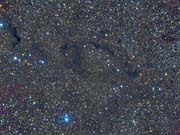 |
|
Also in Cepheus, Sharpless 154 is a hydrogen alpha region. Imaged from Kielder, again faint. There was very little OIII and no SII to be seen, so on returning home I gathered RGB data for star colours and added the H-a as a layer. The small open cluster in the lower left corner is NGC 7419. H-alpha 15 x 10 minutes, Luminance 10 x 2 minutes, RGB each 6 x 2 minutes, all binned 2x2. QSI683 on TMB105 with SX AO unit. Remains high for some months, so if possible I would like to gather more H-a data. The slight haze and stretching required has left it a bit 'noisy'. Full size |
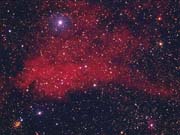 |
|
Footnote: The last of the data for Sharpless 154 was gathered on the night of 21st October. And was the last imaging for some time. I ruptured the Achilles tendon in my left leg the following afternoon at a friend's birthday party ceilidh. This severely limited my activity for three weeks due to wearing a non load bearing cast, and indeed I missed a couple of clear nights and a bright aurora shortly afterwards. But once in a load bearing boot I was more active although still unable to drive for several weeks. |
 |
|
For many years my image of M11 was this monochrome one from 2003. About time it was replaced! June of course has very bright twilight skies here, and July 2023 was the wettest on record. But a couple of clear nights in August gave me an opportunity. 11th wasn't too bad although clouds moved in, but the night of 15th although not forecast was an absolute cracker - Milky Way beautifully clear across the sky. So although M11 is quite low and was past the meridian by full darkness on both nights, I was able to acquire decent data and here is the result. Luminance 17 x 5 minutes, RGB each 8 x 5 minutes all unbinned. QSI 683 on RC10 with SX AO unit. |
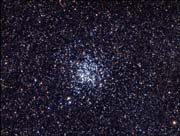 |
|
Again Astronomical twilight on a clear night of 24th May 2023, BUT a type 2 supernova had been spotted in Messier 101. I hadn't imaged this galaxy since 2006, but of course notwithstanding the lighter sky and low surface brightness the supernova had to be imaged! It was discovered on May 19th by Japanese astronomer Koichi Itagaki. At that time it was magnitude 14.9, but in this image, nearer Mag 11. So here is the result. QSI683 on RC10. Luminance 11 x 5 minutes, RGB each 5 x 5 minutes, all binned 2x2 |
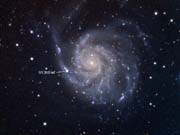 |
|
At this time there is a galaxy competition running on Stargazers Lounge. Without repeating some earlier images I didn't have much to offer, although I did enter my Hickson 68 shot from April (below). I don't really expect it to win, but I also wanted to enter a shot of M81 and M82 in the same frame - they would fit nicely in the field of view of my SharpStar 140. The weather did not play fair until 9th May 2023, by this time into Astronomical twilight, but a nice clear night, so this is the result. M82 of course is an active galaxy with huge hydrogen outbursts, well seen in my image from 2012. M81 also has some active regions, so in addtion to the usual RGB colour channels I also captured Hydrogen-alpha. So two versions are presented here, one standard RGB, one with the Ha added. QSI 683 on SharpStar140. Luminance 13 x 5 minutes, RGB each 5 x 5 mins, Ha 9 x 10 minutes, all binned 2x2. The faint fuzzy area just above M81 isn't 'noise', it's the very diffuse dwarf galaxy Holmberg IX (UGC 5336) magnitude quoted between 14.4 and 16.5, rather lost in the twilight glow. I might repeat this combination next Season when I will have time to expose unbinned in a fully dark sky for finer detail, possibly also with Galactic cirrus. |
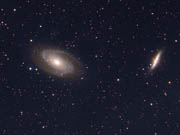
|
|
As I said in my offering below I rarely image the Moon. But typically we've had two clear nights on the trot with the very bright Moon near my current deep sky target. And when you consider how much less hassle it is to get a few minutes of Moon instead of hours for deep sky it seems daft not to make use of the opportunity! I particularly wanted to get a reasonable shot of the interesting Schröter's Valley area, not visited for many years, so I set to on both 2nd and 3rd of April.
Much better seeing on 2nd, so the (full size) disc is presented here along with an enhanced double sized clip of Schröter's. Full disc a mosaic of 3 image sets. Altair GPCAM3 (mono) on SharpStar 140 refractor. At my location in the lee of the Pennines the seeing is rarely stable. Maybe next time round my 10" RC will be on the mount and I'll give it a go for some close ups. I don't think I'll try for a full disc - it would need a huge mosaic! Full size Moon (1.1MB)
Schröter's a bit over shadowed, so another look on 3rd, this time a 'Region of Interest' image so a lot more subs, but seeing not so good. But here it is, again double sized, for completeness.
Click on the thumbnails for full size Schröter's. |
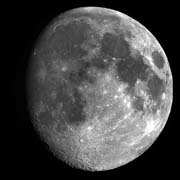
|
|
Unusual for me, I rarely image the Moon now. But 27th March 2023 was a gorgeous day after weeks of cloud, in the early evening the Moon was high and bright and seeing quite good, so I couldn't resist it. And wanted to see how my almost new SharpStar 140 would cope with the bright Moon. Which I think you'll agree it has done so admirably. This is a mosaic of two images, each the result of stacking 25 from just over 100 frames using my monochrome GPCAM3. The full size image is 700Kb but well worth a look for fine detail. 'Mouseover' the medium size image for names of numerous features. |
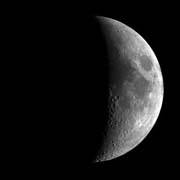 |
|
NGC3338 is an attractive 10.9 magnitude spiral galaxy in Leo, usually overlooked in favour of its nearby famous and brighter Messier list neighbours. But worth a look as shown by this excellent Adam Block image. A much awaited clear night on 14th March initially looked promising, but reflections between snow on the ground and moisture in the air which eventually formed freezing fog, allied to poor seeing to spoil contrast and detail, producing a rather disappointing 'noisy' image. But this season has been so poor that anything is better than nothing! QSI 683 on RC10. Luminance 2 x 10 mins + 6 x 15 mins, RGB each 1 x 10 mins + 4 x 15 mins, all binned 2x2. |
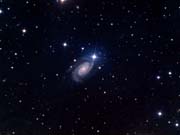 |
|
Comet C 2022 E3 ZTF is a very long period comet, with an approximately 50,000 year period. So last seen a very long time ago! Nicely placed high in the sky, except that in mid January although a nice clear night it was hanging in the East where I have light pollution from the Tyne Valley. 9 x 2 minute subs at ISO 3200, darks and flats with modded Canon 700D on TS65 quad on early 17th January . Processed in Deep Sky Stacker and Photoshop. Clearly the light pollution created a lot of noise when stretched. More subs might help a bit. And I didn't get the angle right to capture more of the tail even though it is very faint. Must do better! In 10 days or so it will culminate due North at 66 deg altitude for me around 4 am, and is forecast to be brighter. So another late night if the weather gods are kind. Larger image. |
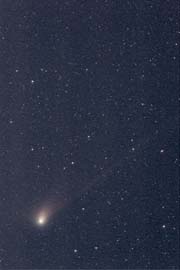 |
|
I first attempted the very faint HFG1, PN G136.3+05.5 in Cassiopeia at the November Galloway Star Party 2022. Discovered in 1982, full name Heckathorn-Fesen-Gull 1. Such an interesting target, so I persevered with it and despite the awful weather recently I've managed to acquire more data. I used a different off-axis guide star than for Galloway, so had to start again from scratch. Bicolour, Ha and OIII. SII was pretty well negligible so ignored. Eventually I managed 23 H-alpha and 22 OIII 20 minute subs over a number of nights, some crisper than others. QSI 683 on SharpStar 140 refractor with TS2 flattener and Starlight Xpress AO unit. Last batch on 16th-17th January 2023. That set slightly compromised by extra sky glow due to snow covered ground. I also then collected data for the background stars, an image consisting of 5 x 2 minutes each IR, Red, Green and Blue. So I used Steve Cannistra's method mainly to process the two colours, along with a bit more juggling, in particular using StarNet++ to remove the stars. Then added the RGB image for stars. And this is the best I can get. My skies here are simply not dark and clean enough to get the best of this very faint target. But c'est las vie! HFG1 is moving relatively quickly so the bow shock wave is clearly visible as is a tail of Hydrogen gas. The smaller planetary nebula is magnitude 14.3 PK 136+ 4.1 |
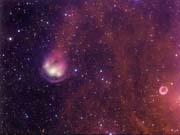 |
|
But although lower in the sky than below, in the early hours of 8th December (starting at 0454) Mars was occulted by a Full Moon. Cloudy earlier, but cleared by 0230, so I was able to get set up. Still poor seeing, so I settled for using the Sharpstar again. A 7.9 Mb mp4 file with music is here. |
|
|
Because I took the video as a series of 1 second sequences and linked them together to produce the final video, each sequence contained approximately 25 individual frames. The relative movement between the Moon and Mars in each sequence was very small, so I was able to process individual sequences to produce clearer defined stills. Here are 'before' and 'after'. Mars enhanced in Photoshop. Click on the thumbnail for full size. If you look closely at Mars you can see the change in surface markings due to the rotation of the planet - approximately an hour elapsed between the two images. This image appeared in the February 2023 Astronomy Now Gallery |
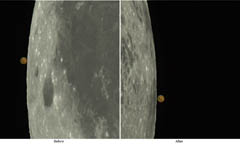 |
|
In early December 2022 Mars made its close approach of this apparition to Earth. Not as large as 2020 (around 17 arc-secs) but higher, approaching 60 degrees altitude for me. Closest approach was on 1st December, unfortunately that coincided with a continuous spell of cloudy weather. But 6th December was a clear night. Seeing was poor, and this image was taken with my GPCAM2 colour camera and 2.5x Powermate on my Sharpstar 140 telescope. Enlarged to twice size. Click on the thumbnail for full size (not much bigger!) The excellent Mars Previewer program image is here for comparison. |
 |
|
My venerable TMB105 telescope unfortunately got water between the triplet elements in early September (2022). When dried out there were watermarks on the internal surfaces. I didn't know where to start dismantling it, but was very fortunate in meeting the much respected optician Es Reid while at the September Kelling Heath Star Party, and he kindly agreed to look at it. Duly posted to him (I didn't have it with me) and returned a couple of weeks later on 18th October beautifully clean and perfectly collimated. 1000 thanks, Es. The usual cloudy weather prevailed, although the occasional glimpse of stars confirmed the collimation. But the night of 29th October was clear later in the evening long enough for me to image the bright (mag 6.4) open cluster NGC 1647 situated between the 'horns' of the Bull in Taurus. QSI 683 on TMB105 with SX AO and TSFLAT2. Luminance 9 x 5 minutes, RGB each 5 x 5 minutes, all unbinned. North is up, vertically framed to obtain a suitable off-axis guide star. |
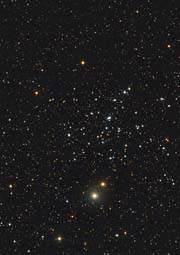 |
|
The bright open cluster NGC7789 in Cassiopeia is known by the popular name of 'Caroline's Rose' after its discovery in 1783 by Caroline Herschel. I've already imaged this twice before, here in 2016 and here in 2010, but it seemed a suitable target properly to test my new SharpStar 140 refractor with RGB filters. An attempt while at Kielder was disappointing - I think due to poor seeing and a tricky off axis guide star (2 stars in the guide frame), but on returning home the evening of Friday 30th September was beautifully clear, and I was able to capture images with a better guide star before the clouds returned later. So this is the result of 10 x 2 minutes luminance and 5 x 2 minutes each RGB, all unbinned with my QSI 683 camera, TS FLAT2 and SX AO unit. |
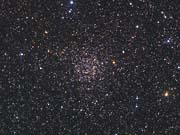 |
|
Sharpless 124 is an emission nebula in Cygnus. Although there was a bright (86%) Moon in the sky on 13th September 2022, it was nicely clear and the target was near the zenith, so worth a try with narrow band filters. And my new SharpStar telescope was sitting there asking to be used! The target itself is relatively small, but lying in an area of nebulosity so worth imaging with the larger field of view of the big refractor. There was almost no OIII or SII emission, so this is an SHO palette modified with selective colour adjustments in Photoshop. Luminance 10 x 10 minutes H-alpha, OxygenIII and SulphurII each 5 x 10 minutes. Full size |
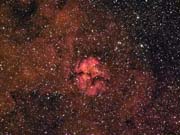 |
|
This open cluster, IC 4756 in Serpens is large (40 arc-min) and bright (mag 4.6) but not often imaged, probably because it's an IC object. But a binocular target as well as suitable for wide-ish field imaging. As it happens on the night of 27th August 2022 I already had my TMB 105 (4", 650 mm fl) refractor on my mount, so took advantage of the first clear night for ages to image this object. Fairly low and past the meridian, so not much time for capture, and I lost 9 subs at the start of the session - wrong spacing for the flattener, and didn't notice the edge distortions when originally focusing - oops! But ended up with 9 x 5 minute luminance and 4 each x 5 minute RGB, all unbinned with my QSI 683 camera. Might go for a bit more data, but I doubt it will make much difference. And the even bigger and brighter IC 4665 is in the same area, so worth a visit before the year progresses much further. IF I get another clear night in time! Larger image |
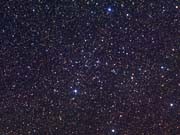 |
|
I imaged the ancient globular cluster Messier 56 in 2003 But have never revisited it until now! The night of 4th May 2022 was beautifully clear, but running out of dark sky for the year. Nevertheless although at first there was a 22% crescent Moon it was well separated from M56 and there was plenty of Astronomical twilight either side of full darkness. So I decided to image it. In Lyra, so rising in the East at this time of the year. Because of the clear air the usual light pollution in my Eastern sky was very low, but the 'seeing' was poor, so despite a bright guide star allowing me to operate the SX AO unit at 0.1 second frames, resolution was limited. I will certainly try to revisit the target in early Autumn when it will be much higher in the sky. QSI 683 on RC10. Luminance 14 x 5 minutes, RGB each 5 x 5 minutes, all binned 2x2. To use a suitable guide star, the cluster appeared towards the bottom of the vertical image frame, so it has been cropped accordingly. |
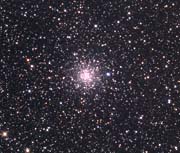 |
|
On 14th April 2021 I imaged Messier 60 and it's attractive neighbour galaxy NGC 4647. And was fortunate in having the image published in Astronomy Now. April 2022 was pretty well a disaster month - although unseasonably dry, the high pressure systems that kept away the rain also contained considerable cloud, so a very disappointing end to the galaxy season at my latitude. However the night of 27th April promised a few hours of clear sky and I was all set to do some imaging when I was advised of a supernova in NGC 4647. SN 2022hrs, discovered by amateur astronomer Koichi Itagaki on April 16. The discovery magnitude was around 15, but continued to brighten. I was able to acquire 8 x 10 minute luminance frames but only 1 each RGB before the clouds returned. And this is the result. I was able to use the colour information from my original image, and the supernova colour from the single RGB frames. QSI 683 on RC10 with SX AO unit. When I examined an individual luminance frame it was apparent that the magnitude of the supernova was in the region of 11.6. When you consider that the listed magnitude for the entire galaxy is 11.4 it is apparent that the supernova almost completely outshone its parent galaxy. Must have been quite a sight for any being living in that galaxy! |
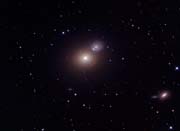 |
|
And here are full size crops before and after - the supernova is unmissable! |
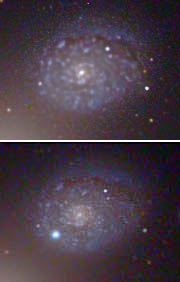 |
|
I expect most of us have marvelled at the recently released JWST alignment evaluation image. The telescope is really starting to show that it is worth the billions spent on it. There are a couple of good Youtube videos - one from NASA here, and a well presented one about the alignment process here. Worth watching! It identifies the subject star - a relatively nondescript star in Draco. In fact the guy is quite dismissive of it. But as a challenge I looked it up, in Skymap anyway it is listed in the Tycho catalogue as mag 10.96 TYC 4212-1079-1. And yes, pretty unremarkable. Interestingly it is only 50 arc-minutes South of the Cat's Eye nebula, NGC 6543.
So before this little star fades into distant memory, I thought I'd have a go at imaging it on the night of 26th March 2022. A few nearby objects also annotated here. Luminance 9 x 5 minutes, RGB each 4 x 5 minutes all unbinned. QSI 683 on Meade 127 refractor with TSFLAT2 and SX AO unit.. At that 950 mm focal length of course there is no detail possible of the Cat's Eye. But little TYC 4212-1079-1 is not forgotten. North is up. Also interesting and a demonstration of how powerful the JWST is with its massive 6.5 metre mirror by comparing its image with the one from my 0.127 metre refractor. Larger image
|
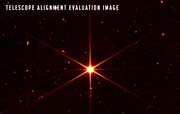
|
|
NGC 3198 is a magnitude 10.2 spiral galaxy in Ursa Major, nicely situated for imaging in the early Spring. With some faint scattered areas and unusual dusty patches, although quite small in the sky nevertheless it is a very interesting target with a tight star like core. The night of 6th March 2022 was beautifully steady and clear. Due to testing other equipment I was unable to start imaging this target until after midnight, so was short of time. But more data was obtained on the night of 25th March. Therefore this image consists of 9 x 10 minute and 10 x 15 minute Luminance subs binned 2x2, and RGB each 4 x 15 minute subs binned 2x2. QSI 683 on RC10 with SX AO unit. There are numerous tiny background galaxies in this image. I have identified several of them in this full size image. |
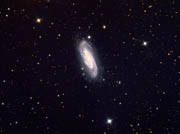 |
|
A couple of years ago I came across this beautiful image of a large dusty area in Draco. I managed to identify it in Skymap, the small galaxy top centre is NGC 3147, and realised that I would need to use my 200 mm Canon lens with my QSI camera. On April 21st 2020 I managed to obtain 12 sub frames of 15 minutes each binned 2x2. But despite the long exposure time I needed extensive processing to see any detail, and with no colour left it for another time. Indeed forgot about it! |
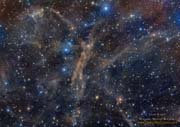 |
|
But when I briefly owned the Altair 294C CMOS one-shot colour camera I tried again, this time at the Galloway star party on 28th February 2022. This time despite taking 19 x 10 minute subs I failed to get any useable detail of the nebulosity, but good star colour and a hint of nebula colour was visible. So I managed to combine it with the QSI image with this result. Still not what I was hoping for, but I am at Galloway again in early 2023, and hope then to take further advantage of the very dark sky to revisit the target, this time with my QSI camera. North is to the left. Full Size. |
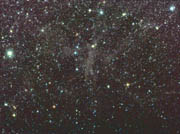 |
|
Following the successful launch, deployment and insertion into its L2 orbit of the James Webb Space Telescope, I was looking for coordinates for the telescope's position,and came across this page. So I decided to have a go at imaging this wonderful telescope in the hope that there is enough sunlight reflecting from the heat shield to show up as a star in an image. I was set up to image LDN1357 (above) with my QSI683 camera on my 4" TMB 105 refractor. But while the Moon was up (6th Feb) I had an hour to play (I'd been out earlier). Got 6 x 5 minute images unbinned with 5 minute intervals between each image, and this monochrome gif is the result. Much cropped from the original frame of course. Look for the faint moving dot a little below centre. The upper of the two bright stars is TYC 763-29-1 in Canis Minor, so you will be able to find the location in a planetarium program. As usual click on the thumbnails for (slightly!) larger images. This image shows the trail with all the frames overlaid and brightness increased. Very faint, around mag 19 or 20, but undoubtedly James Webb - the coordinates match those given on The Sky Live site. |
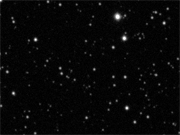
|
|
NGC 2276 mag 11.3 small spiral galaxy lies just on the border between Cepheus and Ursa Minor, and indeed is only 4 degrees from Polaris. So from my 55 deg North latitude it never gets lower than 51 degrees altitude. Although there was a 30% waxing Moon on the evening of 7th January 2022, the sky was very clear so I decided to try for some data before clouds arrived around midnight. One or two problems with power and focus, but I managed to get just enough data for this image. QSI683 on RC10 with SX AO, 10 x 10 minutes Luminance, RGB 4 each x 10 minutes all binned 2x2. This galaxy is distorted by the proximity of elliptical galaxy mag 11.1 NGC 2300, more information and a Hubble Space Telescope image here (opens in a new window). Because of the location of the galaxy, I should have an opportunity for a full night's data this season, and will try unbinned, hopefully to improve fine detail under stable conditions. 'Mouse over' the medium size image (click on the thumbnail as usual) for information on the several distant galaxies also in the image. North is up. A session on 27th January gave 13 good unbinned Luminance images which marginally improved the final image. |
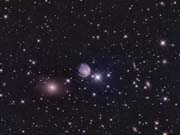 |
|
Alas my beloved Solarview 50 is back in the Isle of Man while Helmut wrestles with getting it set up at its best after it was damaged several months ago. But now that the Sun has started to wake up after the long minimum this show on 17th December 2021 was too good to miss. So on with a white light filter on my TS65 Quad and an avi (used 30 frames of 74) with my GPCAM3 mono. It was just after noon, so the Sun was almost at its highest, but still very low at less than 12 degrees altitude. And in thin haze. But worth a go and a bit of tweaking in software got this result. Full Size. |
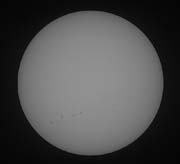 |
|
Comet C/2021 A1 LEONARD brightened nicely towards the end of November 2021, and was due to pass near the interesting galaxies NGC 4631, the 'Whale' and NGC 4656, the 'Hockey Stick' on the night of 24th. Rising late and not at a decent height until after 2 am, but the forecast was for clear sky, so I set up my Canon 700D camera on my Meade 127 refractor with TS FLAT2 field flattener. The sky did clear beautifully, but unfortunately there was a bright 73% mag -11 waning gibbous Moon. But while waiting for the comet to reach a reasonable height, I decided to have a look at the wonderful bright Orion Nebula Messier 42. With this result, rather 'noisy' because of the moonlight, but worth keeping, it is a combination of different exposures to bring out the bright trapezium area. 5 ISO 800 subs at 2 minutes, 9 at 30 seconds and 5 at 10 seconds. Just a bit of fun really - there is a far superior image from 2010 here. |
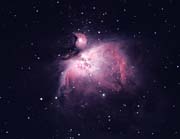 |
|
Then on to comet LEONARD. Again because of the bright moonlight (the Moon was a little over 50 degrees from both targets) difficult to reduce noise, particularly for the fainter target. In this case 9 x 5 minute ISO 1600 subs. As for M42 processed with Darks and Flats in Deep Sky Stacker, but using the clever system to align on both the comet and stars. It doesn't always work, but this time was successful. There is a good image of the galaxies from 2009 here. Larger image. For this and M42 because of the 'noise', not full size - no point! |
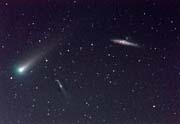 |
|
This took a few weeks with all the cloudy weather at the start of the imaging season in August 2021. But at last the two nights of 6th and 7th September finally let me finish data collection. IC1396 was riding high in Cepheus at the time, crossing the meridian almost overhead for me, so although some subs were taken during Astronomical twilight , being narrowband they haven't suffered too much. This is a mosaic of two images with my QSI 683 on TS quad 65 (420 mm fl). 20 minute subs needed so quite a lot of time. In the end Ha was two sets of 10 subs. OIII and SII two sets of 6 subs, all 20 minutes each, all unbinned. So total exposure time 15 hours. Plus of course time spent messing around realigning the camera etc. for each session. This image is mapped HOS to RGB, with some colour tweaking to produce the blue area. I tried a number of different processes, but this was considered to be the most pleasing! Larger image The iconic Elephant's Trunk nebula (VdB142) is featured of course, and also imaged in close up here. |
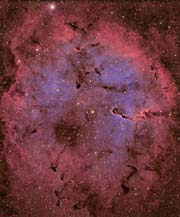 |
|
On 10th June 2021 there was a partial Solar Eclipse in the UK (part of an Annular Eclipse over the Arctic). Like many others in the UK I was clouded out for much of the time. But managed a bit of Hydrogen-Alpha as well as white light. so here are a couple of the former, one combined with a longer exposure to capture prominences. Solarview 50 with GPCAM3 178M. The upper image, shortly after first contact, was timed at 0910 UT, larger image here.
The lower at 1117 UT, larger image here. Nothing particular in the few white light images, so not presented.
It was cloudy for the maximum eclipse, but also like others I was able to use a consumer camera - TZ70 on full 30x optical zoom to get a shot or two through the clouds. Cropped from the original. |
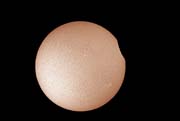
|
|
Towards the end of January 2021 I had an accident with my Solarview50 Ha telescope which detached the etalon thereby needing repair in the Isle of Man. They had an awful time fixing it - the etalon plates just would not go back together. Until they tried replacement spacers - most unusual for them to be damaged, and then the magic happened. I got the 'scope back on 8th June, just in time for the partial eclipse on 10th, (guaranteeing full cloud cover!), but no decent clear spells. 9th June a bit better, and some definite action so I decided to go for an image with my GPCAM3. And when I stretched things, I found what might be a coronal mass ejection, certainly clouds of gas thrown a huge distance from Sunspot AR2831 - the furthest section is probably at least 200,000 miles out. Lucky strike! NASA Solar Observatory image here. As you can see that was captured at 12.08 UT, my image was at 12.16 UT. Slight haze so only the brightest parts captured. Full size |
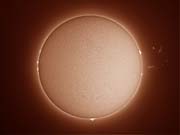 |
|
It's many years since I imaged M51 - the last time was in 2011 shortly before a supernova was discovered, and then the supernova itself. This last week or so with all the clear nights I've been catching some fainter objects. But the night of 16 April was yet again clear so I decided to go for an easier target and since it was almost directly overhead had a go at M51 despite the crescent Moon in the West. With this result. QSI683 with SX AO unit on RC10. Luminance 11 x 10 minutes, RGB each 5 x 10 minutes, all binned 2x2. . Full size
But there's more to M51 than meets the eye as witness this heavily stretched version. Obviously that will need much more data to lose the heavy background noise. but it's interesting to see how far out the faint extensions go. It'll have to be next year now. |
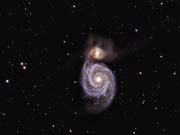
|
|
The Siamese Twins, also known as the Butterfly Galaxies interacting pair in Virgo is seperately identified as (upper to lower) mag 12 NGC4567 and mag 11 NGC 4568. The galaxy at the top of the image is mag 11 NGC4564, and the tiny one at the bottom, mag 14.4 IC 3578. Yet another beautifully clear night on 15th April 2021 - the 5th out of seven. I need an early night! But I'll have managed 6 nights imaging this month which although limited time as Summer approaches has helped to make up a bit for the generally terrible season. QSI683 camera with SX AO unit on RC10 truss. Luminance 14 x 10 minutes. RGB each 5 x 10 minutes all binned 2x2 Full Size |
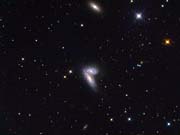 |
|
Yet another clear night on 14th April 2021! Making up for time lost this season and not to be wasted, but relatively short periods of darkness late at night. Sleep deprivation looming large! Elliptical galaxies are generally pretty nondescript objects to image, although of course they are amazing things usually containing billions of stars and a huge black hole, believed generally to be the result of galaxy mergers. Messier 60 (NGC4649) is a large magnitude 8.8 elliptical galaxy in Virgo, and this is the first time I've imaged it - I'd overlooked it as a run of the mill elliptical. But when I saw a Hubble image I realised that it has an interesting neighbour, magnitude 11.4 spiral galaxy NGC 4647. It's not certain whether the two are interacting, or the spiral is further away from us, but they make an interesting pair. The edge on galaxy in the bottom right corner is mag 11.1 NGC 4638. QSI 683 with SX AO unit on RC10. Luminance 12 x 10 minutes, RGB each 6 x 10 minutes all binned 2x2. Full size This image appeared in the June 2021 Astronomy Now Gallery |
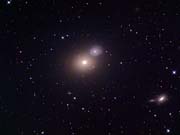 |
|
Although in general this season has been very disappointing the Arctic air high pressure system in early April continued to provide clear skies albeit with limited imaging time with the approach of twilight nights. The night of April 12th 2021 was again clear and I was able to capture data for this image. Messier 61 is a slightly distorted face on mag 9.3 spiral galaxy in Virgo. I have imaged it a couple of times in the past, the most recent being in 2007 but it was long overdue for a repeat visit to capture the fainter outer areas. This is one of the largest galaxies in the Virgo cluster and very active with several supernovae observed in recent years. QSI683 with SX AO unit on RC10. Luminance 14 x 10 minutes, RGB each 6 x 10 minutes all binned 2x2. The camera was actually rotated 90 degrees to provide a suitable guide star, so the image is cropped for a more pleasing North up view. The medium sized full image is available here. The other two notable galaxies (from right to left) are mag 12.9 NGC 4301 and mag 12.2 NGC 4292. Full Size |
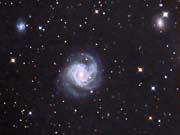 |
|
This group of galaxies in Coma Berenices is known as the Box Galaxies, Hickson 61. It consists of four relatively faint components. Starting with the long blue one and moving clockwise they are 12.7 mag NGC 4173, 12.2 mag NGC 4169, 13.5 mag NGC 4174 and 13,4 mag NGC 4175. What looks like a fuzzy red star near the right hand end of NGC 4174 is a tiny galaxy, PGC (LEDA) 213947. NGC 4173 is not believed to be part of the group, just a chance alignment and nearer to us than the others. The remaining easily seen galaxy towards the right edge is mag 15.1 UGC 7190. I got a small amount of data on the night of 10th April 2021, but clouds soon moved in. However the following night cleared nicely around 11.30 pm (BST) and stayed clear, and I was able to collect more data. So this image consists of Luminance 13 x 10 minutes, RGB each 7 x 10 minutes all binned 2x2. QSI 683 on RC10 with SX AO unit. Despite the reasonable number of exposures, because of the faintness of the target quite a lot of noise appeared. I was tempted to go for more data the next night which again was clear (!), but it had been such a lousy season that I decided to move on to another target. The magic of digital processing has I believe given me a satisfactory result. Full size |
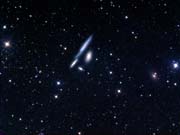 |
|
The mag 10.5 edge on galaxy NGC 5746 in Virgo is quite low for UK observers, but worth attention particularly because of it's similarity to big brother NGC891. The night of 9th April 2021 was forecast to be clear, but as is the way of things it wasn't free of clouds until almost midnight, so 1 1/2 hours of imaging time lost. Then a couple of problems lost another half hour - a mysterious extra diffraction spike appeared on the first couple of images, so I stopped the run and searched for a source. A floating bit of tape (from the secondary dew heater lead) was removed and that seemed to do the trick. Then I refocused before continuing. So a little short of data but happy enough with the result except for the substantial glow from the nearby 3.7 magnitude 109 Virginis. Dark nights are soon history for a few months, I may revisit this season, but with different framing to lose that bright glow. Or crop the image. Or just leave it as it is for artistic effect! Anyway, QSI683wsg with SX AO unit on RC10. Luminance 11 x 10 minutes, RGB each 4 x 10 minutes all binned 2x2 Full size |
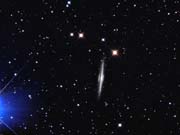 |
|
Early April 2021 saw several days with a blast of Arctic air which brought some clear skies. The night of 5th April started off with excellent conditions, unfortunately by shortly after 1am on 6th clouds had moved down from the North ending my imaging run (as usual click on the thumbnail). It would seem that the clouds did not affect the South of England until the night was over So they would have had a good session. Sod's law! |
|
|
Fortunately the following night of 6th was again forecast to be clear, and this time stayed that way and I was able to return to the previous night's target of NGC 5363 and associated galaxies in Virgo. Unfortunately some thin cloud part way through the night caused the scrapping of several sub frames, nevertheless I collected enough altogether to produce a satisfactory image. QSI 683 camera with Starlight Xpress AO unit on RC10. Luminance 16 x 10 minutes, RGB each 8 x 10 minutes, all binned 2x2. Full Size A nice range of galaxy types. Clockwise from top right the individual galaxies are: NGC 5356 mag 13.0, NGC 5360 mag 13.6, NGC 5317 mag 10.4, NGC 5363 mag 10.5. North is approximately up. |
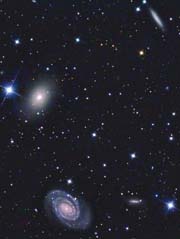 |
|
I first came across the interesting magnitude 10.5 galaxy NGC 4274 in Coma Berenices when browsing Skymap Pro in early March 2021 for proposed targets in that area already on my 'Must do' list. The Skymap image shown here immediately made me think 'Saturn Galaxy' and I resolved to try and image it. |
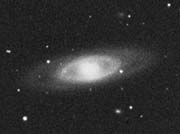 |
|
Unfortunately as has been the case most of this season, the weather did not play fair, and a couple of aborted sessions followed, completely ruined by haze and clouds although a short clearance on 21st March allowed me to collect the star field around NovaCas 2021 below. But eventually the night of 3rd. April started out clear, and I was able to proceed. Even though the sky appeared clear, and I had a full 6 hours of imaging time, disappointingly many of the earlier subs had unexpectedly high background levels probably due to thin haze and I had to discard more than half of them. So ended up with Luminance 11 x 10 minutes binned 2x2, RGB each 4 x 10 minutes binned 2x2. QSI683 on RC10 with SX AO unit. I may try for more good data if given the opportunity over the next week or so, but the twilight nights of Northern Summer are fast approaching! Full size |
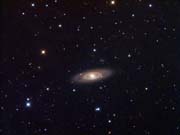 |
|
A Nova in Cassiopeia was confirmed as a 'Classical' nova following its discovery by Yuji Nakamura of Japan on 18 March 2021. Coordinates (epoch 2000) were confirmed as RA 23h 24m 47.73s, Dec +61° 11’ 14.8”. The star was not shown in Skymap Pro, but I located it in Stellarium at a magnitude of 14.4 I was able to collect some data on 21st March with this result. Cropped to put the pink-ish coloured nova in the centre of the image. The other two bright stars are magnitudes 6.6 and 9.1, so it would appear that the nova is in the region of magnitude 7.5. Quite a bang! QSI on RC10. A bit of a mix up with the hurried exposures, no flats or darks, but came out ok! Larger image This image appeared in the May 2021 Astronomy Now Gallery |
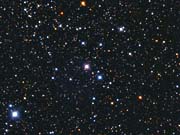 |
|
NGC 2506 is a bright (mag 7.6) quite dense open cluster in Monoceros. I first imaged it in 2020, but at a larger field of view so thought it worth a revisit. Low for me, never rising above 24 degrees. The night of 16th March 2021 was promising although with a young crescent Moon. A little late in the year, already past the meridian when the sky was dark enough, so low in the haze and the stars are slightly blurred. Not a focus problem, just down to sky conditions. But by keeping the exposures short I didn't saturate the stars so was able to show the colours and am reasonably satisfied with the image. QSI683 on RC10 with SX AO. Luminance 15 x 2 minutes, RGB each 8 x 2 minutes, all binned 2x2. Full size. |
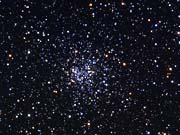 |
|
6th magnitude open cluster NGC 1746 in Taurus contains two other classified open clusters, NGCs 1750 and 1758, but it would appear that 1746 is the dominant. Quite large at about 50 arc-minutes. I could have gone for a close up, and may yet, but there is a fainter open cluster nearby, NGC 1802, this is to the far centre left of the image, so to get both in the frame I used my 420 mm focal length TSquad refractor. As can be seen, both the clusters are quite loose. Data obtained over two nights, 11th and 13th March 2021. The target was well towards the West limiting my imaging time - I would have preferred to image it sooner in the year, but the weather did not play fair! QSI683 with SXAO. Luminance 10 x 5 minutes, RGB each 7 x 5 minutes, all unbinned. Larger image (1.26MB) |
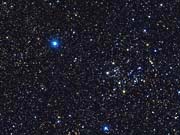 |
|
|
|
What a dreadful season! Notable for rain, snow, sleet, wind and a serious lack of dark moonless nights. I had not been entirely happy with my image of 9th magnitude Messier 85 in Coma Berenices from March 2020 which was imaged in very poor seeing conditions, and resolved to try and improve it. The poor weather led to a number of attempts with this final result, using data from the nights of 11th February and 13th March 2021 along with colour data from the original image. A slight improvement, and probably the best I can hope for. The more interesting spiral galaxy is magnitude 10.9 NGC 4394 and the faint small galaxy to the right of M 85 is magnitude 14.8 IC 3292. QS 683 on RC10 with SX AO unit. Full size |
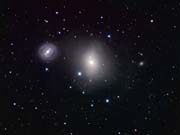 |
|
December 2020 and January 2021 had a succession of cloudy nights with very few clear periods. The night of 21st January however was crisp and clear. Unfortunately for deep sky imaging there was a first quarter Moon doing the usual searchlight thing! It's several years since I imaged the Moon other than during eclipses, but decided to do that rather than nothing! The monochrome Altair GPCAM3 nicely encompasses the Moon when on my 420 mm focal length TS65 Quad refractor. So here is the result. Stacked from 30 of 100 frames and cropped square. The medium size image (click on the thumbnail) has several craters named. |
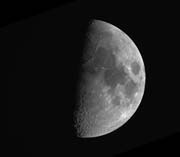 |
|
Although there was a bright Moon in the sky, the air was nevertheless very clear, so I decided to try for the 'Seagull' nebula, IC2177 in Canis Minor. This emission nebula is well suited for the use of narrowband filters, being particularly bright in Hydrogen-alpha, so worth a try. Also the large target needs a wide field, and the QSI 683 on the TS65 was just enough to cover the vast majority of the gas cloud. But it is very low in my sky, never rising above 24 degrees, so imaging is limited to an hour or so either side of the meridian. Unfortunately it clouded over before I was able to capture any more than 9 Ha images, and only one on 23rd January, so for now this is the monochrome result. But looking promising - plenty time this season to acquire more data if the weather plays even remotely fair! 10 x 10 minute Ha subs binned 2x2. QSI683 with SX AO unit on TSquad. Full size The weather didn't improve much over the next few weeks, but I eventuually got more data on 11th February. So this final image consist of 14 x H-alpha , 4 each OIII and SII, combined HOS. All 10 minutes binned 2x2. Plus 10 x 5 minutes Luminance and 4 x 5 minutes each RGB all binned 2x2. Full Size |
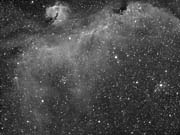
|
|
A dreadful winter season so far, but on January 8th (2021) there was a clear-ish night when I was able to complete the colour data for NGC3079 in Ursa Major. All details here. Full size |
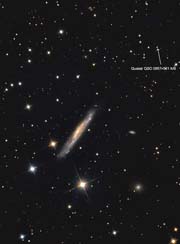 |
|
I first imaged the bright open cluster Messier 50 in Monoceros in 2004, and it was long overdue for a second look. The Autumn of 2020 was beset with bad weather, but a clear night was forecast for 21st November. M50 is low in the sky for me and I had to wait until the early hours of 22nd before I could start imaging. But it was worth it in the end! I first did a set of binned images, but reverted to unbinned - binned was overly saturated to obtain good star colours. QSI on RC10. Luminance 11 x 5 minutes, RGB each 5 x 5 minutes. Larger image |
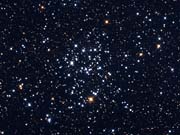 |
|
In the Autumn of 2020 Mars approached the Earth at its best in a number of years for my latitude (see 2016 report). For some reason, I suspect because of my location in rolling country in the lee of the Pennines I hardly ever get skies stable enough for imaging planets which require considerable magnification. But I had to go for it! So this image was obtained in the early hours of 18th September. At the time of imaging (0335 UT) the diameter was 21.32 arc secs. Imaged with an Altair GPCAM2 colour camera on my 10" RC telescope (2000 mm focal length). I used a 3x Televue Barlow to magnify the image. For this and the following images, multiple frames were selected and stacked using Registack 6. Click on the thumbnails for the full size images. There is an excellent free stand alone program, 'Mars Previewer 2' which shows features on Mars at any date and time. Click here for this particular view, but for information of the various features, I strongly recommend you download and install it - hovering the mouse over the live image will name numerous features. Information and download can be found on the internet here Unfortunately the installer doesn't want to work on Windows7 or above. Yet it's on my W7 computer - I wish I could remember how I installed it! IMPORTANT I've now (2022) managed to install Mars Previewer on my W7 laptop. Just needed a missing Windows DLL file to be added when copying the existing installation. So if anyone wants to use this very nice program, email me. My email on the 'Latest' page. |
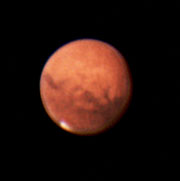 |
|
Cloudy weather intervened but the night of 1st-2nd October was clear and crisp. So I took several sets of images over a few hours. Nevertheless because of turbulence only one set was worth keeping and that is this one from 0001 UT on 2nd. Again GPCAM2 colour on RC10 but this time with a Televue 2.5x Powermate. Because of the lower magnification the original image was smaller than that above, so I have increased its size to compensate for the difference. At this time the diameter was 22.47 arc-secs. The very prominent feature is of course Syrtis Major. Mars Prevewer image here. |
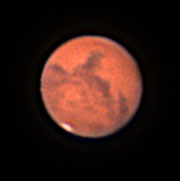 |
|
There is another venerable free program giving a graphical image of Mars (and other planets) - Meridian. It does install on later versions of Windows, but doesn't name features. Nevertheless useful. I've put the 'meri487.exe' installer on my web site here. This is the installer I used, and my anti virus program has never objected! Sample image (Syrtis Major)
BUT, lest we forget. The readily available free 'Stellarium' does an excellent job, also naming features, the only slight drawback being the extra time the program takes to load and set time etc. Here is a sample crop from a screenshot. click on it for a larger image. |
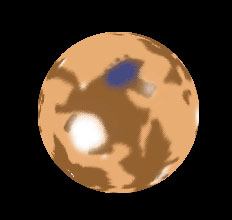
|
|
Again some cloudy weather but the night of 9th-10th October was clear for a short while and I was able to capture several sets of images. Again only the best is presented. Quite turbulent sky with a weather front approaching, so difficult to pull up detail. The maximum altitude for me during this apparition was approximately 40 degrees, so decently high, which of course helped to improve the seeing despite the poor sky conditions. Mars Prevewer image here. |
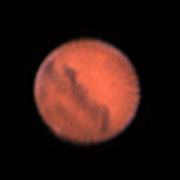 |
|
Because Mars' rotational period is 24.6 hours, a very similar view is presented from night to night, only changing slowly. I still didn't have a full view of the distinctive Sinus Sabaeus. In order to capture that particular 'face' of Mars when still a reasonable size following conjunction on 8th October I had to image it early in the evening when still quite low in the sky, or wait until it appeared when high in the sky, by which time it would be getting smaller as it moved away from Earth. Weather conditions were consistently bad, and although a brief clear sky opportunity arose on 22nd October, the seeing was very poor, made worse by the low (20 degree) altitude. So even extensive processing only produced a verydisappointing image, with Sinus Sabaeus right of centre. But maybe another opportunity in a week or so.... Mars previewer image here. |
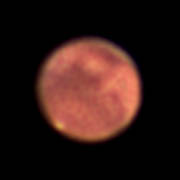 |
|
A more propitious night on 30th :October - clear for a while and Mars much higher than on 22nd. Still disappointing seeing - dancing around and 'morphing'. But with processing a better view of Sinus Sabeus. Mars previewer image here. In 2022 Mars will be much smaller, 17 degrees 19 seconds diameter at closest approach on 1st December. But for me nicely high, reaching 60 degrees altitude, which should allow for decently detailed images. But there is an additional bonus. On 8th December, when still 17 degrees diameter it will be occulted by a Full Moon around 4.54 am. Lowering into the West by then, but still at 29 degrees altitude. Emergence is at 5.54 am. altitude 20 degrees. Quite low so peering through thickening and possibly turbulent air, but if the weather is kind, the air is usually most stable in the hours before dawn. So fingers crossed! |
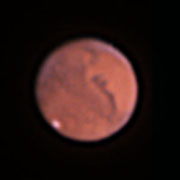 |
|
NGC 6940 is a large bright (mag 6.3) open cluster in Vulpecula on the border of Cygnus and only 4 degrees from the well known Veil Nebula. But as it is immersed in a bright area of the Milky Way it is not easily distinguished from the background. The first deep sky target of the 2020-2021 season, on the night of 22nd August, but limited exposure time due to very unseasonable weather. However the sky was particularly clear for a short time, so I feel the image has sufficient clarity to be acceptable. If I have the opportunity I will gather more data. QSI 683 camera with SX AO unit and TSFLAT2 on Meade 127 refractor. Luminance 5 x 5 minutes, RGB each 3 x 5 minutes all unbinned, Larger image (1.13MB) |
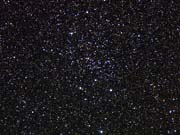 |
|
Comet C/2020 F3 NEOWISE graced the Northern Skies during the Summer of 2020 and for many days was a faint naked eye object, beautiful in binoculars. Unfortunately during twilight hours at my latitude, and low in the sky, almost due North. But the brightest and best comet for many years, just visible naked eye even with my old eyes, so I couldn't miss opportunities to photograph it, particularly as I wasn't doing any main imaging at the time. These were on the night of 13th July. Plagued by cloud at the darkest time (1 am Summer Time), so the ion tail to the upper left was lost in the background. Increasing the blue level just shows it, but the overall colour is wrong. I hope to try again of course. Canon 700D with 200 mm telephoto lens at f5, several 15 second sub frames combined in Deep Sky Stacker. |
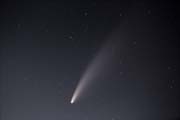
|
|
For a number of days the midnight sky was disappointing, either cloudy or hazy. But the night of 19th cleared nicely with this result now showing a hint of the ion tail. I couldn't expect any better from my location - not only astronomical twilight, but low in the Northern sky - the brightest part at this time of the year. Again Canon 700D with 200 mm telephoto lens at f5, ten 30 second sub frames combined in Deep Sky Stacker. Note the 9th magnitude galaxy NGC 2841, indicated in the medium sized image (click on the thumbnail). A 2010 image of this beautiful spiral galaxy is here. |
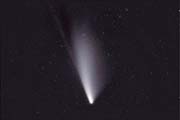
|
|
A few more cloudy nights, then 24th was nicely clear, although as before background twilit sky, but with the comet fading as it moved away from the Sun, no longer visible to the naked eye (mine anyway!) So this was the final attempt. 8 frames at 30 seconds, camera as above. |
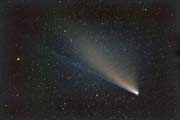 |
|
On its travels, comet C/2017 T2 PANSTARRS passed close by Messiers 81 and 82 towards the end of May 2020. The few days when it was close were badly affected by a deep low pressure system, so I had to make the most of any chance. The night of 22nd May was marginal for framing, but cleared shortly after midnight and I was able to capture several images before the clouds returned. so this is the result. Canon 700D with Celestron off-axis guider and TSFLAT2 (the back focus worked out beautifully!) on TMB105 refractor. 10 x 5 minute subs at ISO1600. I could of course have framed the comet lower down in the image, but that would then have missed out the little galaxy NGC 3077, poor thing. North is up. Larger image |
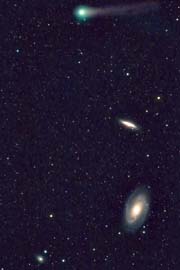 |
|
After my effort above, I hoped to have a second crack at comet C/2017 T2 PANSTARRS in the vicinity of Messiers 81 and 82, with it better placed for the composition of the image. A number of weather forecast sites promsed clear skies on 24th May, and indeed in the early evening things were clearing up nicely. With Astronomical twilight being the best on offer I decided to image between 12.30 and 1.30 to get the darkest sky available. But when I went out around 11.30 to make a leisurely start - disaster! Solid cloud cover. It wasn't until almost 1 am on 25th (midnight UT) that things cleared enough for me to start aligning etc., so 1.15 before I started imaging in earnest, and by 2 am the sky had lightened so much that the background was excessive. So in the end I only had 7 subs to play with, the later ones with a rather light background and the combined image had a very noisy background and generally poor contrast. Much processing later and this is the result, but not what I'd hoped for. Canon 700D with TSFLAT2 on TMB105 refractor (650 mm focal length). 7 subs x 5 minutes at ISO1600. |
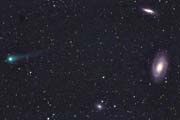 |
|
On the night of 14th May 2020, comet C/2017 T2 PANSTARRS was due to pass very close to NGC 2633 (Arp 80) in Camelopardalis. NGCs 2634 and 2643a also very close. But all these galaxies are faint, around magnitudes 12 to 13 so would need reasonable length exposures. The weather forecast was for clouds, and for once it was correct and it did cloud over. But not before I managed to get on target and snatch 5 subs! 5 minute subs with the Canon 700D on the Meade 127 refractor, at ISO3200 to try to catch the faint galaxies. I knew they would be a bit noisy at that ISO, but had it stayed clear I would have gone for at least 12 subs, probably more. But this will have to do. Stacked in Deep Sky Stacker using the comet and stars setting, finished in Photoshop. At least I managed to capture those faint galaxies as well. 'Mouseover' the medium size image for identifications. Larger size. |
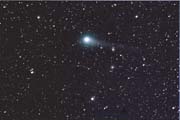 |
|
I seem to have a perverse death wish at times! I see a marvellous image such as this one which was imaged with a 14.5" telescope 4000 feet above sea level in an Arizona dark sky park, and attempt to capture similar quality with a 10" telescope from my home observatory 680 feet up in North East England under semi rural skies. Well, I can't match it of course. This beautiful group of galaxies is in Virgo. The largest is NGC5566 (Arp 286, mag 10.7), NGC5569 (mag 13.7) above it and NGC 5560 (mag 12.4) to the right. The much smaller galaxy looking like a fuzzy star towards the left of the image is 16th magnitude PGC 51269. Twilight nights were rapidly approaching, but after a very poor 2019-2020 season I resolved to have a go at this, even though full dark hours were limited and quite long exposures were required for these fairly faint galaxies. First attempt on 22nd April 2020 was partly spoiled by high haze earlier on in the sequence leading to high background levels and the loss of 8 frames (2 hours worth!). Fortunately the night of 25th April was kinder and I captured enough extra subs to produce a reasonable image. Unfortunately seeing was rather poor on both nights, so the finest detail is lost. Can't win them all! QSI 683 on RC10 with SX AO unit. Luminance 11 by 15 minutes, RGB each 4 x 15 minutes all binned 2x2 |
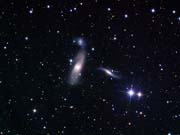 |
|
Messier 85 in Coma Berenices is a large elliptical galaxy with an extended halo of stars, and appears to be interacting with a nearby smaller neighbour NGC 4394. I had never imaged them, and a crisp clear night on 22nd March 2020 gave me an opportunity. Unfortunately the seeing was very poor - even stars overhead were twinkling, so the stars are somewhat bloated and fine detail is lacking in NGC 4394 despite using the Starlight Xpress active optics unit. Hopefully I will get another opportunity this season, although the weather has generally been very poor. The small galaxy to the right of M85 is mag 14.8 IC 3292. QSI 683 on RC10 with AO unit. Luminance 11 x 15 minutes, RGB each 4 x 15 minutes, all binned 2x2. Full Size. |
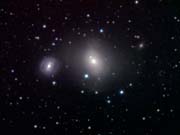 |
|
January 2020 was effectively a no-go for imaging - a succession of low pressure systems bracketed a high pressure system which unfortunately was also full of cloud. But a four hour window on 18-19th of the month gave me an opportunity to capture this (cropped) image of Messier1. It's made up of 8 x 30 minute Oxygen III subs, QSI683 on RC10, binned 2x2. I went for it following an observation by Olly Penrice of the 'tail' at the top which had not generally been imaged, and is mainly visible with an OIII filter. I hoped to get more data to complete a colour image, but even into February the skies were disappointing, and Taurus was rapidly westering! Watch this space! Full size |
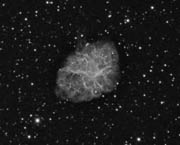 |
|
More difficult than I expected, the Witchhead nebula in Eridanus has always been on my must do list, but always eluded me. Until New Year's Eve 2019 when a clear sky which had been forecast for several days actually materialised!! Although I was out at friends to see the New Year in, I was able to leave things running from around 9.30 pm with the dome drive doing it's business, and got an uninterrupted flow of images for around 6 hours starting with the target on the 'wrong' side of the Equatorial mount. Had to scrap a couple from the end of the run - too low in the sky. But this is the result of 11 luminance and 6 each RGB, all 10 minutes binned 2x2. QSI 683 on TS65 quad refractor. But as I say, difficult - it's a faint target and low in the sky for me, never rising above 28 degrees altitude so lacking in contrast. I might have another go this winter if the weather is kind for more data around the transit. But for now (and maybe for ever for me!) this will have to do. North is down to show the profile at its witchiest. Full size. |
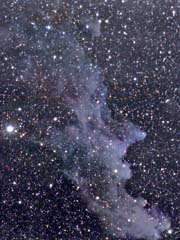 |
|
Magnitude 6.1 bright open cluster Messier 46 in Puppis has always been on my hit list, but never imaged. Until the night of 30th December 2019 which was unexpectedly clear for a few hours after many cloudy nights. M46 is very low in the South for me, never getting higher than 20 degrees, so generally hazy and disturbed, leading to a certain amount of star bloating, although the Starlight Xpress AO unit did it's best - the guide star was bright enough for 5 frames per second. Conditions were not good and I had to scrap some subs due to thin cloud, but managed to get usable 9 Luminance and 6 each RGB. All 5 minutes binned 2x2, QSI 683 on RC10. The cluster pretty well fills the field of view, but I wanted also to capture the planetary nebula NGC2438 in the foreground. All things considered I'm reasonably pleased with the result. Full size |
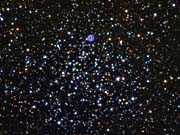 |
|
There is another Nebula in M46, the Calabash Nebula (OH 231.84 +4.22). This is a protoplanetary nebula - a planetary in early stage of formation. It is believed to be part of M46, not superimposed.
Barely visible in my image, this is a highly stretched monochrome crop, but just identifiable when compared with Adam Block's image, which of course was taken with a 32" telescope at 9000 ft above sea level! I may return to M46 and try for some Hydrogen-alpha data to bring up the fainter parts of NGC2438 and perhaps the Calabash, but because of the low altitude it will need data from more than one night. And the way the weather has been, it doesn't look very promising.
The Hubble image is absolutely gorgeous. Click on all the images for larger versions.
|
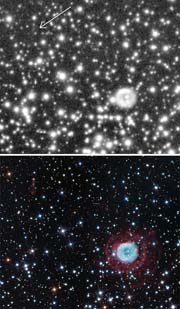
|
|
Before the clouds returned in early December 2019, the night of 1st. was also clear, so I decided (long overdue!) to revisit Messier 38 - the large open cluster in Auriga. Previously imaged in 2001 afocally with my first digital camera. How things have moved on! So this is my QSI683 on Meade 127 refractor with Teleskop Service TSFLAT2 flattener and SX AO. Luminance 14 x 5 minutes, RGB each 6 x 5 mins, all unbinned. |
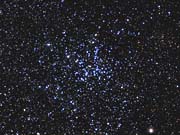 |
|
Our annual autumn weekend on November 22nd 2019 at Calvert Trust Kielder was a total washout - a brief glimpse of Deneb and Vega on the Friday evening was all we saw of the sky - no more stars, no Sun during the day. Just endless heavy cloud and rain. Hope for better luck in Autumn 2020 when we are going in October. Typically after even more bad weather, the following weekend saw a dramatic change to cold northerly winds and a clear sky. So I decided to revisit Messier 103 in Cassiopeia, first imaged by me in 2003. 10 Luminance subs and 5 each RGB, all 5 minutes unbinned with the QSI683 and RC10 on the night of 29th November produced this pleasing result. |
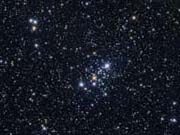 |
|
In early November 2019 I was browsing in Skymap Pro, and spotted an interesting asterism a degree or so South of M33. The human brain is quite good at seeing shapes in the stars - witness the constellations. And at first I could see a giraffe. Then after another look, a chicken! And had a bit of fun playing with images. At least I was making use of cloudy nights! Anyway, after a long period of cloud and rain, which brought extensive flooding to parts of Yorkshire, there was a nice clear sky on 18th November with a few hours of full darkness before the Moon rose. So I set to with my QSI683 on my Meade 127 refractor (950mm fl), and imaged the asterism with this result. Luminance 16 x 5 minutes, RGB each 8 x 5 minutes, all unbinned. There are a few very distant galaxies in the image, the easiest to spot is UGC 1154 near the bottom left corner. 'Mouseover' the medium star image for identifications. Near full size image. |
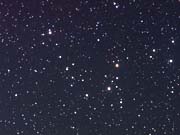 |
|
I'd already set up image overlays using a screen shot from Skymap, so here are the results using the actual star image. I'm not sure which is the better of the two creatures - of course we already have a 'giraffe' constellation, so although I'm sure it's not a true cluster, the 'Giraffe Cluster' might be appropriate. The Giraffe is more elegant, but maybe the Chicken is a better fit. For now I'll call it the Giraffe Cluster. Click on the thumbnails as usual for larger images.
I had started a thread about this on the Stargazer's Lounge user group, and one member suggeted using an image of a velociraptor. His image didn't fit too well - most of the tail was lost, but I found another one on the 'net which I rather like. Because the star 'cluster' is really an asterism, I call this image 'Rapterism'! Well, so much cloudy weather at the time, it helped to relieve the boredom :-) |
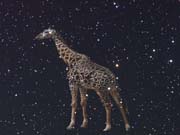
|
|
On 11th November 2019 there was a transit of Mercury across the face of the Sun. due to start at 1235, but the Sun would set well before the end of the transit. Nevertheless I hoped to catch as much as possible. Unfortunately the weather was not kind here in Northumberland, particularly at the start of this unusual event, but I managed to capture it just after the start. Mercury is the tiny black dot at around 8.30-o-clock right at the edge of the Sun's disc. An hour or so later the skies cleared nicely for a short while and I was able to get a better full disc image with Mercury about a 1/4 of the way across, just below the centreline. Then the rain arrived, and I never got another clear image. But better than nothing, since there isn't another transit until November 2032, and that will have already started before Sunrise. Full size start here, later here. Taken using an Altair GPCAM3 178M on Solarview50 H-alpha telescope. I bought this camera to replace the GPCAM2 which didn't quite cover the disc of the Sun, also the new camera has smaller pixels, so hopefully better definition - no Barlow needed for prominences and sunspots. I'd hope to get a whole sequence until the Sun was almost set, but not to be. A tiny hint of a prominence at 9-0-clock on the later image, but that's all - the Sun is in a very quiet mood at the moment! |
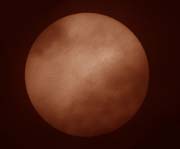
|
|
NGC 7242 is a fairly faint (mag 12.9) elliptical galaxy, notable for being the main member of a small group of galaxies in Lacerta. The nights of 29th and 30th of October 2019 gave me the opportunity to capture enough data. Only just enough colour - clouds moved in towards the end of the RGB run in the small hours of 31st. QSI 683 on RC10 with SX AO. Luminance 13 out of 16 (clouds!), R & G 4, B 3 subs all 10 minutes binned 2x2. Full size image here, mouse over the medium size (as usual click on the thumbnail) for names of most of the galaxies - there are some very faint ones unnamed. |
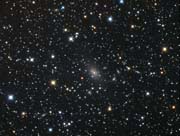 |
|
Sharpless 187 is an emission nebula situated 1.5 degrees North of the bright star Ruchbah in a star rich area of Cassiopeia, enveloped in interesting dust clouds. The emission area responds well in Hydrogen alpha light, nevertheless it is bright enough to show up nicely in ordinary RGB imaging. The data for this was collected over two nights, 5 luminance on 26th Octber 2019 before the clouds rolled in, the remaining luminance and all the RGB on 27th - a beautiful clear night all night. QSI 683wsg with TSFLAT2 and Starlight Xpress AO unit on Meade 127 refractor. Luminance 17 x 20 minutes, RGB each 5 x 20 minutes, all unbinned. North is up. Larger size |
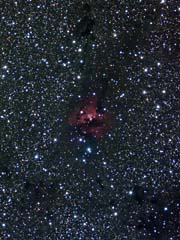 |
|
I imaged the bright open cluster Messier 52 in Cassiopeia in 2005, but it was due for a revisit. The night of 7th October 2019 was forecast to be very clear, and so it was. There was a bright Moon, but that set shortly before 1 am local time, and I was able to capture this image with Cassiopeia high overhead. QSI on RC10, Luminance 10 x 2 minutes, RGB each 5 x 2 minutes, all unbinned. Larger size |
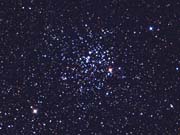 |
|
NGC7510 is a fairly bright (mag 7.9), compact open cluster in Cepheus, quite pretty with the curving string of stars. Often imaged as part of the much larger emission nebula Sharpless 157 - 'The Claw' nebula. I have an image here, the cluster is situated at the top centre of the image. A clear night on September 6th 2019 gave me the opportunity to image it. My main consideration in this image is to show the star field, but there is a hint of the nebulosity towards the lower left of this image. The general area shows a slight reddish tint due to the nebula. QSI 683 on RC10. Luminance 14 x 5 minutes, RGB each 7 x 5 minutes, all unbinned. |
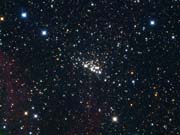 |
|
IC 342 in Camelopardalis is known as the 'Hidden Galaxy' because it is viewed through our own Milky Way galaxy and is obscured by clouds of gas and dust which give it a reddish hue. At around 75,000 light years in diameter it is not particularly large as galaxies go, but it is quite large in the sky - approximately 20 arc-minutes in diameter (2/3 full Moon), and if it was not obscured might be visible to the naked eye in dark skies. I first imaged it in 2006, but felt this wonderful face on spiral deserved another visit. The night of 31st. August 2019 was particularly clear with a decent interval of fully dark sky, so gave me the opportunity. QSI 683 on RC10 with SXAO unit. Luminance 14 x 10 minutes, RGB each 6 x 10 minutes, all binned 2x2. This image was Picture of the Month in the November 2019 Astronomy Now Gallery and featured in the 'Night Sky' section of the November 2022 Astronomy Now. |
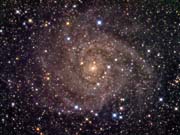 |
|
The magnitude 10.8 galaxy NGC 3079 in Ursa Major is very interesting in its own right, being somewhat disturbed with a bubble in its centre nicely imaged by the Hubble Space and Chandra telescopes. But the local area is also of interest because it contains the double quasar QSO 0957+561 A/B, which was discovered in 1979 and was the first identified gravitationally lensed object. A clear night on 1st. May 2019 got me out imaging. But this image at the moment is monochrome - lack of dark sky time this time of the year, but hopefully a couple more clear nights before all twilight until August will get me some RGB data. I may also try for some H-alpha data, hopefully to show the 'bubble'. At my 55 deg N latitude, NGC 3079 transits at 89 degrees - right overhead. But I missed the best chance this year. Next February/March will be my best bet. If I get an exceptionally stable sky, I'll try again unbinned and see what transpires although I doubt my equipment and sky conditions will have the necessary definition to show the bubble. Fingers crossed! I got a small amount of colour data in April 2020, but it wasn't until January 2021 that I finally completed this image with more colour data. Although I captured some Ha in 2020, it did not show the 'bubble' so has not been used in this image. Close examination of the centre of the galaxy just shows the star which Hubble imaged sitting at the top of one of the arms of the bubble. The two smaller galaxies to the right are (top down) magnitude 15.5 PGC 28990 and mag 13.0 NGC 3073. Luminance 10 x 15 minute subs, RGB each 7 x 15 minute subs all binned 2x2 with QSI 683 and SX AO unit on RC10 truss telescope. North approximately up. Full Size This image was published in the Night Sky section of the March 2024 issue of Astronomy Now, with particular emphasis on the Double Quasar |
 |
|
Messier 102 in Draco is also catalogued as NGC 5866, and the naming as a Messier object has always been controversial. Be that as it may, I first imaged it in 2003 under poor conditions, only obtaining a small ill defined image. I recently determined to return, and roamed the internet looking for examples. There are of course superb Hubble images, but many others only show the core and a hint of the dust lane. However I was particularly inspired by this image from Adam Block showing the extended cloud of stars. Dark nights were in short supply towards the end of April 2019, but a run of three, although only 3 hours of full darkness on each night, gave me the opportunity before twilight nights returned for the Summer. Despite the occasional passing cloud and late night fog I managed to acquire luminance subs on 27th and 28th, and 29th gave me yet another clear night to capture colour. Of course I don't have the exceptional contrast of Adam's skies, and my telescope is a 1/3rd of the size. But I'm well pleased that I have managed to show much of the star clouds as well as the dust lane. Luminance 16 x 15 minutes, RGB each 4 x 15 minutes all binned 2x2. QSI 683 on RC10 with SX AO unit. This image appeared in the July 2019 Astronomy Now magazine Gallery |
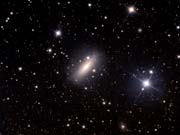 |
|
I initially imaged this, the Draco Trio, a repeat of a much earlier image, over 27th & 28th March 2019, and it was only when I came to process it that I realised I was slightly out on the framing - I found that I had just clipped the left hand edge of galaxy NGC 5985. With this result. Seeing was also poor for both nights, so it was my intention to redo the whole set. Fortunately a couple of clear nights, although 9th April had passing cloud but I managed some data, and 10th April was beautifully clear, so I started imaging well before the Moon set, with decent results. So now I have the positioning the way I wanted it in the first place. Seeing was also better on both nights, so improved detail. QSI683 on RC10 with SX AO unit. Luminance 12 x 15 minutes, RGB each 6 x 15 minutes, all binned 2x2 . Quite long exposures needed because none of the galaxies are brighter than mag 11. NGC 5985 is the beautiful face on spiral, the centre elliptical galaxy is NGC 5982, the edge on to the right is 5981, then little 5976 near the lower right side - it was my attempt to make sure 5976 was included that led to the original mis framing. North is approximately up. |
 |
|
NGC4449 is quite a bright (mag 9.4) dwarf galaxy in Canes Venatici, also known as the 'Box Galaxy'. Not often imaged, the preference being for its famous neighbour M51. I'd never imaged it before and decided to remedy that omission before it was too late in the season. While searching for examples I came across R. Jay Gabany's superb image. Anyone familiar with his work will know that with his high altitude observatory (4600 ft) and 1/2 metre telescope he specialises in detecting tidal streams. Indeed he found one associated with this galaxy, which made it even more of a challenge for me. Of course I don't have his superb location, equipment or for that matter pristine skies. But a couple of reasonable nights on 29th and 31st March 2019 gave me enough data to be fairly happy with my own effort which *just* shows the tidal stream in the lower left of the image to the right of the two distant galaxies. QSI 683 on RC10 with SX AO unit. Luminance 23 x 10 minutes, RGB each 7 x 10 minutes, all binned 2x2. In my image, North is up, Gabany's has North to the left. Full size. This image appeared in the 'Deep Sky' section of the April 2020 issue of Astronomy Now and the 'Caldwell Catalogue' feature in April 2021 Astronomy Now |
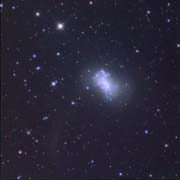 |
|
NGC4395 is quite a large Seyfert galaxy in Canes Venatici just on the border with Coma Berenices. Large in the sky, but actually a dwarf galaxy 'only' 14 million light years away. Thought to have an unusually small black hole at its core, so of particular interest to astronomers. At mag 10.2 it would seem to be fairly bright, but it is very diffuse with a surface brightness of only 15.4. Consequently a bit of a challenge to imagers. Rather disturbed but classified as SBm, a galaxy with one single spiral arm. It also appears to me to be slightly barred. I first imaged this in April 2009 but only monochrome. A very poor season this year (2019), but a long clear night was forecast for 7th March, so I decided to revisit this interesting galaxy with this reasonably satisfying result. QSI683 on RC10 with SX AO unit. Luminance 18 x 10 minutes, RGB each 7 x 10 minutes, all binned 2x2 |
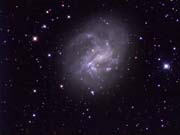 |
|
IC 426 is a small reflection nebula tucked away in Orion just above the 'belt', and generally overlooked in favour of its more famous neighbours. A rare clear night was forecast for 4th February 2019, so I took the opportunity to visit this attractive object. Orion is relatively low in the sky for me, and unfortunately I had equipment problems so did not capture as much data as I would have liked. But it will have to do for now - not much prospect of a clear sky the next few nights, and then I have a hip replacement operation scheduled which will put me out of action for a few weeks. QSI 683wsg on RC10 with SX AO unit. Luminance 7 x 10 minutes, RGB each 4 x 10 minutes all binned 2x2. Full size |
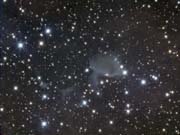 |
|
As Orion sank into the murk, I then turned my attention to Messier 95 barred galaxy in Leo. I had captured a monochrome image in 2008, but felt it deserved some colour attention. Unfortunately data capture was cut short by cloud cover, but I got just about enough for a reasonable image.of this relatively bright object. Optics as above, luminance 9 x 10 minutes, RGB each 4 x 10 minutes all binned 2x2. Full size |
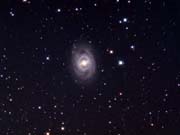 |
|
NGC2281 is a medium sized magnitude 5.4 open cluster in Auriga. As bright as the better known Auriga clusters, but not as dense. I first imaged it in 2009 as a test of my Canon 350D DSLR camera, but resolved to give it closer attention with the QSI camera in January 2019. A couple of false starts due to inclement weather, but eventually a clear night on 30th January finished the job. QSI683 on Meade 127 refractor. Luminance 14 x 5 minutes, RGB each 6 x 5 minutes,all unbinned. |
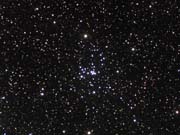 |
|
The total Lunar Eclipse of January 21st 2019 was to be the last fully visible from the UK until 2029, so fingers were firmly crossed! Although the weather in general was very poor during December 2018 and January 2019, I was fortunate with sky conditions, and managed to image the eclipse right through to the exit from the Umbra. Unfortunately although the sky was decently clear for totality it hazed over as time progressed. Nevertheless I was able to capture a good selection of images. So here is a composite of before and after with the images in correct configuration and spacing to show the shape of the Umbra. This image appeared in the Astronomy Now magazine Gallery for March 2019 Larger image Canon 700 D on Meade 127 refractor (950 mm fl), all at ISO100 The exposure hour times and settings were: Before 0403 1/200th second |
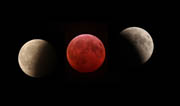 |
|
And here is a single image of Totality. This eclipse was not as bright as the previous one in 2015, and with thin haze not as stunning visually, but still a wonderful sight - a perfect demonstration of celestial mechanics in action! Larger image |
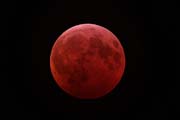 |
|
Comet 46P Wirtanen passed close to the Earth during December 2018, at its closest on 16th at which time it was also near Messier 45, The Pleiades. On that day and either side of the day it would have made a splendid wide field photograph - the comet was very bright - almost naked eye. Alas the weather did not cooperate, cloudy all three nights.The next really interesting encounter was the night of 16th January 2019, when it was due to pass almost directly over the interesting polar ring galaxy Arp 336 (NGC2685\) in Ursa Major. I kept my fingers crossed for a clear sky in the small hours (Moonset was not until 4 am on 17th) and for once the sky gods smiled on me and after a snowy cold front passed through it was beautifully clear for a couple of hours. By that time the comet core was approximately 10 arc-minutes from the centre of the galaxy. I used my Canon 700D on my 10" RC scope (2000mm fl) to try for some galaxy detail with a succession of 5 minute subs - any longer would show too much movement of the comet at that focal length. And this was the result. The galaxy really needed much longer exposures, but the polar ring is just visible. |
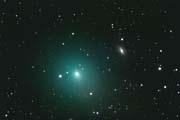 |
|
I already had an image of the galaxy from 2008 and there was enough detail and nearby stars to position it exactly in the main image. 16 x 5 minute subs, darks, flats and bias frames also used. Guided with my Lodestar on a Celestron off-axis guider. The two distant edge on galaxies in the lower part of the image are (reading down) PGC 25034 (mag 17.1) and PGC 25046 (mag 16.7) |
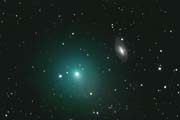 |
|
This is an animation of 16 frames. There is a slight jump, a couple of the originals were unusable. Larger version here (2.68MB). As you can see by tracing the path back, the coma would have passed over the galaxy. A pity there was a bright Moon - if it had been New, with full darkness at 6.30 pm on 16th instead of 4 am on 17th, the comet would have been at its closest to the galaxy at the start of the imaging run and I would have many more exposures and a much longer animation. |
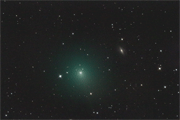 |
|
The night of 13th January 2019 started off with broken cloud and moonlight. I needed to try an experimental setup, so occasional clouds didn't matter. But as midnight approached and the Moon lowered in the West, the sky cleared beautifully! As usual it wasn't forecast, but I had the ancient open cluster M67 (in Cancer) on my repeat list, and as it was well placed and would just fit I reverted to my normal setup and went for it - too late for the longer exposure time required for a 'faint fuzzy'. Clouded over fully around 0300 but I had enough data by then. Luminance 7 x 5 minutes, RGB each 5 x 5 minutes, all unbinned with QSI683 and SX AO unit on RC10 Truss. Larger size |
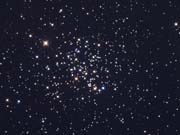 |
|
The disappointing December weather continued into January with a static cloudy high pressure system sitting over the British Isles. But this eventually cleared with a windy night on 7th January 2019. Despite the wind, I was able to capture King 20, a pretty Open Cluster in Cassiopeia. QSI 683wsg on RC10 with SX AO unit (which compensated for the gusty conditions, although my Observatory gave good shelter). Luminance 10 x 5 minutes, RGB each 5 x 5 minutes, all unbinned. Larger size A pity I didn't capture this before Christmas. With enhancements it's a pretty Christmas Tree! This image along with the enhanced version was published in the January 2020 issue of Astronomy Now |
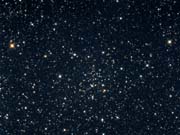 |
|
The night remained clear for another couple of hours before clouds returned, so I turned my attention to NGC663, another bright Open Cluster, also in Cassiopeia. Same optics as King 20, Luminance 9 x 5 minutes, RGB each 5 x 5 minutes all unbinned. Larger size |
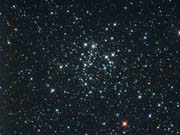 |
|
This image of the NGC691 galaxy group in Aries has proved a real struggle and a bit of a disappointment. Those who live in the North of the UK know what lousy weather we were experiencing towards the end of 2018. For me, only 3 opportunities for imaging over a month. Anyway I first attempted this on 14th November 2018. Started out beautifully clear only to cloud over after a couple of hours. Made a fresh start on 3rd December when I managed 6 Luminance and 3 each RGB subs before the clouds arrived. Then the night of 10th it was forecast to be clear all night. Turned out not to be. But I started as soon as it was dark and did get a similar batch of subs before the clouds arrived around 10.30 pm. Cleared for a little while and I started another target, but it clouded over again. So I packed it in and started processing. Sod's law it cleared again around 1.30 am, but I'd had enough by then ! Luminance 13 x 20 minutes unbinned, RGB each 6 x 10 minutes binned 2x2. QSI683 on Meade 127 (950mm fl) with TSFlat2 and SX AO unit. With that much data I'd hoped to get good detail and colour, but the seeing was never that good and there was always thin high haze. So a bit lacking in contrast etc. Enough precious time spent on a tricky subject - I've got something brighter and easier for the next opportunity! 'Mouse over' the medium sized image for identification of several objects, courtesy of Skymap Pro. The full size image is here, numerous unidentified faint small galaxies can also be seen. |
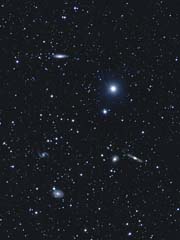 |
|
NGC 7640 is an almost edge on spiral galaxy in Andromeda. Reasonably large, but faint at magnitude 11.1 Interesting in that although there are no nearby galaxies, it appears somewhat distorted. If there has been interaction it must have happened a long time ago. Although the night of 1st November 2018 was forecast to be clear, I had another engagement, and would not be home until later on so would not be able to collect much data (full dark was at 6.35 pm with Moonrise at 11.55). But I decided to take a chance on leaving the system running with the dome motor in action, and it paid off - I set it away at 6.10 and when I returned 4 hours later all was well with the telescope only slightly off centre in the dome slot. I kept imaging until an hour after Moonrise - the 34% illuminated Moon was on the other side of the sky. In the end I only had to scrap one sub frame - the very first luminance which was taken when there were remnants of clearing clouds. So I ended up with 15 x 10 minutes luminance and 8 x 10 minutes each RGB, all binned 2x2. QSI 683 wsg on RC10 truss with SX AO unit. Full size This image appeared in the October 2020 issue of Astronomy Now, Night Sky section, page 78. Fortunately AN notified me that it had been used, but wrongly attributed to Frank Colosimo. |
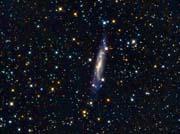 |
|
NGC 488 in Pisces is an unusual galaxy, mag 10.4 and quite small at 5.4'x3.9' with very tightly wound spiral arms. I'd seen an image by Adam Block, which as usual is excellent, and prompted me to have a go. But relatively low from NE England and proved difficult in mediocre seeing on the night of 17th October 2018 to tease out detail. Anyway, QSI 683wsg on RC10 with SX AO unit. Luminance 12 x 10 minutes, RGB each 4 x 10 minutes all binned 2x2. Lots of distant background galaxies. Rotated 90 degrees to give correct orientation and cropped from the original. Full size. |
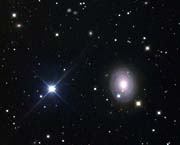 |
|
I first imaged the globular cluster M15 in Pegasus in 2008. But decided to revisit it in October 2018. The nights of 9th and 10th were forecast to be clear, and indeed they were, although a bit hazy. But the seeing on 9th was the worst I have ever seen from home, so that was a no go. Still pretty poor on 10th, but just good enough to try for the bright cluster. I would have liked better seeing and more exposures before the haze worsened, but this will have to do for now, certainly a considerable improvement on the 2008 effort. QSI 683 on RC10 wth SX AO unit. Luminance 11 x 5
minutes, RGB each 4 x 5 minutes, all binned 2x2. |
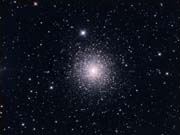 |
|
LDN 1235 is a dusty area in Cepheus. I hoped to capture it earlier in September 2018 at Kelling Heath, alas conditions did not play fair at all. But unexpectedly on the night of 17th September at home the sky cleared well for a few hours after midnight and I was able to collect a reasonable amount (tho' not enough - there's never enough!) of data before the sky started to lighten. I still wasn't entirely happy with the result, and when a clear night came along on 6th October I collected a completely fresh set of data over a longer period, and processed it without using any of the earlier data where I suspected a slightly misaligned camera. The popular name of the Dark Shark is pretty obvious! A bit of fun - an animated GIF here shows a basking shark image overlay. QSI 683 on TS 65 quad. Luminance 16 x 10 minutes, RGB each 6 x 10 minutes, all binned 2x2 |
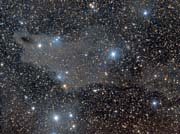 |
|
After a run of very poor nights both at home and at Kelling Heath, the night of 14th September 2018 gave me a few hours of good clear sky in the early hours. So as I knew Comet Giacobini-Zinner was approaching Messier 35, I decided to have a go. It was actually going to pass right across M35, but in mid morning - I wonder if anyone elsewhere in the world captured the passage. I started imaging around 1:30 am local time, but the target was very low at only 18 degrees altitude. Also in the East which is my worst light pollution area, looking towards Newcastle upon Tyne. So I waited, and eventually was satisfied with 10 frames around 4 am when the comet was at 40 degrees altitude, at which point the clouds arrived. So here is the result. Canon 700D on TS65 quad. 10 frames at 3 minutes and ISO1600. Processed using a combination of Deep Sky Stacker, MaximDL and Photoshop. The small very old cluster to the lower right of M35 is of course NGC 2158, with IC 2157 further to the right. Larger size. This image appeared in the December 2019 Astronomy Now Deep Sky section. |
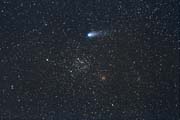 |
|
During week commencing 24th June 2018 I was fortunate in being on holiday during all the lovely clear Summer weather. Staying at the Tewkesbury (Gloucestershire) Caravan and Motorhome Club site, from where there was a good view of Tewkesbury Abbey tower, and each night Venus was seen passing above the tower. So I decided to try and photograph it. The night of 26th June was suitable, so I attempted to capture a photograph when Venus was above the weathervane, and indeed succeeded. No tripod, so I positioned the camera on a wooden railing - I had to chock the front up with a stack of coins to get the required framing, and use the 10 second timer to avoid camera shake! Time 2137 UT. |
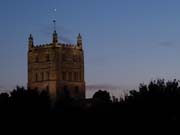 |
|
But then I realised that if I changed position and waited a couple of minutes, Venus would appear lower and closer to the Tower. And more by luck than judgement I got Venus peeking through the tail of the cockerel on the weathervane. Time 2140 UT. Larger size. For both images, Camera Panasonic TZ70. Exposures 0.625 seconds at ISO 400 and f5.6, zoomed to equivalent 35 mm focal length of 172 mm |
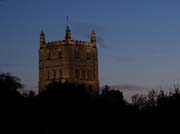 |
|
The night of May 13th was nicely clear, but only a small handful of targets were bright enough to visit in twilight. I decided to revisit the globular cluster Messier 53, previously imaged in 2005, but not very 'deep'. Seeing could have been better, but still a reasonable image so worth including here. QSI683 on RC10 with SX AO. Luminance 9 x 5 minutes, RGB each 4 x 5 minutes, all binned 2x2 |
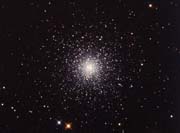 |
|
At my 55 degree latitude, as Summer approaches and twilight nights are here, I have to give up on galaxies. To be fair in early May I still have an hour or so of full dark, but not for much longer - astronomical twilight rules, and that only for a few more weeks. So until the narrow band Milky Way targets get cracking in July/August, I'm rather limited for choice. But on 6th May 2018 I spotted a pretty and quite bright (mag 7.8 ) open cluster NGC6939 in Cepheus which I first imaged in 2007, and then only monochrome. So decided it deserved a revisit. Not worried about bringing up very faint fuzzy areas, so relatively easy to process and no problems with sky glow noise. QSI 683 with SX AO unit on RC10 Truss. Luminance 8 x 5 minutes, RGB each 4 x 5 minutes, all binned 2x2. This image appeared in the July 2018 Astronomy Now magazine Gallery There is a remarkable coincidence in the positioning of the brighter stars around the edge of the cluster. They remind me of the main constellation stars in Auriga. So I set them up in Skymap and removed everything but the brightest stars. And click here for the result - Skymap star locations superimposed on my image. Mouse over the image to see the Skymap image. Absolutely no fiddling with the spacing of the stars other than getting the Skymap image to the same scale. Five out of the six brightest Skymap stars are in almost identical positions, and a slightly fainter star for the sixth. Indeed without the accurate overlay of Skymap you would think the relative spacings were identical! |
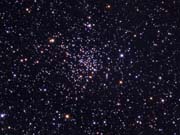 |
|
This fairly small mag 10.8 galaxy, NGC 3642, nestles in the bowl of the Plough/Big Dipper. I saw an image of it by Adam Block, here and thought it would be an interesting target. But WHY do I let myself get sucked in by images with a 24 inch (and later 32 inch) telescope 9000 feet above sea level in Arizona, when I am using a 10" telescope 680 feet above sea level in North East England? Generally doomed to failure. Because of the onset of twilight nights, it was going to be my last galaxy image of the season, at least faint ones anyway, so I bashed on under the few clear moonless nights remaining. At least the weather was kind that week. Needed a lot of data for the faint outlying areas, and with generally moderate to poor seeing - the jet stream had been right over us for some time, the finest detail was not to be. But lots of tiny distant galaxies also captured. QSI 683 on RC10 Truss telescope with Lodestar X2 and SX AO unit. Luminance 39 x 10 minutes captured on 14th, 17th and 18th April 2018, RGB each 7 x 10 minutes on the 20th. All binned 2x2. Full size. I guess we UK imagers must do what we can when we can! |
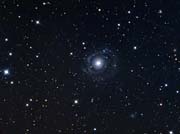 |
|
I first imaged M64 in 2005 with my Artemis 285 and Mirage 8. The 'Blackeye' galaxy in Coma Berenices, and well named! No flat frame then, and I was always a little unhappy with it. So I reckoned it was worth a revisit. And after all the snow, ice and clouds the weather relented on March 7th 2018, so before the Moon rose too high I squeezed in just enough data to be worth processing when added to a few frames collected on 16th February. QSI 683 on RC10 at f8 with SX AO unit. Luminance 11 x 10 minutes unbinned, RGB each 4 x 5 minutes binned 2x2. Cropped a little from the original to show North up - the camera was rotated 90 deg. to get a suitable guide star. |
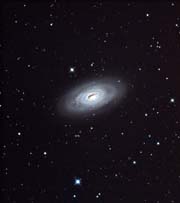 |
|
This is the first image of 2018 - into the second month - what rotten weather we had - mainly cloud, but to add insult to injury, when clear a very bright Moon. If you thought SH171 below was big, here's a monster! Situated at the top of the main Orion asterism (that's Betelgeuse and Bellatrix at the bottom of the image), Sharpless 264 spans a whopping 6 1/2 degrees. That's the equivalent of 13 full Moons. If one assumes a distance of 1500 light years, that makes it 170 light years across! I started trying to capture this in December 2017, but was constantly foiled by cloud. Eventually I managed to get some data on 21st. January and the rest on 6th February 2018. QSI683 on Canon 70-200L zoom lens at approximately 85 mm focal length. 13 x 20 minutes H-alpha (for luminance and colour) plus 5 x 20 minutes each OIII and SII. But very little colour in the latter two, so I've used H-alpha in the Red channel. Often known as the 'Angel Fish' or 'Alien Face'. Larger image |
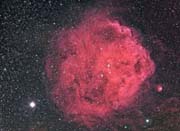 |
|
This is Sharpless 171 and its little friend SH170. A very large (around 3 degrees square) emission nebula in Cepheus, well placed for the lovely clear night on 27th December 2017 which although well moonlit allowed narrow band filters to do their job. I've messed around with colour quite a lot, but I think the monochrome stands up pretty well on its own. So here are both. Colour started off as the Hubble palette SHO for RGB. Incidentally the boundary between Cepheus and Cassiopeia passes right across 171, so 170 is in Cassiopeia. QSI 683 on Canon 70-200 f4 L zoom lens at 200 mm, with external mask to stop down to approx. f6 for crisper stars without 'starburst' diffraction spikes. Ha 16 x 20 minutes, SII and OIII each 5 x 20 minutes, all unbinned. Larger images: Monochrome, Colour The colour image appeared in the February 2018 Astronomy Now magazine Gallery I also imaged SH171 several years ago with my Artemis camera, but only monochrome, here. More recently a closer look here. Also more recently a close up of Sharpless 170, here. |
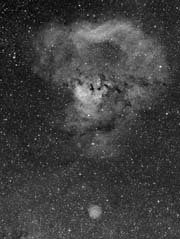
|
|
Van den Berg 31 is a fairly small reflection nebula in Auriga, but is associated with dark nebulae Barnard 26, 27 and 28. Also a much fainter dusty area stretching to the West. The night of Dec 18th 2017 started off with thin cloud, but eventually that cleared allowing me to capture enough data to produce a reasonable image albeit with poor seeing and limited contrast. But I had to go for it - lousy weather forecast here for the rest of that week and the Moon waxing. QSI 683 on TMB105 with TSFlat2 and SX AO. Luminance 10 x15 minutes, RGB each 4 x 15 minutes, all unbinned. Larger image Adam Block has a superb image here. With of course the 32" Schulman at 9000 ft. in Arizona. Still, might be worth a closer look with my 10" RC. It will have to be an exceptional night, but there's plenty of time yet. Watch this space... |
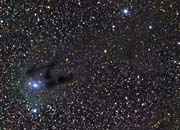 |
|
With clear (cold!!) nights weekend of 2nd December 2017, but a Moon around I went for a narrow band image of the interesting Sharpless 132 in Cepheus. And found that I already had a substantial amount of H-alpha data from 2016 which had never been taken further - no colour. So incorporated that in my image. Hubble palette (SHO). H-a 17 x 15 minutes, SII and OIII each 10 x 20 minutes, all binned 2x2. QSI 683 on TMB 105. Full Size |
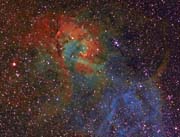 |
|
NGC2174, 2175, 2175S and IC2159 are all lumped together in Sharpless 252 in Orion. The Monkey's Head nebula is well known, and fairly bright, but I'd never imaged it before, and with very clean sky forecast for the night of 29th November 2017 it was on with the narrowband filters and get cracking. The North East coastal area clouds didn't clear until 11 pm, but after that it was all go. Despite an 82% illuminated Moon, the sky was so clean and steady that in conjunction with the filters all went very well. QSI 8300 with SX AO on Meade 127 (950 fl) refractor. SHO 'Hubble palette'. Luminance and Green, H-alpha, 9 x 15 minutes. Red and Blue respectively SII and OIII each 5 x 15 minutes. All unbinned. Processed mainly in Photoshop, using Bob Franke's method for colour. Displayed with North down - the usual orientation for this subject. Larger image |
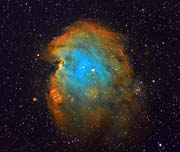 |
|
The weekend of November 17th saw a group of us at Calvert Trust, Kielder. Only one night was clear, Saturday 18th, but it was clear all night (and very cold and frosty!) There appeared to be a slight haze reducing clarity and contrast. So LBN 534 in Andromeda proved difficult to really show the nebulosity - so many stars! The bright cluster on the right edge towards the top is NGC 7686. Larger image. Luminance 13 x 15 minutes unbinned, RGB each 5 x 15 minutes binned 2x2. QSI683 and SX AO unit on TS65 quad and EQ6 mount |
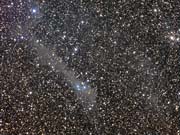 |
|
Later that night when I had enough data for LBN 534 I had a short session on NGC752, also in Andromeda but further East. Previously imaged with my Artemis 285 in 2006. Very long exposures not necessary for this large and relatively bright cluster, so a straightforward run. Luminance 8 x 5 mins, RGB 4 x 5 mins, all unbinned. Larger image. Same setup as LBN534 |
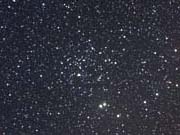 |
|
LDN 673 is an interesting dark nebula in Aquila, fairly close to Altair. Relatively faint, but lots of exposure in the dark Kelling Heath sky during the Star Party in September 2017 did a reasonable job. Unfortunately I wasn't able to get enough colour data during the week, and hoped for a chance at home before it was too late in the year. So this is a monochrome image. QSI 683wsg with SX AO unit and TSFlat2 on TMB 105 refractor. EQ6 Pro mount. 19th September 14 x 15 minute subs unbinned. Larger size |
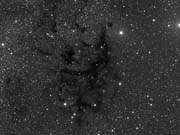 |
|
Persistent poor weather and other commitments prevented me getting more colour data before the target became too low in the West. I will have to try again in 2018. But for now I have used the limited colour data I did manage to acquire at Kelling Heath on 22nd September. Red 3 x 10 minutes, Green and Blue each 2 x 10 minutes. All unbinned. Larger size |
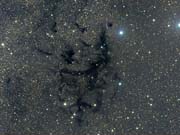 |
|
21st August 2017 saw a Solar Eclipse pass across central USA. Although totality was relatively short, around 2 min 45 secs maximum duration near the town of Carbondale Illinois, it was dubbed 'The Great American Eclipse' and was probably seen by more people than ever before. I was fortunate in joining a group organised by Omega Holidays which decided to watch from a site 'Menan Buttes' near Idaho Falls. 2 mins 18 secs, but chosen for its good weather prospects. And did not disappoint! Wall to wall cloudless sky and at the altitude of around 5000 ft. above sea level a crisp clear view. Second contact produced a beautiful diamond ring with Baily's Beads and prominences nicely visible. Canon 700D with 400 mm Canon L lens externally stopped to f 7.1 (see this description) unfiltered at 1/2000 second. Full size. We were accompanied by Pete Lawrence, Dr. Paul Abel, and the impressionist Jon Culshaw who introduced excellent presentations by the other two and was extremely entertaining! |
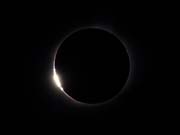 |
|
For totality I used a range of exposures from 1/400 to 2 seconds, and combined them in Photoshop to produce this image - a pretty close representation of what was visible through small binoculars. WARNING - it is safe to use unfiltered binoculars, but only during full totality. Even the diamond ring can cause serious eye damage when viewed through optical aids such as binoculars or a telescope. Larger image - approximately half size. There are several stars visible - star identification in this larger image. This image was Picture of the Month in the October 2017 issue and also appeared in the January 2024 issue of Astronomy Now |
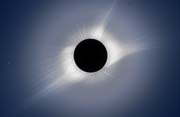 |
|
Here is fourth contact diamond ring, again clearly showing Baily's Beads and prominences. Full size. |
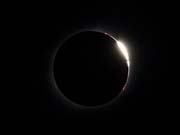 |
|
There were several small sunspots visible. Taken with a Solar filter of course (Baader film). Larger image |
 |
|
The sky was beautifully clear for the whole eclipse, so here is an animated GIF of the entire sequence. Click on the thumbnail for a medium size GIF (755KB) or here for a larger one (4.48MB) |
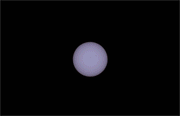 |
|
Earthshine, often seen when the Moon is recently new, is caused by light from an illuminated Earth lighting the dark part of the Moon as viewed from Earth - the equivalent of Moonlight. It was just visible in my 2 second exposure, so I have patched it into the composite here. Larger size. It is very unusual for a particular location to benefit from totality within a few years. But in April 2024 Carbondale Illinois is even closer to the centreline than on this occasion, and will experience over 4 minutes of totality - lucky them! I may go to that one, but will be approaching 81 years of age - maybe too decrepit or even gone by then! Time will tell.... |
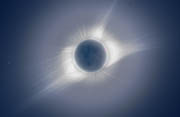 |
|
This interesting galaxy NGC 4151 (also known as ' Eye of Sauron') is situated in Canes Venatici, so nicely high at this time of year (Spring). But capturing the faint outlying areas was quite a challenge and with the limited number of clear skies I thought I might not finish it this season. But the weather smiled on me on the night of 24th April and I was able to get the rest of the colour data to add to that captured the week before. Luminance captured over two nights a month previously! So the final total was Luminance 24 x 20 minutes, RGB each 7 x 20 minutes, all binned 2x2. QSI683 on RC10 with SX AO unit. The two obvious smaller galaxies are NGC 4156 (the spiral) and UGC 7188 (mag 17.1) Full size This image appeared in the June 2017 Astronomy Now magazineGallery |
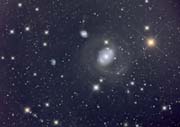 |
|
It has been many years since I imaged the quite small but bright open cluster, Messier 36 in Auriga, in monochrome with an SX MX716 camera! So although there was a bright Moon on the night of 12th April 2017, they were well separated and the sky was nicely clear, so indulged myself! QSI 683 with Starlight Xpress Active Optics unit on RC10 Truss. L 13 x 2 minutes, RGB each 6 x 2 minutes, all binned 2x2. Full size. |
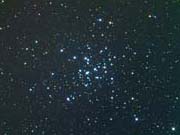 |
|
Inextricably linked by a gravitational bond, Galaxies NGC 3166 and NGC 3169 in Sextans have been disrupted by their mutual attraction. Reasonably bright at 10th magnitude, but the faint clouds of disturbed stars are not so easy. My location isn't too bad, but they never get very high from here (max altitude 40 degrees) and to show them well needs seriously dark skies. But I'm reasonably happy with this image. Anyway, the night of 28th February 2017 was the best long clear spell for ages, so worth a go and very welcome after a total washout at Kielder the previous weekend. The much smaller lower right galaxy is 14th magnitude NGC 3165. Full size QSI683wsg and SX AO unit on GSO RC10 truss. Luminance 18 x 10 minutes, RGB each 7 x 10 minutes. All binned 2x2. |
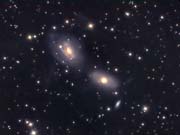 |
|
This image of the Medusa planetary nebula (Abell 21 or PK 205+14.1) in Gemini was a work in progress for a few weeks. Luminance 21 x 20 minutes captured on 28th and 29th December 2016, RGB each 6 x 20 minutes on 23rd January 2017. Also overlaid with Hydrogen-alpha, 9 x 20 minutes. All binned 2x2. Even with all that data it's a faint object at mag 14.1, surface brightness 16.4 and relatively low in the sky for me. So apologies for any remaining noise. QSI 683 with SX active optics on GSO10" f8 RC Truss. This image appeared in the March 2017 Astronomy Now Gallery Full size. Time I had a look at something brighter and easier! |
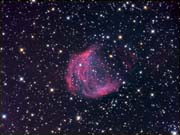 |
|
Now February 2024, and a bit of a play with this. I used StarNet to remove the stars, then subtracted the result from the original to leave the stars only. Reduced their size and increased their colour then pasted back the nebula also recoloured. Possibly a more pleasing image. Full size |
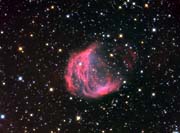 |
|
I first imaged Messier 77 (Cetus A) in 2004, but only the bright inner parts of this galaxy, failing to capture the faint outer areas. So vowed to return some time for much longer exposures. And some clear nights towards the end of December 2016 smiled on me. So here is the result. QSI 683 on RC10 Truss with SX AO. Luminance 10 x 10 minutes (from October 2014!) plus 14 x 15 minutes on 27th December. RGB on 28th December, each 4 x 15 minutes. All binned 2x2. North is left. Why did I use the October 2014 data? And why didn't I persevere with it then? Well, weather didn't help at that time, but for some reason there were extra diffraction spikes. I couldn't track down the cause, so decided second time round to do a fresh set. But there again were the spikes. And they were in almost all the frames except the last two. A total mystery, but no getting away from them, so I included the older data. |
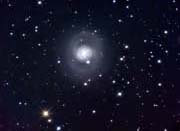 |
|
Well, it's taken me a little over two years to finish this one - first imaged in October 2014 after seeing this marvellous image from Adam Block. NGC 90 and friends in Andromeda. But the night of November 28th was crystal clear and although as often happens the clarity came with poor seeing, the SX AO unit helped to keep things reasonably crisp. And here is the final result. 'Mouse over' the medium image (click on the thumbnail) for names and magnitudes of many (though not by any means all!) of the galaxies. Luminance 11 x 15 minutes plus 8 x 20 minutes, RGB each 4 x 15 minutes. All binned 2x2. QSI 683 with SX AO unit on RC10 f8. Never going to match 32" at 9000 ft., but I'm quite pleased with it., indeed with the background darkened further, rotated and clipped it is now my computer desktop image. Full size Phew! |
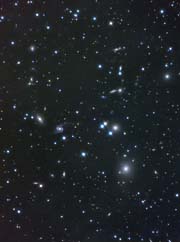 |
|
When I came across this image (and others) of this very interesting object, Arp227 (NGC474 and friends) in Pisces, I resolved to give it a go: But I soon found that although I have reasonably dark skies here they are not dark enough nor clear enough to do it justice - the background light pollution and imperfectly clear sky adds a lot of noise when stretched to show the outlying faint areas. I persevered over a couple of nights, 25th November 2016 being my best chance, but to no avail - when stretched as far as reasonable, only a hint of the outlying shells of stars and gas. This image is 25 x 20 minutes Luminance, RGB each 6 x 20 minutes, all binned 2x2. QSI 683 on 10" RC. I'll have to move to La Palma! The three larger galaxies (reading from left to right) are NGSs 474, 470 and 467. The two small edge on galaxies below and to the left of NGC 467 are PGC 4765 (the vertically oriented one) and PGC 4755. Later: There is an extremely deep image in a 2018 APOD here (Opens in a new page) |
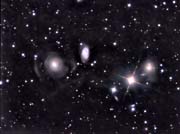 |
|
The night of 3rd October 2016 was clear for a few hours and I managed to get some data on NGC7789 - 'Caroline's Rose' in Cassiopeia before the clouds rolled in. QSI683 on Meade 127 with TSFlat2 and SX AO unit. L 9 x 5 minutes, RGB each 4 x 5 minutes, tweaked with Noel Carboni's actions. All unbinned. Full size (2 MB) |
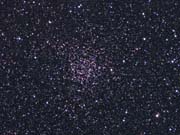 |
|
The 'Iris' nebula (NGC7023) in Cepheus is riding high at the moment, and is associated with substantial dusty areas. I hoped to image it in the dark Kelling Heath skies when there from 26th September to 2nd October 2016, but as those who were there will know there were very few opportunities, and I had to return on Sunday 2nd when it was forecast to be clear. But the clear sky also smiled on me at home, so I was able to fulfill my ambition after all! QSI 683 with SX AO unit and TSFlat2 flattener on TMB105. 12 x 10 minutes luminance, RGB each 6 x 10 minutes. Gentle tweak with Star Spikes Pro. All unbinned. Full size (1.2 MB) |
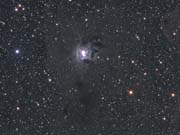 |
|
NGC 1502 in Camelopardalis is a small and relatively innocuous cluster, similar in size to the much better known and colourful Jewel Box Cluster in Crux. But its claim to fame is that it lies at the foot of the magnificent waterfall of stars known as Kemble's Cascade. After many cloudy nights, the evening of 5th September was unexpectedly clear and I was able to collect data for this beautiful combination of stars. QSI 683 on TS65 Quad . Luminance 13 x 5 minutes, RGB each 8 x 5 minutes, all unbinned. Enhanced star colours and spikes using Noel Carboni's actions and Star Spikes Pro to make this image really sparkle! This image appeared in the November 2016 issue of Astronomy Now magazine, and was the winning image in the 2016 UKAI Summer Clusters competition. Full size (1.4 MB!) |
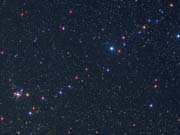 |
|
Spot 12579 followed the earlier groups and seemed to be developing, but as can be seen from these images taken on 23rd and 24th August 2016 it started to decay quite quickly. Unfortunately poor weather/lack of opportunity prevented further images and checking on the Kanzelhöhe Observatory web site a few days later showed the spots had disappeared altogether leaving only a slightly disturbed area.. Altair GPCAM2 mono on Quark and TMB 105 refractor. |
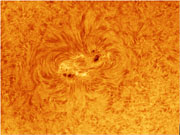
|
|
I posted the below GPCAM2 Solar images on the UKAI group Solar section, and came across highly detailed images obtained using a Daystar Quark 'eyepiece' Hydrogen-alpha filter. This filter fits on a telescope like a standard eyepiece, so can benefit by the resolution of a refractor larger than most small Ha dedicated telescopes like my Solarview50 without breaking the Bank! The built in Barlow lens substantially increase the focal length of the system, so with the small chip of the GPCAM2 only small areas of the Sun can be captured at any one time, but the potential for fine detail is there given good seeing conditions. So I bought one from Altair Astro complete with 2" energy rejection filter and interference eliminator to remove 'Newton's Rings'. And fitted to my TMB105 refractor it works very well. Still learning and finding the correct settings, but here are a couple of images from 8th June 2016 when the Sun decided to show itself briefly after days of cloud. Early evening so a bit low in the sky and only moderate seeing, but shows what the system is capable of. Need a good active sunspot to really show it off! Both images are of course stacks of 100 or more monochrome sub frames selected from several hundred using Registax6. Further processed and coloured in Photoshop. |
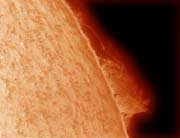
|
|
Another Jupiter, this time from 13th May with the GPCAM 2 on RC10 with 3X Barlow. I keep missing the Great Red Spot with the new camera - clouds not playing fair! |
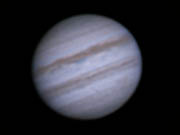 |
|
Transit of Mercury On 9th May 2016 there was a (relatively) rare transit of Mercury across the face of the Sun. Visible in its entirety from the UK. I set up two imaging systems on my Observatory mount, for white light my Canon 700D on Meade 127 refractor with Baader Solar film, for Hydrogen-alpha light my Artemis 285 on Solarscope50. Both set up with computer control to take an image every 5 minutes for the whole transit which lasted for just over 7 1/2 hours . Some problems unfortunately - exposure times for the Canon which were set too long at first - some unnoticed hazy cloud cleared after the initial set up, so early frames were over exposed. Then towards the end as the Sun lowered into horizon haze, the exposure times had to be increased again. More fortunate with the H-a, although the camera slipped at one point, rotating through 90 degrees, unnoticed for a while. Also unnoticed was a failure of the power supply to the Canon so 40 minutes were lost! Seeing was poor, so many frames were a bit fuzzy. But here is first contact with both cameras. Full size white light here. |
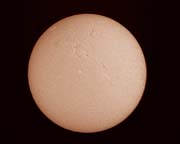
|
|
As Mercury progressed, seeing continued to vary, but I have selected frames which are as good as they get. Full size white light here. |
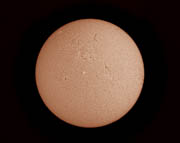
|
|
Unfortunately at the time of last contact, tree leaves and branches got in the way, and of course the low altitude did not help the seeing. But here is the result anyway! A couple of H-a images - the narrow wave band at the red end of the spectrum survives the thick atmosphere better. No full size for the white light, reddened and blurred by the low altitude (9.5 degrees).
I hope to produce a video of the full passage. probably in H-alpha, more interesting with the surface features. But correcting the rotation when the camera slipped will take a bit of doing, never mind processing and aligning each image. Watch this space! The next transit will be on 11th November 2019 in the afternoon,starting at 12:35 Only the first half of the transit will be visible from the UK before the Sun sets, but Mercury passes almost directly across the centre of the Sun. The following transit will be on 13th November 2032, already in progress at sunrise in the UK, ending at 12:07 If I live, I'll by 89 by then. Better hope for a clear afternoon in 2019! |
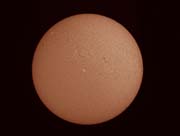
|
|
In early 2016 Jupiter was riding quite high. Unfortunately the terrible weather limited imaging time, and I sadly neglected the king of planets in favour of deep sky work when possible, not realising that it would not be as high again for several years. But the upper of the two images was taken on April 18th with decent seeing, using my venerable Toucam Pro web camera, stacked from a selection of 1200 frames taken over 2 minutes Around the same time a new 'planetary' camera was announced by Altair Astro, and I decided to purchase it. Here, but through Ian King Imaging. I was able to give it a good try out on a couple of nights, but poor seeing didn't help. The lower image from May 9th was the best, so here it is. Taken using the same RC10 telescope and 3x Barlow as the Toucam image, but apparently larger because the GPCAM2 pixels are smaller. The camera has a fast download, this image was stacked from 4600 frames, also taken over 2 minutes. The South equatorial belt shows an interesting block of cloud features in the centre. I've checked the original avi and it appears to be genuine. Time is running out for Jupiter - I may have another chance this year, but next time round it will be 12 degrees lower in the sky at best, dropping from 41 degrees altitude to 29 degrees. Not as high again until November 2023, then even higher at 48 degrees. But by that time if I'm still around I'll be 80 years old! In 2012 and 2013 Jupiter was around 50 degrees at highest, and if you look at the Solar System page you will see that the images around those years benefited from the extra altitude. |
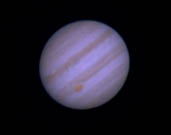
|
|
I don't know why I let myself get sucked in to imaging galaxies that have been beautifully presented by Adam Block. After all he has a 32" telescope 9100 feet above sea level in Arizona, whereas I have a 10" telescope 680 feet above sea level in Northumberland! But I see one that takes my fancy, and can't help myself! Anyway here is Adam's image of NGC 3344 in Leo Minor. As you can see it's a gorgeous face on spiral with a scattered rim. The rim is the tricky part! I managed to get data over a couple of nights - the second night of 8th April was a bonus, forecast poor, but stayed clear for a few hours. So my image consists of 19 x 10 minutes Luminance, RGB each 5 x 10 minutes, all binned 2x2. QSI 683 on RC10" Truss at f8 with SX AO unit. North is up. I positioned the galaxy off centre to pick up the small ones towards the bottom of the picture - around 18th magnitude. There are a few more dotted around, possibly even fainter. Incidentally for anyone who wants similar inspiration from Adam, you might find this page interesting:. |
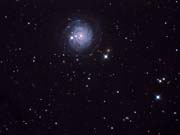 |
|
The evening of Wednesday 10th February 2016 was forecast to be clear, but started out cloudy. I was to be out for a couple of hours earlier and hoped to image the 'Question Mark' in Cetus, leaving the system running unattended, but it was not to be. But it did clear later and I had a go at another target, the interesting small mag 10.9 galaxy NGC 3504 in Leo Minor. Still not enough time to get a full set of data before again the clouds rolled in, but enough for a starter. As you can see it's unusual - distinctly barred and with a faint ring. The other face on spiral is mag 12.3 NGC 3512. A smattering of faint background galaxies. At the moment, 8 x 10 minutes Luminance binned 2x2, QSI 683 on RC10. Hopefully I will have an opportunity to complete the image this season. I was inspired to try for this by Adam Block's superb image here. And when I study that more closely I realise that the 'ring' is actually made up of two diffuse extended spiral arms. Fascinating! Perhaps it will be more apparent in my image when I have collected more Luminance and colour data. UPDATE After some weeks of poor weather and a couple of clear nights missed while I was on the Indonesia Eclipse tour, I managed to obtain more data including colour on the night of 31st March. So the finished image consists of 18 x 10 minute luminance and 7 x 10 minutes each RGB, all binned 2x2. |
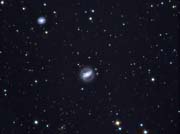 |
|
In early March 2016 we went on a trip to Indonesia - an organised tour which visited several places of interest including a *very* hot climb part way up Anak Krakatau! Hopefully I will get round to doing a travelogue. But the primary purpose of the holiday was to view the Solar Eclipse on 9th March. We were located in the courtyard of the Sultan's Palace, Ternate, a good open location with plenty of atmosphere - locals etc. At first contact the sky was beautifully clear, but there was a worrying patch of high cloud to the East. Unfortunately it moved across the Sun after about 30 minutes, and remained until 10 minutes after totality. It wasn't so thick as to block the Sun out altogether, but the outer corona was completely obscured. So my planned exposure sequence was out the window, and I just had to play seat of the pants as the cloud thickness varied, using live view on my Canon 700D. Despite taking some longer exposures (around 1.5 seconds), the cloud ruined them, and my best effort was this one. 0.3 seconds, 400L Canon lens externally stopped to f7, ISO 100. Just before third contact, a nice view of the large prominence and the start of Baily's beads at the top of the image. Cropped from the full frame. Full Size. This image appeared in the Eclipse feature in May 2016 Astronomy Now magazine |
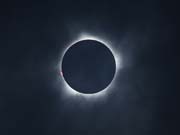 |
|
One of the group (the leader, Prof. Patricia Reiff) had a fish eye lens on a camera and took this image during totality. Venus is clearly visible, but it is also apparent just how much cloud was obscuring the corona. |
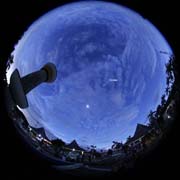 |
|
As I mention above, we climbed part of the way up Anak Krakatau - 'The Child of Krakatoa' which lies in the Sunda Strait midway between Java and Sumatra. You can see the path in this photo, it took us up around 400 feet of the 1000 foot volcano. Larger image |
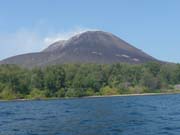 |
|
It was extremely hot, not just from the sun but from the volcanic heat underfoot. I just made it - I was suffering from a tummy bug and became quickly dehydrated despite carrying water with me. Larger image |
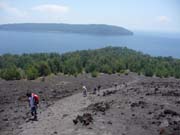 |
|
Because of my physical state I went down before the rest of the party, but after drinking more water and resting for a while was rewarded by the visit of a large (around 6 feet long) monitor lizard. Larger image |
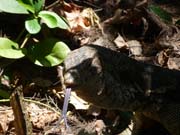 |
|
I've put this Krakatau section here for now because on 22nd December 2018 a large portion of the volcano slid into the sea, causing a tsunami which hit the coasts of Java and Sumatra without warning, causing the deaths of over 400 people with a further 40,000 displaced. This radar picture shows the huge amount lost - around 2/3rds of the mass and the height reduced from 340 metres to 110 metres. The area of collapse includes the path we climbed and the forest below. So the monitor will have perished, and probably any other life on the rest of the Island which is still erupting ferociously as I write this (29th December). |
 |
|
I first imaged NGC3953 spiral galaxy in Ursa Major in Spring 2015 with the 10" RC telescope, and at the time resolved to return to image the wider field which includes several smaller galaxies in line, including NGC 3917 ( the larger edge on galaxy). Eventually a couple of clear nights in January 2016 allowed me to capture Luminance (8th Jan) and RGB (11th Jan) with this result. QSI 683 camera with Meade 127 refractor TSFLAT2 flattener and SX AO unit. Luminance 16 x 15 minutes, RGB each 4 x 15 minutes. All binned 2x2. |
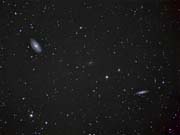 |
|
The end of September 2015 saw a week of stable High Pressure givng beautiful sunny days and clear nights although mist tended to thicken later in the nights. And this coincided with a particularly fine total Lunar Eclipse of a 'Super Moon' i.e. at its closest to the Earth in its orbit in the early hours of 28th. I used my Canon 700D on my Meade 127 refractor to obtain detailed images, a selection of these is in the montage showing the progress of the eclipse (from right to left). Larger image. As always click on the thumbnails for a medium size image. |
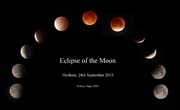 |
|
Close up of the fully eclipsed Moon. It is apparent that the lower part of the Moon is brighter - this is because it did not pass through the centre of the Earth's shadow, but was nearer the bottom of the main umbral shadow. And yes, those little bright dots are stars! The brightest is a double star, magnitude 7.8 Larger image. |
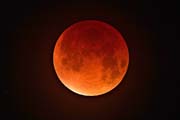 |
|
The low passage through the umbra is clearly seen in this triple montage where the crescent images are arranged to show the shape of the umbra with the totally eclipsed Moon in its relative position. Larger image. This montage appeared in the November 2015 and January 2019 issues of Astronomy Now magazine, and a section of the totally eclipsed Moon appeared in the North American Observing Highlights section of the January 2018 issue. |
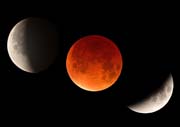 |
|
I also had my venerable Canon 350 set to take wide angle images on my EQ3-2 mount with a 50 mm Tamron lens. The star field was 3 x 3 minute subs, then the over exposed Moon was replaced with one from 5 x 5 second subs. The Moon was in Pisces and the 'Circlet' is clearly seen.All at f5.6 and ISO800. Larger image.
|
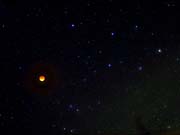 |
|
A couple of days before the Eclipse I was checking my 700D/Meade 127 setup and obtained this image of the Gibbous Moon. Had a play with it to bring up the colour for a bit of fun. So here it is. Larger image.
|
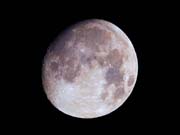 |
|
This image of the Pelican nebula, IC5070 in Cygnus, is the first image captured using my TMB105 refractor with the Teleskop Service TSFlat2 flattener which has enabled me to use the QSI 683 camera with that telescope - previously it would have been badly distorted in the corners. See the TMB page . The monochrome image is Hydrogen-alpha data using 20 x 10 minute subs binned 2x2, TMB 150, QSI 8300, Baader H-a filter from 6-7 August. The colour is mapped H-a to R, OIII to G and SII to B. The colour data, 10 x 10 minutes each OIII and SII was captured on the night of 11th August, but had to wait until 27th August for the Flats. Full sizes here: |
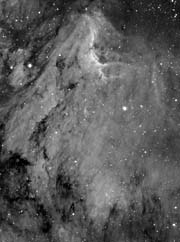
|
|
The 2015 Perseid meteor shower came at a time when the Moon was out of the way, and the night of 11-12 August promised to be dark and clear. So I set up my Canon 700D camera with 17 mm focal length lens on my tracking EQ3-2 mount in the hope of capturing some meteors. As is always the case of course they rarely obliged by passing across the field of view, but I captured two bright occurrences. The one at the top of the photo is almost certainly a sporadic, but that near the bottom is certainly a Perseid. Click on the thumbnail as usual for a medium size image, larger image here. This is of course a composite of separate photographs. |
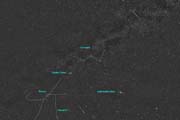 |
|
As the 2015 Summer progressed, Jupiter and Venus moved closer in the sky until on 30th June they were at their closest. For once the weather was kind with a clear sky down to the Western horizon. Initially I wanted a close up using my RC10 telescope. I had to squeeze that in quickly because the Western horizon from my Observatory is obscured by my neighbour's tall shrubs. But reasonably successful, although the sky wasn't dark enough to show the Galilean moons in other than a very overexposed image. This one is 1/10th second. Larger image.
I then moved into a neighbouring field with my camera and 70-200 mm Canon L lens on my EQ3-2 mount. That location gave me a clearer Western view, and I was able again to take several images as the pair moved ever lower in the darkening sky. This is probably the most effective with them just above trees. 1 second exposure, 70 mm focal length, f6.1 (approx.) using a mask to minimise starburst. All images with my Canon 700D camera at ISO200. Larger image. |
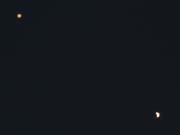
|
|
On 19th June 2015 the variable star section of the British Astronomical Association alerted members to the aberrant behaviour of the variable star V404 Cygni (RA 20 24 04, DEC 33 52 02 epoch 2000). The variable star V404 Cyg has just gone into outburst but there is more to it than that as V404 Cyg is an X-ray nova and a low mass X-ray binary (LMXB) with a black hole component. It also had outbursts in 1938, 1956, possibly in 1979 and in 1989. It has has been intensively monitored since then including by X-ray satellites. However, perhaps the most interesting thing about V404 Cyg is that observers have reported light changes of almost 2.5 magnitudes in less than 25 minutes! This was from mag 13.0 to mag 15.0. Most observers with moderate telescopes should be able to see an object of mag 13 visually and will then see this object disappear as it plunges down to mag 15 or so. However, there is every chance that V404 Cyg may yet increase in brightness and the rapid fluctuations should become easier to see. CCD observers should have no difficulty in recording these variations. It is amazing to realise the light is coming from close to a black hole situated at the centre of this binary system. Finder charts can be obtained from the AAVSO Variable Star Plotter at http://www.aavso.org/vsp where your specific orientation and field of view can be entered to suit. My friend Paul Jenkins who is a member of the BAA and had passed on the above to me suggested I might like to make my own observations. Although only twilight nights with clouds about, I was able to take two sets of around 60 x 1 minute images in the early hours and late evening of 21st. June. The resultant magnitude curves as plotted by Maxim DL are shown here, as is a composite of several of the frames showing the star. All images were taken using my RC10 and QSI camera binned 2x2. The plain lines are the reference stars, the red '+' line is V404. Full size image here. It should be noted that I was using a standard IR blocking Luminance filter, so not specifically designed for accurate photometric measurements. But of course it still shows the dramatic variations. The first choice filter for scientifically valid observations is a 'V' band filter. Maybe I'll get one! |
|
|
I did another run on this interesting star on 23rd June and got a little over 2 hours data with this result. Still very unusual behaviour - usually variable stars change slowly over several days or months, but this one is jumping all over the place. Skymap Pro puts its range as: Maximum magnitude: 11.5 (uncertain) Minimum magnitude: Fainter than 18.5 (uncertain) . I like the 'uncertain' bit! And a huge range of course, so at the moment it's at maximum outburst. Maybe have another look next year to see what it's doing then. I certainly wouldn't like to be living on a planet around that star - need a pretty thick shell! |
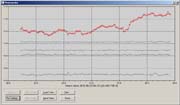 |
|
Although I had intended not to visit V404 again for some time, Roger Pickard of the BAA Variable Star section advised me to keep checking. The next opportunity was the night of 30th June which was beautifully clear earlier on when I photographed the conjunction of Jupiter and Venus. Unfortunately haze and clouds appeared later but I managed almost an hour of data. Alas the seeing was very poor indeed, so I was unable to obtain a crisply focused image, and had to increase the exposure time from 1 minute to 4 minutes to detect the now very faint star. It was apparent that it had faded back into obscurity as can be seen from the comparison image here. Although I did a Photometry graph, (again using a Luminance filter for comparison with the earlier graphs), the combination of the poor seeing, hazy sky, faintness of the star and a bright Moon only two days from full means that the magnitude readings can only be taken as a general guide. But to fade from 12th to 17th magnitude in seven days is dramatic to say the least! |
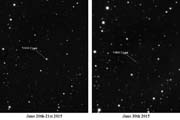
|
|
I'm quite enjoying these astronomical twilight nights - another beautifully clear one on 16th May 2015. A pity we couldn't have had more of them during the previous Winter. But although clouds arrived later and prevented me finishing my M16, I was able to complete a full set of data for Messier 12 bright globular cluster in Ophiucus (which I started three days previously). Replaces an earlier attempt in 2005. More colourful than I expected! Luminance 25 x 2 minutes, RGB each 7 x 2 minutes, all binned 2x2. QSI 683 with SX AO unit on RC10. Full size This image featured in the August 2015 issue of Astronomy Now magazine. |
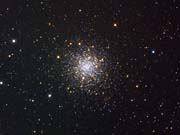 |
|
At my latitude, Astronomical twilight is now the best I get, and even that gives way to Nautical twilight for a few weeks at the height of Summer. So imaging is strictly limited to bright objects, or some narrow band subjects. But the brighter Globular clusters are still a nice target in Astro twilight, and the night of 12th May 2015 was particularly clear so a couple of hours were devoted to Messier 92 in Hercules. My previous image was taken in 2003, monochrome with an MX716 camera! So overdue for an update. The chip in that main imaging camera is now used in the Lodestar guide camera. How things have moved on! The old one was 40 x 20 second subs unguided on an LX90. The new one, Luminance 21 x 2 minutes, RGB each 7 x 2 minutes, QSI 683 on RC10 guided with LodestarX2 and SX AO unit. All binned 2x2. Full Size A bit of a difference! |
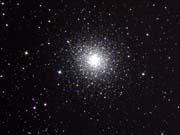 |
|
After I'd collected that data, I had a quick look at M16, the famous Eagle nebula in Serpens. Only 5 x 10 minute binned 2x2 H-a subs as nautical twilight was fast approaching, but if there are a few more clear nights before I lose astro twilight I may get some more data. It's very low for me, never rising above 21 degrees altitude, so seeing is poor - I don't expect ever to get a crisp image here. But still worth a visit! Full Size |
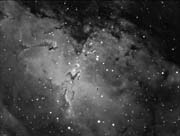 |
|
It's been a l o n g time since I imaged a globular cluster, and a particularly long time since I imaged Messier 5 in Serpens. That image is here. I have never before imaged Messier 10 in Ophiuchus. It follows M5 across the sky about an hour and 40 minutes behind. The night of 26th April 2015 was particularly clear and despite a bright first quarter Moon the sky away from the Moon remained decently dark. These bright globulars are a joy to image - only 2 minute subs needed so much of the star colour is retained. I had to wait a while for the targets to rise - they are quite low at my location, and for Messier 5 I perhaps went a bit over the top with Luminance at 20 x 2 minute subs, which left me a little short of time for colour and M10 data. But I persevered, and although by the time I had finished M10 I was half an hour into Astronomical twilight I could still easily see the Cygnus Milky Way in the clear air (the Moon had set by then). So M10 has 15 x 2 minute Luminance subs. For both globulars 6 x 2 minutes each RGB. All with the QSI 683 and SX AO unit, binned 2x2 on RC10 at f8 native resolution. |
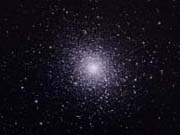
|
|
The Sun has had a relatively quiet cycle this time round, but on 23rd. April 2015 it sported a huge prominence which I was able to capture. Artemis 285 on Solarview50 Hydrogen-alpha telescope. Interestingly when I came to process the images I noticed I had another folder labelled April 23rd. BUT it was from 2006, when again there was an enormous prominence!! Quite a coincidence!! It can be found here. |
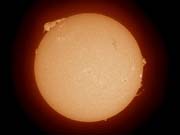
|
|
A flight of fancy! I see a strange caterpillar like creature crawling around the rim of the Sun to reach its offspring which is looking eagerly towards its parent ;-) |
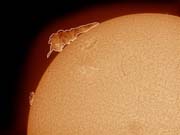 |
|
A few days later (27th April) the prominence had rotated onto the face of the Sun, with only a faint tail of the filament showing as a prominence - only just visible in this image, I was fighting clouds! |
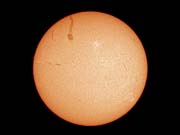 |
|
The run of fine weather in April 2015 continued for yet another clear night - 3 in a row!! Alas the Moon was starting to wax but the night of 22nd April was clear and steady, so I revisited the barred spiral galaxy NGC 4725 in Coma Berenices, previously imaged in 2007 with my Artemis camera. This bright (magnitude 9.3) galaxy is particularly unusual in having only one spiral arm. The smaller neighbouring galaxy is NGC 4712, and is unrelated, being much further away. QSI 683 on RC10 at f8. Luminance 10 x 10 minutes, RGB each 4 x 10 minutes, all binned 2x2. Off-axis guided with Lodestar X2 and Starlight Xpress AO unit. North approximately up in this orientation, governed by the requirement for a suitable guide star. |
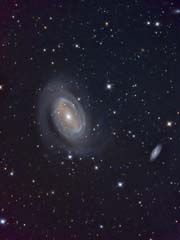 |
|
Abell 1656 is a densely populated galaxy cluster in Coma Berenices containing numerous small NGC galaxies as well as dozens of fainter PGC galaxies. NGC 4884 is the brightest at magnitude 11.5. I have labelled several of the brighter NGC ones in a 'mouseover' image, click on the thumbnail. 21st April 2015 was again a still clear night and I used the little TS Quad 65 for this rich field image which consists of 14 x 10 minutes Luminance unbinned, and 7 x 5 minutes each of RGB binned 2x2. QSI 683 camera. Close study of the Larger image will reveal many more tiny galaxies. |
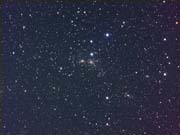 |
|
On 20th March 2015 there was a Total Solar eclipse in the North Atlantic. Unfortunately the line of totality did not pass over the UK, but from my Northumberland location the Sun was 92% eclipsed - a substantial partial eclipse. But as usual the fickle UK weather did not play fair! Maximum eclipse occurred shortly after 10.30 am. The previous day had been beautifully clear all morning, alas this was not the case on eclipse day with substantial cloud cover. Nevertheless I was all set with both white light and Hydrogen-alpha filters set up in my Observatory. First contact was completely obscured, but eventually the clouds started to thin and not only was it safe to view direct, I was able to take unfiltered photographs with my Panasonic TZ5 compact camera at full zoom, this was one of the better ones. |
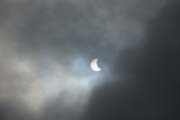 |
|
As time passed, the clouds thinned further and eventually I was able to start taking images with the filtered cameras. These 'white light' images were taken using Baader Solar film and my Canon 700D on my Meade 127 refractor (950 mm focal length). Maximum eclipse and nearing the end of the eclipse. There is an MP4 video here showing the sequence of all the useable frames. |
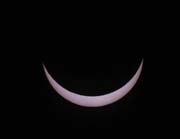 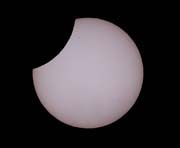 |
|
I also had my Artemis 285 camera fitted to my Solarview50 Hydrogen-alpha telescope, again these are maximum and near the end. There were some interesting prominences and filaments. Also an MP4 video here. |
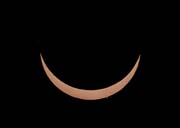 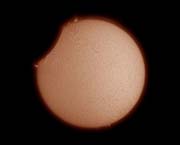 |
|
On 2nd March 2015 I was doing some tests with the forthcoming partial eclipse in mind, and spotted this substantial detached prominence. Rather faint, hence the stretched background. But interesting! It would seem that I caught the start of a major Coronal Mass Ejection. I took my image around 1430 UT, the 'official' image was an hour later. The link referred to in that image is not active on my site, but this YouTube offering shows the progress of the CME very well, although I do not know how long it will be available. It opens in a new window - YouTube does not like frames! Artemis 285 on Solarview50. Combination of 20 x 0.01 second exposures, processed in K3CCDTools and Photoshop. |
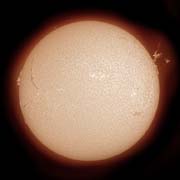
|
|
On the evening of 20th February 2015 Venus and Mars were joined by a thin Crescent Moon in the Western Sky. This image is a composite of two separate exposures - strips of cloud meant that unfortunately not all were properly visible together at any time. But I think it came out ok. The Earthshine on the Moon is particularly striking! Larger image Canon 700D, 15 second images with 70-200 mm lens at 200 mm and f6.3 |
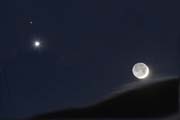 |
|
I first came across this interesting Camelopardalis galaxy, NGC2655 also classified as Arp 225, in October 2014, and collected several monochrome subs. But ran out of time and sky to finish the job. This has been a very poor season with few imaging opportunities, but the night of 16th February 2015 was beautiful, and although I had a previous engagement and wasn't able to start imaging until 22:30, I was able to keep going the rest of the night - the target is only 12 degrees from Polaris, so at my 55 deg latitude stays nicely high all night. The main body of the galaxy has very little structure - quite uninteresting. But what makes it special is the surrounding clouds of displaced stars. Difficult to bring out from the background - really needs a dark mountaintop! But I ended up with a total of 35 x 10 minutes Luminance subs, all binned 2x2. Colour is from 5 x 10 minutes binned subs for each of RGB. All with QSI 683wsg and Starlight Xpress AO on 10" RC Truss (2000 mm fl). Full Size. The central section of this image containing the galaxy appeared in the December 2018 issue of Astronomy Now in an article about Northern galaxies. |
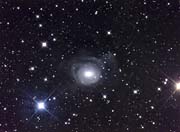 |
|
Those of you who haven't already seen this marvellous image by Adam Block, have a peek now. And do look at the full size image. It is now my computer wallpaper, cropped to fit my monitor screen. Taken at 9000 ft. in Arizona with a 32 inch telescope, an image of that quality is far out of reach of aspiring UK imagers (unless using remote telescopes of course). But an interesting cluster, and I hope to get an acceptable version this season. So far only one attempt, poor seeing and thickening haze, but 10 x 15 minutes exposures on 28th October gave me this monochrome image for starters. QSI 683 with SX Active Optics, binned 2x2 on 10" RC Truss. NGC90 (the face on spiral) is located in Andromeda just East of the great square of Pegasus, so nicely positioned for November and December. Fingers crossed for many steady clear nights! Full size |
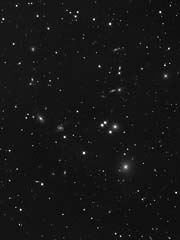 |
|
This interesting but faint dusty nebula, Barnard 175, is situated in Cepheus, and needs a fair bit of data to show up, but the nights are getting longer ;) High overhead this time of year, so with a clear night forecast for the night of 21st October 2014, hopefully the first of many this season, it was one to go for. North approximately at the top. The bright nebula at the tip is van den Bergh 152. QSI 683 on Meade 127 refractor with AP67 reducer, approx. focal length 760mm. Luminance 10 x 15 minutes, RGB each 4 x 15 minutes, all unbinned. Larger image. At this angle, to me it strongly resembles a horse's foreleg, complete with a shiny horseshoe and 'feathers' - horsey people will know what I mean. How about (with tongue in cheek for the famous cousin) naming it the 'Horse Leg' Nebula? |
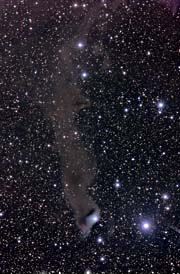 |
|
The night of 1st October 2014 was nicely clear although seeing was mediocre. But the iconic Owl/ET nebula, NGC457 in Cassiopeia was high overhead so made the best of the conditions. And such a bright target does not demand long exposures. I guess I'll get used to the diffraction spikes from my RC10! This replaces an image from 2009. QSI 683, RC10, Luminance 15 x 2 minutes, RGB each 7 x 2 minutes, all unbinned. Guided with SX AO. This image appeared in the December 2014 issue of Astronomy Now magazine. |
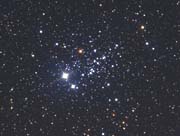 |
|
While envying those fortunate enough to be at the Autumn 2014 Kelling Heath Star Party who had an amazing night on Friday 26th September, nevertheless the skies here at Hexham were not too bad, and although struggling with an injured leg which had prevented me going to Kelling I was able to operate my new RC10 in my Observatory. It helps to have Teamviewer so I could sit in the house in relative comfort! Rather hazy in the earlier part of the night, but crisped up later. First target was the pretty planetary nebula NGC 7094, less than 2 degrees East of M15 in Pegasus. Quite faint at mag 13.5, and the haze reduced the contrast. Seeing only moderate, but I managed to bring up reasonable detail. Luminance 7 x 10 minutes, RGB each 3 x 10 minutes, QSI 683 on RC 10, all binned 2x2. I would have liked more data, but the target was already crossing the meridian when I started imaging, and was falling into haze. Full Size |
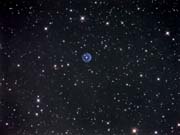 |
|
But as the night progressed, the clarity improved. I had more time available for my next target, Messier 74 in Pisces. Previously imaged several years ago, but deserved a revisit. As the clarity improved, so the seeing deteriorated slightly, but the brighter target (although M74 has low surface brightness) helped to compensate. Luminance 12 x 10 minutes unbinned, RGB each 5 x 5 minutes binned 2x2. Same optics for both. 2 metres focal length, but admirably guided with a Starlight Xpress AO unit. Larger Size |
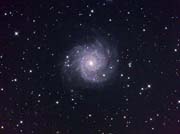 |
|
First light of my new RC10 telescope took place on 21st September 2014 after a long spell of awful murky weather. Far from pristine, with a lot of haze so I chose a bright target. Didn't bother with colour, here is the monochrome. The classic 'Dumbbell Nebula ' M27 in Vulpecula, 7 x 5 minute subs unbinned, darks and flats applied. QSI 683 on 10" RC (f8). Guided with Lodestar and Starlight Xpress AO unit. Very promising, just a little distortion in the top left corner as witness the diffraction spikes. May be a small amount of camera tilt - need to check the adjustments. But I think a very satisfactory first light. Large image |
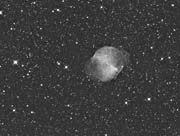
|
|
Despite the haze, seeing was good, and I was very pleased with the definition of the nebula. So used the colour data from an earlier image to complete the picture. |
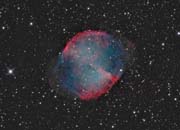 |
|
Comet C/2014 E2 Jacques moved through Cassiopeia towards the end of August. I was at Dalby Starfest over the weekend of 23rd August, and had a go then, but had guiding problems. BUT as the forecast wasn't too good, came home early on Sunday instead of Monday. And was very lucky with the clouds - just North of the Northern edge of a weather front, so had a lovely clear night until the mist formed around 2 am. So got lots of images of the comet, 50 subs in total. I was using my Meade 127 refractor and Canon 700D camera,
and at the focal length of 950 mm the comet was very fast
moving. So I set the ISO at 3200 and used 90 second frames.
Which seems to have worked quite well. the only down side is
that the tail disappears out of the bottom of the image - I
should have had the comet nearer the top of the frame, but
at the time didn't know which way the tail was pointing or
how long it was. The brightest star in the image is 7th
magnitude Tycho catalog number TYC 4028-489-1 (Hipparcos
number HIP 3267) The main image is a stack of 20 subs, using the clever comet stacking feature in Deep Sky Stacker. Also heavily processed better to show the tail. Two animations using all 50 subs, here just very small GIFs, one with the comet moving against the background, the other with the comet stationary and the background moving. There are larger mp4 versions on my web site, best viewed using Windows Media Player unless you have the latest QuickTime Plug in installed: |
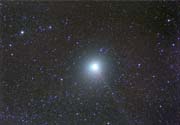
|
|
Messier 16 in Serpens, better known as the Eagle Nebula and made famous by the iconic Hubble image of the 'Pillars of Creation' never rises higher than 21 degrees at my location, and to add insult to injury only during the Suumer months when I have predominantly twilight nights. I last imaged it in 2005, and reckoned it was time for another visit. A couple of clear still nights in early July (with a first quarter Moon in the West) gave me an opportunity to collect some Hydrogen-alpha data, the narrow band filter making the best of the difficult conditions. Only 3 sub frames on 7th July - the clouds rolled in, but a further 8 on 9th July. I now have to wait a couple of weeks until the waxing Moon (full on 12th) moves past M16 and far enough away to allow collection of OIII and SII data for a full colour image. But for now here is the monochrome version. 11 subs of 10 minutes, QSI683 with Baader 7 nm Ha filter, unbinned on Meade 127 refractor. |
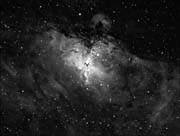 |
|
Eventually in the early hours of 9th July I was able to obtain colour information. OIII and SII each 5 x 10 minutes. Applied as the 'Hubble palette' RGB = SHO. The result looks a bit strange - the preponderance of Ha light means that it is difficult to avoid overpowering the central section. But for what it is worth.... |
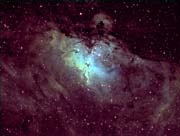 |
|
Supernova in M106 SN2014bc More information here. I heard about this a week or so after it was announced, and presumed with our lousy weather up North that I wouldn't get a chance to go for it. But the night of Friday 30th May was clear, so despite only astronomical twilight had a go. Further handicapped by the fact that I have sold my 12" Meade 'big gun' and am waiting for its successor. So brought my 5" Meade 127 refractor into play (950 mm focal length). Well of course refractors have no central obstruction, so that helps. And surprisingly with careful processing there it is. Very close to the core, but I've compared my image with the discovery images and I'm sure that's it. Just monochrome, 9 subs x 10 minutes, QSI 683 unbinned. The close up is doubled in size from the original, better to show the supernova. The galaxy lower right of the main image is NGC 4217. |
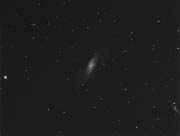
|
|
This image shows the relative sizes as seen from Earth of the recent Jupiter and Mars images. Of course the true size of Mars is such that several would fit inside the Great Red spot! |
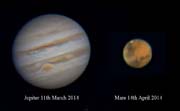 |
|
Spiral galaxy NGC 3521 in Leo is surprisingly not a Messier object despite its bright 9.2 magnitude. But worth visiting, not just for its overall appearance but also for the faint halo of stars, beautifully captured in this APOD image. Alas my UK skies are not so favourable, but I have a hint of the 'bubble'. This image was some time in the capturing! I first visited it on 14th April 2012, but only managed 3 x 20 minute subs. Then overlooked it until 24th March 2014, one of very rare clear nights in this awful season. So the final image consists of Luminance 3 x 20 minutes + 7 x 10 minutes, RGB each 5 x 10 minutes, all binned 2x2. QSI 683 on Meade 12" at 2600mm. The image is cropped from the original combination - there was some misalignment between the 2012 and 2014 images (I didn't realise I had the 2012 images until after getting the 2014 data) and due to the position of the guide star it was off centre anyway. North is to the right. |
 |
|
The night of 10th March 2014 was clear and crisp, so despite the presence of a waxing gibbous Moon I imaged the elliptical Leo galaxy Messier 105 and it's associated elliptical NGC 3371 and colourful disturbed galaxy NGC 3373. M105 is the one towards the bottom of the image, right is North. I wanted these for insertion into the Stellarium planetarium program. Despite the bright Moon I was able to reduce the background sufficiently to make this a 'keeper'. But will probably return next opportunity! Because of the bright background I stayed with 2x2 binning and short exposures. Luminance 22 x 5 minutes, RGB each 7 x 5 minutes, QSI 683 on Meade 12" at 2600 mm. |
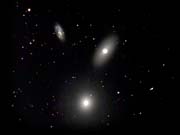 |
|
Cone and Foxfur in Monoceros, or if you prefer, NGC 2264 and associated nebulosity! With our truly awful weather, this has been on the go since the end of December 2013. (Early monochrome image below). But I managed to get the last bit of data on the night of 20th February 2014, and here is the result. An area I've been after for some time, but never had the right combination of camera and optics until the last year or so. QSI 683wsg with Starlight Xpress AO unit on Meade Series 5000 127 refractor. Luminance 17 x 15 minutes, RGB each 9 x 5 minutes binned 2x2. Larger image. Phew! |
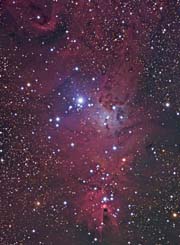 |
|
In January 2014 a supernova appeared in the bright nearby (11 million Light Years) galaxy Messier 82. soon classified as a type 1A, and named Supernova 2014J. I first heard about it on 22nd January and determined to image it. As always click on the thumbnails for a larger image. This image featured in the article on this Supernova in the March 2014 Astronomy Now magazine, and also appeared in the April and May 2014 issues.
As luck would have it, 23rd January was the first clear night for a long time, and of course I was out for dinner with friends I haven't seen for some time. Typical! However I managed 3 subs before going out and another 8 on return. Only monochrome subs - the clouds rolled in around midnight, so I used the colour from a previous image which I also used for the animation. Large image
The new image was 11 x 5 minute subs. QSI 683 on Meade 12" at 2600 mm. The supernova measured at magnitude 11.3
The monochrome image is a crop from the calibrated but only linear stretched combined frames showing the true magnitude of the supernova relative to the galaxy. Pretty bright! |
|
This has to be shaping up to be an even worse season than last winter - at least in NE England. A continuous succession of gales, rain and cloud with only glimpses of Sun or Stars. But Christmas Day was decent and I managed a few hours imaging that night. The first image is the result. Messier 77 and NGC 1055 galaxies lie quite close together, but are very different in appearance,. In the past the two bright stars 'above' NGC1055 meant I had difficulty imaging with my SBIG camera because of blooming. But now my QSI 683 is anti-blooming so no problems there. The bright blue star at the right hand edge is 4th magnitude delta Ceti, the small galaxy to the left is NGC 1072. QSI 683 on Meade series 5000 127 refractor (950 mm focal length). Baader LRGB filters, SX AO unit. Luminance 13 x 10 minutes unbinned, RGB each 5 x 5 minutes binned 2x2. As always more data would have been nice, but it's a bit late in the season for them - they were dropping into slightly hazy sky and the subject is fairly low for me. Better than nothing! Larger image The next very brief window of opportunity was on 30th December. I've always wanted to image the Cone and Foxfur nebulae in Monoceros (the only previous attempt was in 2006 here) but again the very bright stars of the associated open cluster (NGC2264) caused problems until I got my QSI camera. Even so, I only managed 5 x 15 minute Luminance subs before the clouds rolled back in. And again there was slight high haze. Needs many more hours data, but it's a start, and the subject will be available for several weeks yet IF the skies ever clear. Same optics as above. Larger image North is up in both images. |

|
|
Although the Canon 350D picture of the Hyades, Pleiades and California nebula (below) was quite pleasing, I was disappointed with the rendering of the California nebula. The night of 5th December 2013 was set to be clear all night - one of the very few this season, so I set to with my QSI camera. Originally outside on my EQ3-2 mount, but the weather was still very blustery after the severe gales of the morning (which cut off our electricity for 8 hours - fortunately it was back on in the evening!) so I had to admit defeat and move the camera onto my Observatory mount. QSI 683 with Tamron 17-50 zoom lens at 35 mm and f5.6 Luminance 11 x 10 minutes, RGB each 4 x 10 minutes binned 1x1. I also took 6 x 15 minutes Hydrogen-alpha to pick out detail of the California nebula. This was then used for both luminance and colour of the nebula. The brighter stars were already showing 'starburst' effects from the lens diaphragm, so I lightly enhanced them further using Star Spikes Pro. Large image here, annotated with constellation lines, some stars and deep sky objects here, or 'mouseover' here (if your mouse has a wheel use it to scroll the annotated image without losing the annotations.) |
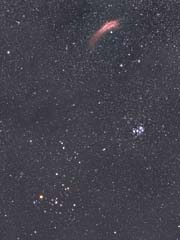 |
|
In the UK the Milky Way is at its best in late August when the skies are dark and part of Sagittarius is visible. But later in the year it can still put up a wonderful show, and although I am on the edge of the Hexham 'light dome' a clear night gives me a good view from my back garden. This image was taken early in the evening of 22nd November 2013 before the Moon rose. It consists of a two frame mosaic, the top third or so being added to a full frame lower section to include all of Cygnus. Canon 350D modded for Hydrogen alpha with Tamron 17-50 f2 lens at 17 mm and f5.6. Lower section 6 x 5 minutes, upper 5 x 5 minutes all unguided on my EQ3-2 mount. With the mount tracking the sky, the horizon was very blurred, so I later patched in a static shot clearly showing my Observatory and skyline. This is correctly positioned - a crop from the original stacked image is here. Processed with Deep Sky Stacker and Photoshop, brighter stars slightly enhanced with Star Spikes Pro. Large image here, annotated with constellation lines, some stars and deep sky objects here, or 'mouseover' here (if your mouse has a wheel use it to scroll the annotated image without losing the annotations.) |
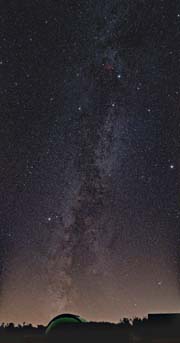 |
|
The night of 9th November 2013 was beautifully clear, so while waiting to try again for comet ISON I turned my attention to Messier 33 - always worth a visit! QSI 683 with SX AO unit on Meade 127 refractor. Luminance 12 x 10 minutes, RGB each 4 x 10 minutes, all unbinned. Large image (1 MB) |
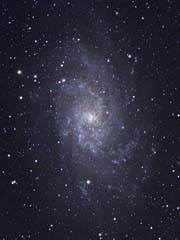 |
|
This wide field image mainly of theTaurus region taken on 3rd November 2013 while waiting to image Comet ISON, shows the Hyades cluster with the bright red star Aldebaran, the Pleiades and sneaking in at the top the California nebula in Perseus. 10 x 10 minute sub frames with modded Canon 350D and Tamron 17-50 zoom lens at 44 mm and f5.6. The open cluster to the left of the Hyades is NGC 1647. Large image (840 KB) |
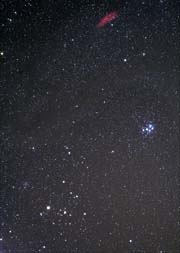 |
|
This image, taken on 3rd November 2013 contains a number of Van den Bergh reflection nebulae, VdB12, 13, 16 and 17 (NGC1333) in Perseus. 'Mouse over' the medium size image for names (click on the thumbnail). QSI 683 on the TS Quad refractor (420mm). Luminance 10 x 15 minutes unbinned, RGB each 5 x 10 minutes binned 2x2 Large image (950 KB) |
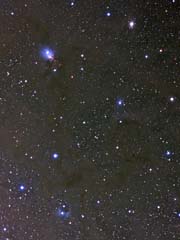 |
|
The dark nebula Barnard 173-4 in Cepheus is extremely thick in places, completely blanking out background stars. This image was taken on 26th October 2013, using the QSI683 and Meade 127 refractor (950 mm fl) with Starlight Xpress Adaptive Optics unit. Luminance 15 x 10 minutes unbinned, RGB each 5 x 5 minutes binned 2x2. Full Size (775KB) |
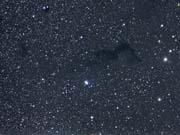 |
|
The night of 7th September 2013 was beautifully clear and just got better as the night went on. I did an imaging run with my 70-200 lens on the North American and Pelican nebulae with an f6 exterior mask similar to this one. Nice field of view, but I'm not sure about the star shapes towards the top - it may be that the camera/lens mounting had some play which allowed them to tilt wrt each other. I was using a lens mount so the QSI with the big filter wheel was hanging on the back. But nice resolution in the middle ;) QSI 683 with Baader narrowband filters and Canon 70-200 lens at 200 mm fl. Luminance Ha, 12 x 10 mins + 2 x 20 min ( I was guiding for the longer exposures with my SCT but got some flex, so reverted to unguided 10 minute subs), OIII and SII each 7 x 5 minutes binned 2x2. Darks and flats applied, Colour mix RGB = HOS. This image appeared in the December 2013 issue of Sky at Night magazine. Larger size (1MB) |
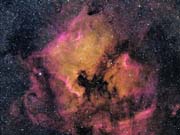 |
|
This area is very strong in Hydrogen alpha light which makes it difficult to show variations - in essence it should be all red! So for those who prefer a more restful image, here is the monochrome Ha Luminance image. |
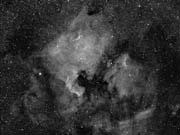 |
|
This beautiful reflection nebula, NGC 7129, approximately 3,300 light years distant in the constellation Cepheus contains bright young stars whose intense radiation has dispersed gas and dust creating a bubble in the original star forming cloud. Imaged from my Observatory, some of the luminance from September 2012, the bulk of the data this September 10th, one of the few decently clear nights this lunation. Luminance 12 x 20 minutes binned 1, RGB each 5 x 10 minutes binned 2x2. QSI 683 wsg camera with Starlight Xpress Adaptive Optics and Baader filters on Meade 12" ACF at 2600 mm. Larger Size (940KB) |
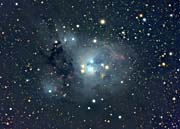 |
|
Very mixed weather lately here in NE England but 3rd April was obviously going to be the best from this part of the UK for this shot, so I travelled a few miles to a dark location with a clear low northern horizon near Redesmouth, Northumberland. With this result. The comet is now circumpolar, but by full dark was never above 11 degrees altitude and rapidly fell to 6. So even with clear air was in the murk. Those in the North of Scotland or Norway will get the best views. The tail is large and diffuse - interesting but disappointing in a way. Modded Canon 350D with 200 mm (old style M42 thread) lens at f8. 8 x 5 minute subs on my EQ3-2 mount, guided with a Lodestar and a 300 mm mirror lens. Stacked with Deep Sky Stacker, final processing in Photoshop. Cropped from the original to cut out amp glow in the corner. Amusingly one of my subs was ruined by what I assume was a passing Police car. Must have spotted my red head torch, stopped on the road outside the gate and pointed a spotlight straight up the lens! A frantic cry of 'Put that light out' was too late. They just drove on, but I have a nice white sub! |
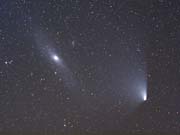 |
|
The imaging situation at home has been disastrous this winter, What a lousy season, particularly here in the North East UK. I started this image at the beginning of January. Then on 1st March got some more data. Nothing in between, due partly to other engagements on the rare occasions the sky was clear, and of course the almost total lack of clear nights anyway! Still just monochrome. And this target which is situated in Taurus just above the Hyades is soon going to have to wait until next season. It's dark nebula Barnard 22. Imaged 13 x 15 minute subs, QSI 683 wsg on TS65 Quad scope. So if we don't get a clear early evening before the Moon comes back, it's going to stay monochrome for a while! Larger size. |
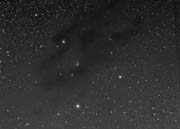 |
|
My annual spring stay at Kielder was blessed (!) with snow and cloud for most of the weekend. But Monday 11th March cleared for a few hours and I was finally able to obtain another luminance sub and colour data. RGB each 5 x 10 minute subs binned 2x2, QSI 683 on TS65 quad. |
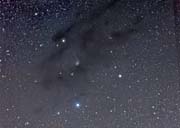 |
|
During my visit to Tasmania in February 2013 I had hoped to do some imaging of the deep Southern Milky Way and several of the interesting targets there. Alas the weather was unkind - despite wall to wall sunshine during the day every evening at the dark site clouded over after Sunset. I only managed 2 frames under clear skies one evening and this is the result. 15th February, 2 x 10 minutes (the second started to cloud over half way through - just visible as a haze around the SMC) using my Canon 350D and Tamron 17-50 mm f2.8 zoom lens at 17 mm and f5.6. Unguided on my EQ3-2 mount. The medium size image (click on the thumbnail) has 'mouseover' names for several objects. Larger image with names here. (I didn't notice the comet near the Small MagellanicCloud until June 2013!) This image appeared in the August 2013 issue of Sky at Night magazine. |
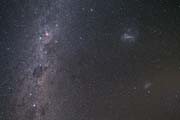 |
|
On 18th February there was an occultation of Jupiter by the Moon. Not visible in the UK, but I managed to observe and capture it from our location despite tree branches and clouds. I had to keep moving the mount to avoid branches, and unfortunately the focus shifted slightly so the field stars and moons of Jupiter are not the pinpoints of earlier but partially obscured attempts. But worth keeping! Canon 350D with Canon 400L Lens, single 2 second exposure at f5.6 and ISO 100. Just enough Earthshine to see the unlit part of the Moon. The star which has emerged from Occultation (top left) is 5th magnitude Omega Tauri. This image appeared in the April 2013 issue of Astronomy Now magazine. |
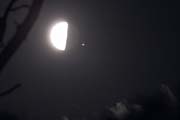 |
|
For the winter season 2112-13 The Sky at Night BBC TV program introduced a 'Moore Winter Marathon' suggesting numerous targets for both direct visual and telescope observation. Some of these were in Taurus, and since Jupiter was beautifully placed near the Hyades cluster I took this wide field image. Canon 350D at 40 mm focal length, 8 x 8 minutes at f7.1 in the early hours of 12th November. Click on the thumbnail for a larger image with 'mouseover ' names for some objects. Those with numbers after them are Moore Marathon targets. Full size (no names, 800 KB) This image appeared on the March 2013 'Sky at Night 'Magazine Disc Hotshots section, and a crop of the Hyades area featured on the January 2017 'Sky at Night' TV programme. And full size with names |
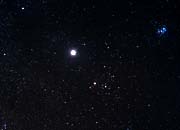 |
|
While at Kelling Heath, I purchased a Teleskop Service TS65 Quad refractor from Modern Astronomy. This little instrument has a built in field flattener. And it works beautifully! First light using the QSI 683 camera on 16th September was Messier 33 - the 'Pinwheel' Galaxy in Triangulum. Slight blurring of stars in the bottom left corner, but I suspect this may have been due to slight camera tilt - my next image, Barnard 142 above, is very satisfactory! I captured the Luminance at Kelling, but had to wait until back home for the colour information (captured after completing Barnard 142). Luminance 20 x 10 minutes, RGB each 7 x 5 minutes binned 2x2. |
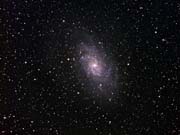 |
|
I already have a fairly wide field image of NGC7331 and close up of Stephan's Quintet in Pegasus, but not in the same frame, and during the 2012 Autumn Star Camp at Kelling Heath I decided to capture them using my QSI 683 and Meade 127 refractor, with this pleasing result. Numerous small distant galaxies visible on the full size image. I must get a close up of 7331 this season! 14th September 2012. Luminance 10 x 15 minutes, RGB each 7 x 5 minutes binned 2x2. Starlight Xpress AO unit also used for this image. |
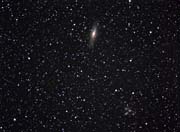 |
|
Several attractive prominences and some active areas with small spots on 2nd September 2012. Artemis 285 with Solarscope50 |
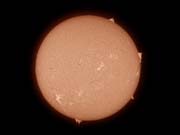 |
|
Over a week or so I'd been experimenting with my QSI 683 and Canon 400 f5.6L camera lens. I chose the Double Cluster (NGC 869 and 884) in Perseus for the rich star field to check the performance of the lens. I hadn't managed to get colour data due to clouds, but the night of 30th August 2012 was crystal clear, so despite the bright almost full Moon I had another go with this result. I did have to crop it a bit - over the different nights there was some misalignment, but in the original it was round stars almost to the edges. I used an external mask to reduce the f-ratio to approximately 7.1 - this prevents starburst which would otherwise occur due to the diaphragm blades. Luminance 18 x 2 minutes, RGB each 8 x 2 minutes. Full size (950 KB) |
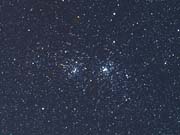 |
|
Some years since I imaged Messier 57 - the well known 'Ring' planetary nebula. So I decided to give the QSI camera a look, at full resolution on August 22nd 2012. Unfortunately the seeing was poor, but mild deconvolution improved the slightly misshapen stars and general detail. QSI 683wsg on Meade 12" at 3200 mm focal length. Luminance 12 x 5 minutes, RGB each 4 x 5 minutes. Close up (cropped from full size) |
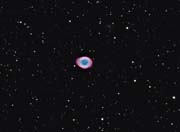 |
|
I've been after this for a while, and finally got it. Imaged over a couple of nights around 20th August - plagued by cloud, guiding problems and frost on the sensor! But eventually it all came together. The Cocoon nebula (IC 5146) in Cygnus with the 'tail' of dust and gas forming the dark nebula Barnard 168. QSI683wsg with Lodestar on WO ZS66 with WO 0.8 reducer, cropped to lose distorted corners.. Luminance 8 x 10 minutes, RGB each 5 x 5 minutes, all binned 1x1. Full size (1 MB) |
 |
|
What a dismal end to last season and a pretty dismal summer. But at last, with a decently dark sky albeit a last quarter Moon I was able to fire up my QSI and do some imaging. Two beautifully clear nights on 8th and 9th August - despite the Moon I could nicely see the Milky Way. Narrow band was the order of the nights, and I decided to go for NGC 7635 - the well known and much imaged Bubble Nebula in Cassiopeia. Not much imaged by me however, my last visit was 6 years ago! 16 x 10 mins Ha for Luminance, HOS Palette using the Ha and 5 x 10 mins each OIII and SII, all binned 2x2. QSI 683 on 12" Meade at 2600 mm. Full size |
.jpg) |
|
The beautiful weather at the beginning of June soon deteriorated, but we had a short stay booked in Venice. Even there although we had some long clear periods there were a couple of days which had thunderstorms for a few hours. On 12th June we had walked to the northern edge of the city to catch a boat to the Island of Murano, had to shelter on the way as a thunderstorm and torrential rain passed over, and arrived at the quayside just as a tornado from the same storm cloud hit the island of St. Erasmus about 3 miles away. The Island is predominantly agricultural and sustained severe damage to crops as well as buildings, boats and vehicles, but fortunately no one was seriously injured. This was the first tornado in the Venice area since 1970, when a vaporetto (water bus) sank with the loss of 21 lives. Panasonic TZ5, zoomed approx x5. I took a video with my camera after the stills. The funnel was starting to break up by then, but you get some idea of the scale as I zoom out. Lots of people stopped to take pics! This version of the video is much reduced in screen size but is still 4.4 MB, mp4 format. (The original high quality .mov file is 185 MB!) Here. |
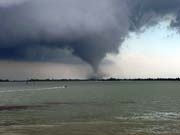 |
|
One from 18th and 21stMarch 2012, and my first Galaxy shot with my QSI camera. So far processed LRGB. I've got some H-alpha data, but need more, and later nights the seeing was atrocious - I can't remember when I've seen it so bad. Usually with a stable High it's good. Not that time - I don't know whether it was the jet stream or thermals from the ground in the cooling night after the hot day. Also screwing up my attempts to capture M95 >:( And now the Moon is brightening. What a terrible season it's been :( Anyway here it is. Messier 82 in Ursa Major. Luminance 21 x 10 minutes, RGB each 6 x 10 minutes, all binned 2x2. QSI 683 on 12" LX200R OTA at f8 with SX AO unit. Slight ovality on the stars. This happened a year or two ago (with a different camera) and I managed to get rid of it, but it seems to have returned. Specific to my 12", and appears on focus frames, so not a guiding problem. Sometimes altering the mirror lock tension and final mirror focus direction helps, but tricky. I guess I need to check the collimation, but with the seeing at the moment, no chance! Large size |
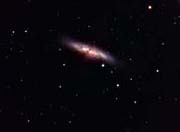 |
|
After a spell of inclement weather (at least for deep sky astrophotography with long exposures - too many occasional clouds, a clear late evening on 13th April 2012 gave me the opportunity to collect another 3 hours or so of Hydrogen-alpha data to add to the above and show the extent of the huge outbursts from this active galaxy. So with 14 x 20 minutes of H-a, here is the result. This image featured in The Sky at Night BBC TV programme, August 2012 |
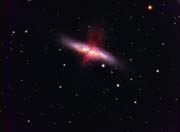 |
|
Mars becomes a bright object every 2 years or so, and March 2012 sees its closest approach of the apparition. Not particularly close this time around, reaching approximately 14 arc-seconds maximum size. Seeing is rarely good enough for me to obtain good planetary images, and the night of 5th March was no exception! But after capturing the colour data for Melotte 15 I gave it a go with this result. At least some surface features are visible as indicated. Toucam on 12" ACF with 3x Barlow, approximately 450 out of 900 sub frames combined. |
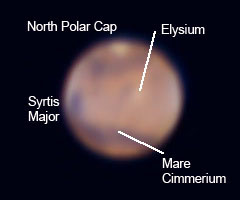 |
|
Still getting used to my QSI 683, and thought NGC 1499 the California nebula deserved attention to see what the little pixels could do for this large object in H-alpha. This version with a William Optics ZS66. Even with the WO Mk 2 reducer/flattener the edge stars are unfortunately distorted although it doesn't look too bad at a reduced scale. A clear night at first on 23rd January 2012, but a weather front was approaching, expected around midnight. Going from the Skymap chart I expected to get it all in comfortably at the reduced focal length of approx. 310 mm. Not so! Quite a bit missing. Maybe it's on with the WS cover and a 200 mm camera lens. Anyway I still need colour - the clouds rolled in earlier than expected, around 2230, so that was that. QSI683wsg, Baader 6nm Ha filter, 10 x 20 minute subs. Larger size |
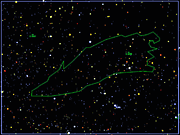
|
|
January 15th saw first light of my new QSI camera. Well, almost first light, a few tests on earlier nights to get my new kit up and running. I'm still struggling with reducer/flatteners - the chip distance from the front of the assembly is markedly different from my SBIG camera. But I'm sure I will prevail! Anyway, after weeks of terrible weather at last we had a fantastic clear frosty winter night. Pity the Moon rose around 11.30 pm. But before it did I managed to capture data for M45, and afterwards narrow band for the 'Jellyfish' nebula IC443 in Gemini. That one is still work in progress needs more H-alpha data (still a bit noisy) then OII and SIII to colour it. So. M45, Luminance 7 x 10 minutes (would have taken more but I'd been playing around with the configuration, and I needed to leave time for the RGB data before the Moon rose). RGB each 5 x 5 minutes binned 2x2. QSI 683 WSG-8 with Lodestar guide camera on Meade 127 refractor with William Optics 0.8 Mk II reducer. Large size |
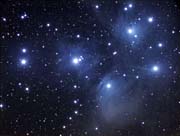 |
|
IC 443 is a Supernova remnant in Gemini, just East of 3rd. magnitude eta Geminorum. Although the magnitude is listed as 12, it is quite large at 50 x 40 arc-minutes, so the surface brightness is low, making it a difficult target in skies that are not completely dark. On 15th I got 10 x 20 minutes H-alpha. Same optics. Then on 16th I got a bit more Luminance and some colour of IC443. So here is the SHO (Hubble Palette) version. The halos round eta Geminorum are probably reflections between the filter and reducer - hardly surprising as it's a 3rd magnitude star! But not unpleasant IMHO 16 x 20 minutes Ha luminance, RGB each 7 x 5 minute binned 2x2 SII, Ha, OIII. Large size (660KB) |
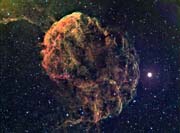 |
|
Here is Sharpless 199, the 'Soul' or 'Embryo' emission nebula in Cassiopeia, also showing the nearby smaller Sharpless 198 (below) and Sharpless 20 (left edge). The data was collected over 4 nights - notwithstanding narrow band the background was affected by moonlight, so I had to grab what I could before it rose too high. And of course our usual UK clouds limited the number of nights recently available. Final batch of data on October 19th 2011. SBIG ST-10XME camera, Canon 400L camera lens at approximately f7 with narrowband filters. Luminance 27 x 10 minutes Hydrogen-alpha, RGB each 7 x 10 minutes H-a, Oxygen III and Sulphur II. The camera lens was stopped down from f5.6 to approx. f7
using an external mask to prevent 'starburst' spikes. But if
I had not used the mask I expect it would have looked
something like this version - spikes added using Star Spikes
Pro. The lens produces 8 point spikes, (see here)
and on this occasion the artificial ones nicely mask those
produced by the microlenses on the CCD chip, so it is the
image I prefer. Full
size (850KB) |
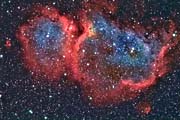 |
|
A bright supernova in Galaxy Messier 101 was first discovered on 25th August 2011 and brightened steadily over the ensuing weeks. I didn't hear about it until after I obtained the Comet Garradd image (below) - I would have been after the SN as well, although the weather would probably have stopped me! And no more clear spells at night until 10th September by which time an almost full Moon was washing out the sky. Still clouds about and the target heading rapidly behind a neighbour's tree (to be felled a week later - yesss!). But I managed 9 x 5 minute monochrome subs, ST-10XME on the Meade 127. Same framing as my image in March 2011, and I was able to add colour from that image and produce a 'blinking' GIF. But much lower in the sky this time and the moonlight produced a low contrast washed out image. Still time for another go after the Moon is out of the way. Not worth a full size image. The SN is classified type 1a, named SN 2011fe. It reached a brightness between 9th and 10th magnitude - extremely powerful at the distance of M101 - approximately 24 million light years. |

|
|
A little window of clear sky just after the Moon rose on17th Sept, so with darker sky around M101 a crisper image than a week ago, tho' still affected by moonlight. Next week with the intrusive tree gone and the Moon out of the way I'll try again for a better one, weather permitting! SBIG ST-10 with Meade 127 refractor, colour from my March image. 11 x 5 minute subs. |
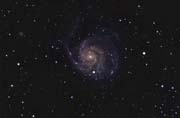
|
|
On 2nd September 2011 comet P1 Garradd was due to pass close to the 'hook' of Collinder 33 - the Coathanger asterism. But the forecast for that night (and those either side) was dismal, and unfortunately proved to be correct for my part of the country. However the weather did relent briefly on the evening of 30th August, and I was able to get a wide field image of the comet and Coathanger prior to the close encounter. 10 x 5 minute exposures with my Canon 350D camera and a 200 mm camera lens. Larger image. This image appeared in the Gallery section of the November 2011 Astronomy Now magazine, and again (cropped) in the April 2012 'Sky Diary' section |
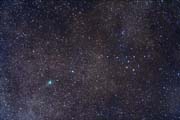 |
|
M71 in Sagitta was long a subject of discussion as to whether it is a globular or open cluster. But it would seem that the powers that be eventually decided it is a globular. Rather sparse, and not often imaged. BUT Comet P1 Garradd passed within 10 arc-minutes of its centre around 2300 UST (UK midnight) on Friday 26th August. A little to the right of the two bright stars at the middle of the left hand edge of this image. I was at the Dalby Forest star camp hoping for a clear night. Alas it was one of the wettest days and evenings of all the star camps over several years! But prior to that I realised I'd never myself imaged the globular, and the night of 22nd August 2011 was the first clear dark night for ages - at my latitude it was only then that I was back into full darkness, and there had been an awful lot of cloud around in recent weeks. With the presence of a bright last quarter Moon precluding faint fuzzies, and still limited time, I decided to image M71 to add to my collection. ST-10XME with AO-8 on 12" Meade LX200ACF at f7. Luminance 20 x 2 minutes, RGB each 8 x 2 minutes. Darks and Flats applied. North is left (I needed to position it that way for a bright guide star). Full size. |
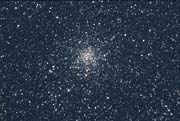 |
|
I was out imaging on 3rd. June, getting a test image of M63 following collimation problems with my Meade 127. At the time I hadn't heard about the supernova in M51, or of course that would have been my target! When eventually it came to light ;-) the clouds returned, and them along with a bright Moon on occasions when the clouds thinned put me well out of action. But a couple of reasonably clear nights on 28th and 30th June 2011, so at last I got SN 2011DH SBIG ST4000XCM on Meade 12" LX200R at f7. 8 x 10 minutes and 6 x 15 minutes. Of course at my latitude of 55 degrees, I get no better than Nautical twilight, so the image lacks contrast and despite a fair bit of processing is still a bit noisy. Not a patch on my early April image . Just think if the SN had happened 2 months earlier.... |
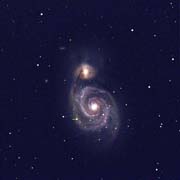 |
|
And here is an animated GIF showing the supernova blinking against the earlier image. (Click on the pic for full size). |
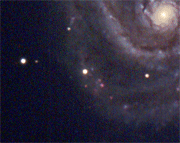 |
|
After a few days of very welcome cloud and rain, with twilight and a waxing Moon on a clear night on 8th April 2011, I decided to try for a decent image of Albireo, the beautiful double star in Cygnus. ST4000XCM of course to avoid blooming, and two different fields of view - one with the 400 mm Canon lens and one with the 12" Meade LX200ACF at f 10 (3m fl). Seeing was very poor, but the close up responded reasonably well to deconvolution. Wide field 22 x 1 minute subs, close up 30 x 1 minute subs. Full size close up This image featured in the June '2011 'Sky at Night' television program. |
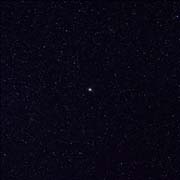
|
|
Magnitude 10.6 NGC 4651 (Arp 189) in Coma Berenices sports tidal tails both 'ends' of the galaxy, one in particular of a most interesting shape. I first saw an image of this here, and of course it prompted me to tackle it. What a struggle. I don't have New Mexico skies and 7000 feet of altitude! Although I had a run of fine weather, the nights towards the end of April 2011 were occasionally hazy, with only two or three really clear, and even then they sometimes clouded over early with an Easterly wind. And of course only 2 to 3 hours of full darkness to play with. Anyway, I eventually managed to capture 22 Luminance frames x 20 minutes and 6 each RGB x 10 minutes binned 2x2. SBIG ST10XME on 12" LX200ACF with AO-8 at f7. Some had to be scrapped due to passing cloud. And it seemed to be Clapham junction for bright satellites - no less than 3 Luminance and 3 colour subs were badly affected. And the tails were so faint that to show them meant a noisy final image and patchy colour. When I think of all the nice bright targets around....But here it is (full size), and one of the satellite subs (calibrated and reduced of course). |
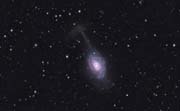
|
|
The last time I imaged the globular cluster Messier 3 in Canes Venatici was in June 2003 with my MX716 camera. Long overdue for a re visit. And the night of 12th April 2011 was nice and clear, so despite the brightening Moon the contrasty bright target wasn't unduly affected by the Moonlight. And a pleasant change for me from trying to tease out invisible structures around faint galaxies! SBIG ST-10XME with AO_8 on 12" LX200ACF OTA at f10. Luminance 12 x 5 minutes, RGB each 6 x 5 minutes. Full size This image appeared in the Astronomy Now June Facebook gallery |
 |
|
Alas light nights are fast approaching in April, particularly at my 55 degree latitude. The end of April is the last string of full dark nights (and then only for 2 or 3 hours) until the end of August. (Early August only an hour or so for a handful of nights). So unless the end of the month has some clear nights, that's the end of faint fuzzies for me for some time. But the night of 7th April 2011 was looking pretty good as the early high haze gradually faded. And I went for a very interesting galaxy, the starburst NGC 3310 (Arp 217) in Ursa Major. Almost at the zenith, so a good opportunity. Inspired by Adam Block's superb image, I set to. OK, I don't have a 32" 'scope, 9000 feet of altitude and Arizona sky, so can't really compete. But disappointingly the seeing was only around 5.5 fwhm, and even more annoyingly before I got any colour data, at 2 am the clouds rolled in. Scotland got some, there was a big fat one right over me. But the rest of England, Wales, Ireland, France and Spain were pristine. I don't beleeve it!! So I guess it's work in progress until early 2012. Anyway, here's what I did get. Not worth posting the full size. There are also some large 'doughnuts' in the image, possibly due to the bright 5th magnitude star out of frame at the top of the picture. It was an excellent guide star for the dual chip camera, but may end up ruining any chance of a better image. SBIG ST-10XME with AO-8, 12" LX200ACF at f10 on Gemini mount. 12 x 15 minute subs. |
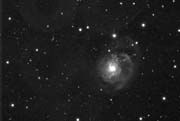 |
|
Added later! Fortunately the weather at the end of April relented, and over 5 nights I was able to get a lot more data for this interesting galaxy. Seeing improved, and although the sky was a little hazy on the night I obtained the colour frames, it came out ok - the bright starburst regions shone through the murk! Still slightly 'noisy', but that's the UK skies for you! The faint blue arc at the top of the image is definitely down to the bright star (a great guide star!) out of the frame. Luminance 12 x 15 minutes + 16 x 20 minutes. RGB each 6 x 10 minutes binned 2x2, optics as above. Full size This image appeared in the Astronomy Now June Facebook gallery |
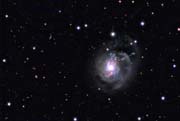 |
|
The 2011 Kielder Forest Spring Star Party took place over the weekend 5th/6th March. I was staying a few miles South at Calvert Trust, and unfortunately the Saturday night was clouded out. Sunday and Monday nights saw a few hours of clear skies, but with thickening freezing mist and occasional passing clouds. I only tried to image one subject, using my SBIG ST4000XCM on M101 through my Meade 127 refractor. The hope was to well define the faint extensions, hence the use of the 127 for the wider field of view. But the haze affected the contrast, so not as clear as I'd hoped. Heigh Ho... Anyway here it is, 15 x 20 minute subs. Full size |
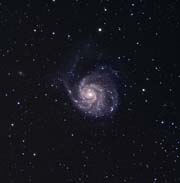 |
|
What a beautiful night on Sunday 13th March 2011. Wonderfully clear - a sky full of stars. Typical of course that it should be accompanied by a bright first quarter Moon. If only we'd had those conditions the previous Sunday at Kielder! I was out earlier, but when I got home set to with my ST-10 to get some luminance data, the idea being to use the colour from the Kielder one-shot-colour effort above. And despite the bright Moon it came out quite well, helped by the excellent conditions and the position near the zenith. There's a pretty circlet of stars bottom right corner which I'd never noticed before. Luminance 13 x 10 minutes with the ST-10XME, colour 15 x 20 minutes with the ST-4000XCM in the misty condition last weekend at Kielder. All with the Meade 127 refractor. Full size |
 |
|
This is the result of a challenge by Paul Jenkins! Small, faint and green. No, not Paul, but this interesting object next to the mag. 15 galaxy IC2497, beautifully imaged by the Hubble ST. And with more time I daresay I'd have a better image. But this will have to do for now. 26th February 2011. ST-10XME with AO-8 on 12" LX200ACF OTA at f10. 9 x 20 minutes Luminance, RGB each 4 x 10 minutes. A bit of passing cloud for some of the colour frames. Nice bright guide star, so the Luminance AO-8 rate was 11Hz - helped to overcome mediocre seeing. Full size. Full size crop, North is up, Need darker steadier skies and lots more time. In England? - fat chance! This image appeared in the May 2011 Astronomy Now magazine Gallery, and again as the April 2012 issue 'Deep Sky Challenge' |
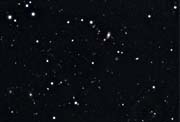
|
|
When I'd finished messing about with my earlier offering below of a wide field Orion, I got to wondering how my modded Canon 350D would cope with the subject. So while out on the evening of 8th February 2011, I left it running unguided on my EQ6 mount for a couple of hours with this result. I'd felt the slightly smaller pixels might resolve the stars better than the SBIG ST-4000XCM, but there's nothing in it - the SBIG version looks more fussy simply because more background stars are visible! I'd intended to image at ISO800, but in fact (I was in a hurry and didn't check!) ended up with ISO 1600. 14 x 10 minute subs, same Tamron 17-50 f2.8 lens at approx 30 mm, f5.6. Dark frame subtracted of course, and it was pretty cold, so not much noise anyway. Considering the SBIG was cooled to -30 deg C and I used 15 minute subs for that pic, I think the Canon has acquitted itself quite well. But IMHO the dedicated camera wins - so it should for the money! Again used StarSpikes Pro to bring up the main stars. Full size (2 MB!) Still those dratted power line shadows. I don't think I'll get another proper chance this year. Maybe next year if I and the world survive . |
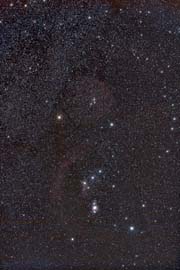 |
|
The BBC 'Sky at Night' programme broadcast at the beginning of February 2011 put out a request for images of Orion. I submitted images, some of which were used along with old favourite Milky Way from La Palma to show the Scorpion - Orion's nemesis in mythology! But I didn't have a suitable image of the whole constellation, and bad weather prevailed for the 'window' available to submit. However a clear night on 30th January gave me a chance. I had to scrap some subs due to passing cloud and light pollution, but here is the result from my back garden. 13 x 15 minutes, SBIG ST-4000XCM with Tamron 17-50 f2.8 zoom lens at 30 mm and f5.6 . Unguided on EQ6 Pro mount. Full size (1.2 MB) Spikes added with Star Spikes Pro to enhance the main constellation stars. Despite combining many frames, still a hint of the power lines which cross my South field of view. Maybe I'll try again from a darker unobstructed site. This image is featured in the Jodrell Bank Radio Telescope introduction brochure. The second frame taken, although not used because of the trail, showed what at first looked like a meteor. But on closer examination after processing probably an Iridium Satellite because the trail extends faintly for the whole frame. And there is a second trail almost paralleling the first. The start of the 15 minute exposure was 19:05.00 on 30th January give or take a couple of seconds. Full size And a visit to the Heavens Above site confirmed that they were indeed Iridium satellites, 91 and 52, with almost identical positions and only 67 seconds apart - apparently 91 is a spare with 52 active. Details here. A few days later I managed to fit a Hydrogen-alpha filter (Baader 7nm) into the camera lens, and before the weather deteriorated acquired a single 15 minute frame, binned 2x2 to prevent Bayer patterning from the one-shot colour chip. Although desperately noisy, by the time I'd played with it, dimmed and blurred the stars it was worth a try at blending with the Red channel in the original image. And it's a bit better - the nebulosities are brighter and the star colours haven't been affected. It would have been nice to get several frames, but the way the weather was looking, not very promising. And by next month it's getting too late in the year. Anyway the dratted power line shadows really urge me to make a completely fresh start from a different site. Another time. Full size (1.3 MB) LATER. Look closely at Betelgeuse and you can see a faint bell shaped dusty outline surrounding it. This is known as Pickett's Bell, Named after Tom Pickett who posted an image on Facebook in November 2015. See here. See also the Canon 350D version |

|